HR Business Plan Template: Everything You Need to Know
With an HR business plan template, you can help your company recruit new employees, retain existing employees, and guide the development of the workforce. 4 min read updated on February 01, 2023
With an HR business plan template, you can help your company recruit new employees, retain existing employees, and guide the development of the workforce so that you collectively meet your business objectives, regardless of any changes in the industry or economy.
When creating your HR business plan, you need to perform a needs analysis of your workplace to tailor the plan to your company's requirements. You'll also need to learn about the industry standards for your field to make sure you're competitive.
Without such a plan in place, your workers will feel unprepared and won't know how to work towards your company's overall goals.

Steps for Developing a Human Resources Department Business Plan
There are several steps to creating an HR business plan. They include:
- Clarify the requirements . While you might be tempted to create a detailed plan that encompasses the entire company's next 10 years, hold off. Always talk with your boss to see how much detail he or she would like in the plan. This will save you time and help streamline the process. However, there's no harm in creating your own personalized strategic plan for your specific department.
- Read through the HR job descriptions . The HR department typically has employees such as HR assistants, HR generalists, and an HR director . Read through the job descriptions for each worker in the department and see what kind of duties are missing. Brainstorm additional functions that each job role could provide to the company.
- Curate your list . Take the different functions you've brainstormed and compare them to what each member of the HR department is already doing. Are there functions you could add or subtract from each employee for more productivity? You don't have to go into detail here, but just think about how you could improve each role.
- Schedule a meeting with the executives . Before you make any changes, you'll obviously need to get input and approval from the company's executives. They may have more feedback on how the HR department can provide additional services and support the company's overall goals and mission.
- Create a feedback form . Come up with a list of questions to ask leadership about HR's role in the company and provide it to them in advance of the meeting so they have time to think it over and talk with their staff. You may even want to provide a rating and ranking format for the questions, as this will make their responses easy to understand and implement. Overall, this is a key process to understanding what management and employees want and need from the HR department.
- Look at external resources . While the internal information you're collecting is the most important, it also doesn't hurt to take a look at data from professional organizations and websites, such as the Society for Human Resource Management , The Balance , or HR Magazine . You can also ask colleagues from other local organizations for tips on creating your business plan.
- Use this information to make a plan . With your ideas, feedback from executives, and tips from external resources, you should have a clear idea of what your plan should look like. The things that are missing from the HR department should now be clear, and this should guide you on what to focus on to improve HR's contribution to the company.
- Identify goals for this year and next . While your plan can have long-term goals, keep the majority of them a little bit shorter in scope to see how things work out. This gives you the chance to reorganize and restructure if things aren't going right. Consider creating a list of accomplishments you can reach for the end of this year and into the next.
A Real Life Example
If you're seeking more guidance on how to create a successful HR business plan, look to Starbucks as an example.
As the world's largest coffee chain, Starbucks had $21.3 billion in sales in 2016.
Despite these massive numbers, Starbucks maintains the same approach to their human resources department. All of the HR planning is guided by the company's organizational strategy and brand.
Their strategy is to use specific interview techniques when hiring new employees. This lets them identify potential leaders and place them in a "New Partner Orientation and Immersion" training program. With this system, Starbucks has achieved the lowest employee turnover rate in the quick-service restaurant industry.
Starbucks also offers numerous employee perks and dedicates a lot of time to employee training through an online portal that teaches employees essential job skills.
If you need help with your HR business plan template, you can post your legal need on UpCounsel's marketplace. UpCounsel accepts only the top 5 percent of lawyers to its site. Lawyers on UpCounsel come from law schools such as Harvard Law and Yale Law and average 14 years of legal experience, including work with or on behalf of companies like Google, Menlo Ventures, and Airbnb.
Hire the top business lawyers and save up to 60% on legal fees
Content Approved by UpCounsel
- HR Compliance
- SPHR Certification
- Human Resources Management
- LLC Business Plan Template
- Details of a Business Plan
- Business Plan Management Structure: What You Need to Know
- CCP Certification
- Service Business Plan
- Creating a Business Plan
- Search Search Please fill out this field.
- Building Your Business
- Becoming an Owner
- Business Plans
Management and Human Resources Business Plans
The management portion of your business plan, the hr portion of your business plan, frequently asked questions (faqs).
As a startup, it’s never easy to come up with a business plan, let alone the management and human resources sections of a business plan. Despite that, it’s important that you start your business plan for human resources as soon as possible. Doing so gives your management goals a plan that will guide you and keep your business on track as it grows.
The key components of your human resources business plan should include your organizational structure, the philosophy and needs of your HR department, the number of employees you want to hire, how you plan to manage them, and all the estimated costs related with personnel.
You’ll want to start your HR business plan by outlining your own managerial experience and skills as well as those of your team. Highlight the roles of each member of your team, and any particular areas of strength or deficiency in your personnel lineup. For example, your HR team may be strong in compliance and conflict resolution but weak in hiring.
Don't worry if you don’t have a complete team in place when you write your HR business plan. Simply use this section to outline the organizational structure along with job descriptions, how you plan to recruit key team members, and what their responsibilities will be.
This section should look like a pyramid with you at the top and will likely have lateral positions. Be as specific as possible when defining an employee's responsibilities because this is what will drive your business.
Do You Need an HR Manager?
If you’re a solo practitioner, you may not think of including an HR manager in your management business plan. However, if you expect to hire non-managerial employees (such as salespeople or clerical workers), you should consider recruiting a human resources manager.
If hiring a human resources manager can’t be done, consider a human resources consultant. Human resource management requires an immense amount of time and paperwork, and an experienced HR consultant will be able to quickly get your payroll and benefits program up and running, affording you more time to concentrate on growing the business. Human resource responsibilities should include:
- Handling FICA and unemployment taxes and paperwork
- Ensuring compliance with the Family and Medical Leave Act
- Staying on top of IRS filings
There are plenty of companies that offer HR management platforms tailored to each business's needs. Research these companies and be sure to include their estimated cost in your HR business plan.
When you develop the HR portion of your business plan, begin by including a brief overview of your HR strategy. Investors may be curious about how your payroll will be handled and the associated costs of administering it, as well as the type of corporate culture you plan to create. Specific items to highlight in the HR section include:
- Payscale: Show the salaries for managers and non-managers based on the market for those jobs.
- Vacation time: Describe your vacation-time policy. How much time do employees get? How quickly does it accrue? Vacation time is not required by law, but most firms offer vacation time to stay competitive and keep employees refreshed.
- Insurance: Health insurance is a common staple benefit, although skyrocketing prices have forced many firms to cut back on this benefit. If you can’t afford a health plan, look into subsidizing one with employees paying the rest. Alternatively, inquire if a professional insurance representative can help you get a bulk rate.
- Additional benefits: Other things to consider include life insurance, a 401(k) and matching funds, bereavement leave, religious and floating holidays, and a bonus structure, if applicable.
In addition to the key elements above, it helps to have a framework from which to build your HR business plan. Here’s a basic outline that can help you get started:
- Figure out what your human resources department would need.
- Determine a strategy for recruiting talent.
- Formulate your hiring process.
- Develop a training program for new employees.
- Determine how much you want to pay your team (this is a good spot for payscale info)
- Create performance standards
It may be overwhelming to contemplate these benefits and their costs in the early stages of setting up your business, but in a competitive labor market, your firm needs to offer enough to entice qualified people and, more importantly, to keep them happy.
Consider revisiting your management and HR business plans every couple of years to see if you need to create action steps to refine your processes.
What should be in an HR business plan?
An HR business plan should include a mix of the steps you plan to take to launch an effective HR department, as well as specifics about how you plan to handle time off, insurance, and other benefits you plan to offer.
How do I write a human resources plan?
It helps to start with a simple framework. Try to break the plan down into sections: HR needs, recruitment, hiring, training, pay, and performance reviews. From there, incorporate other aspects of HR, like benefits and promotions.
U.S. Chamber of Commerce. " Does Your Small Business Need an HR Department? "
University of Minnesota. “ Human Resources Management: 2.2 Writing the HRM Plan .”
Mecklenburg County, North Carolina. “ FY 2020-2022 Strategic Business Plan: Human Resources .”
We use essential cookies to make Venngage work. By clicking “Accept All Cookies”, you agree to the storing of cookies on your device to enhance site navigation, analyze site usage, and assist in our marketing efforts.
Manage Cookies
Cookies and similar technologies collect certain information about how you’re using our website. Some of them are essential, and without them you wouldn’t be able to use Venngage. But others are optional, and you get to choose whether we use them or not.
Strictly Necessary Cookies
These cookies are always on, as they’re essential for making Venngage work, and making it safe. Without these cookies, services you’ve asked for can’t be provided.
Show cookie providers
- Google Login
Functionality Cookies
These cookies help us provide enhanced functionality and personalisation, and remember your settings. They may be set by us or by third party providers.
Performance Cookies
These cookies help us analyze how many people are using Venngage, where they come from and how they're using it. If you opt out of these cookies, we can’t get feedback to make Venngage better for you and all our users.
- Google Analytics
Targeting Cookies
These cookies are set by our advertising partners to track your activity and show you relevant Venngage ads on other sites as you browse the internet.
- Google Tag Manager
- Infographics
- Daily Infographics
- Popular Templates
- Accessibility
- Graphic Design
- Graphs and Charts
- Data Visualization
- Human Resources
- Beginner Guides
Blog Human Resources 6 Steps to Create a Strategic HR Plan [With Templates]
6 Steps to Create a Strategic HR Plan [With Templates]
Written by: Jessie Strongitharm Aug 25, 2022

The backbone of any successful business is the people and processes behind it — that’s why creating a human resources (HR) plan is key. This strategic document drives your business forward by evaluating where your workforce is at, and comparing it to future needs.
Without an HR plan, organizations can suffer from issues that would have otherwise been avoided. From productivity pitfalls to costly employee turnover, there’s no shortage of risks you can sidestep if you do human resource planning in advance.
Not sure where to start? No worries. I’ve outlined six steps you can take to create an effective HR plan that ensures your organization is well-staffed and well-served. You’ll also find a variety of HR templates that you can customize in just a few clicks — no design expertise required.
Click to jump ahead:
What is human resource planning?
- Assess employees’ current skill levels
- Forecast your labor needs based on available information
- Revisit your organizational design
- Outline how you will manage, motivate and retain talent
- Align your workforce planning with your budget
- Establish KPIs for your human resource planning objectives
Human resource planning is the process of considering the current and future “people needs” of an organization.
This involves evaluating an organization’s workforce structure and protocols to ensure operational goals are met, productivity stays high and future demands for labor and talent can be fulfilled.
The result of this process is the creation of an HR plan, which typically takes the form of a written document sometimes autogenerated using HR software . These documents tend to follow a similar structure to most strategic business plans and are created on an annual basis, by HR managers or company leaders.
Check out the template below for an example.
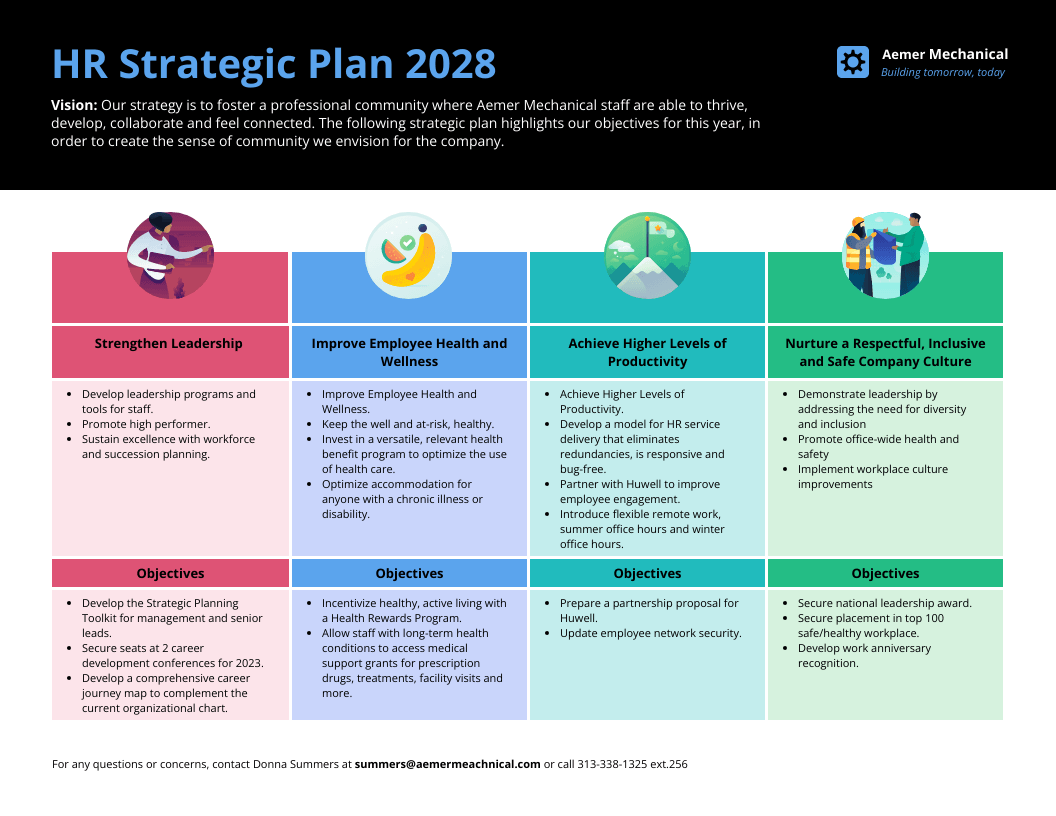
This eye-catching, one-page HR Strategic Plan Template offers a concise summary of your human resource planning efforts, so you can easily share info with colleagues.
Just swap out the text and visual assets for those of your choosing in Venngage’s editor , and you’re off to the races.
6 steps to create a strategic HR plan
Ready to create a strategic plan for the human resources that power your business? Here are six steps to help you succeed at the human resource planning process.
1. Assess current employees’ skill levels
The first step to creating a future-forward HR plan is to assess employees’ current skill sets, and compare them to your operational needs moving forward. This will help you identify gaps and inform any hiring of new employees.
Employees’ skill levels can be assessed by reviewing their work history, hard and soft skills and professional growth over time.
Using a matrix is a great way to understand where the skill gaps in your current workforce exist. Below is an example that describes the skills needed for different marketing roles.
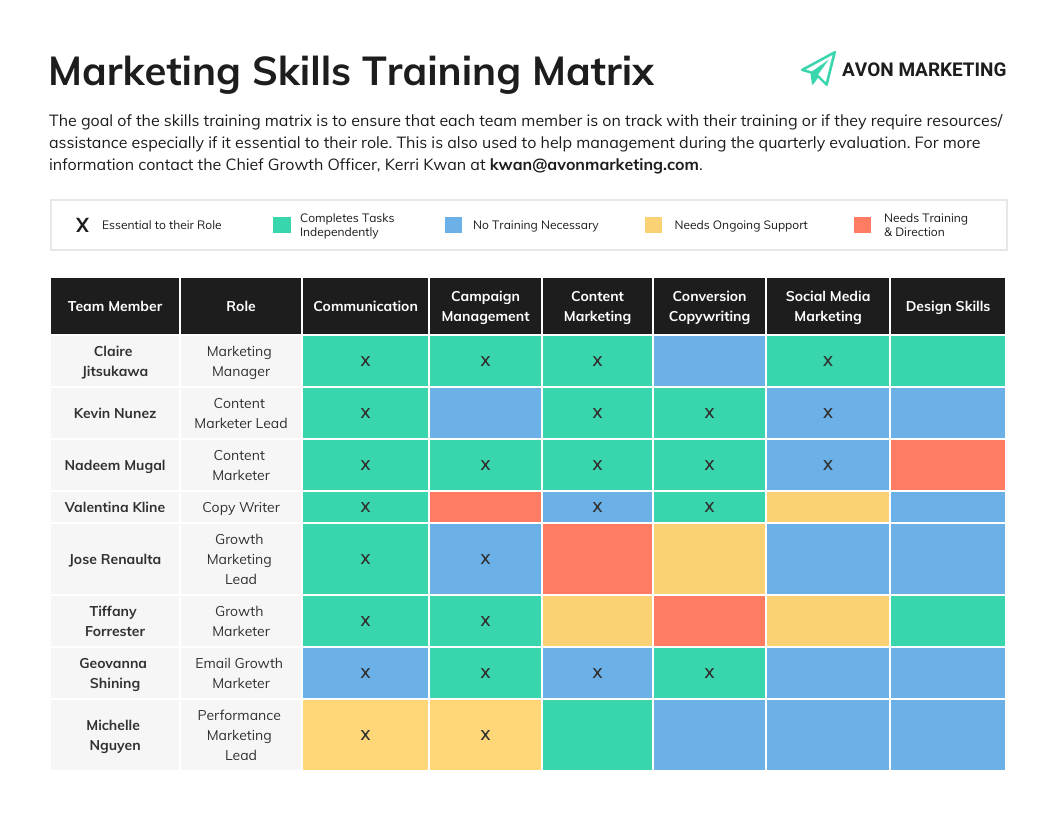
Don’t need it for marketing specifically? No worries — you can fully customize this template by swapping in your own text to examine any human resource gaps.
Another way to assess skills is by giving employees a questionnaire they can fill out. This Employee Competency Assessment Template does just that.

Based on the information collected, you’ll get a sense of what positions best suit each individual, and whether any upskilling or hiring is required.
2. Forecast your labor needs based on available information
Next in your strategic strategic HR management plan, you’ll want to consider the future. This involves accounting for any upcoming changes to your workforce, so operations can continue without error.
When forecasting labor needs, the following should be considered:
- Planned promotions
- Upcoming retirements
- Layoffs
- Personnel transfers
- Extended leaves of absence (i.e. maternity/paternity leave)
Beyond those, it’s a good idea to assess the impact of external conditions on your labor needs during your human resource planning. For example, new technological developments may decrease the amount of employees you require to operate your business.
3. Revisit your organizational design
Organizational design is the process of structuring the way a business operates so it can best achieve its goals. This is hugely important when it comes to your human resource planning process!
With a clear understanding of your organization’s strategic objectives in mind, reviewing your organizational design allows you to understand the staffing requirements you’ll need to succeed at them. This means taking into account your organizational structure and chains of command, as well as how work gets done and the way information flows.
From there, you’ll be able to see which departments need more team members so it can accomplish the organization’s objectives.
An easy way to get started is by using an organizational flow chart.

With its color coding and layout, even a new manager can quickly look at this chart to identify the people responsible for leading teams and making decisions.
And if there are any changes, it’s easy to to reflect them in the chart itself. All you need to do is customize the text and visual assets in Venngage’s Chart Maker as desired.
Not quite your style? There’s plenty of other organizational chart templates to choose from.

Here’s an organizational chart that’s perfect for small businesses that have limited employees. One quick look, and you’re good to go.
The bottom line is, no matter how big or small your business may be, you should always revisit your organizational design to optimize your workforce management and business operations.
Related: Types of Organizational Structure [+ Visualization Tips]
4. Outline how you will manage, motivate and retain talent
In this day and age, it’s a known fact that companies must provide more than just a paycheque to attract and retain talent, and encourage growth.
It’s true — studies have shown employees are more engaged in their work when they feel it is meaningful, fulfilling and slightly challenging. So your human resource plan should consider how to inspire such feelings, and what actions you can take to motivate employees to stay. (Hint: a strong HR training and development program is key.)
The talent management infographic template below is a great way to begin.

Using this process chart , you can detail the steps you’ll take to retain the talent you have. Reference it as needed in your human resource planning.
Another great way to keep staff motivated and geared towards their professional growth is by coming up with ideas for employee development . Facilitating a company culture that champions continuous learning guarantees your team will feel supported and challenged in all the right ways.
The two employee development plan templates below will help you do just that.

Though both templates are geared towards healthcare organizations, it’s easy to customize their content in Venngage to promote the continuous learning and development of employees in any industry.
As a result, your employees will be able to reach their full potential, while simultaneously supporting the long-term goals of your organization.
Related: 6 Employee Development Ideas for Efficient Training
5. Align your workforce planning with your budget
Let’s face it, human resources ain’t cheap.
Meaning, if you struggle at organizing and monitoring your HR budget, you’re bound to overspend on your initiatives —and no financially savvy business wants that.
That’s why I recommend including financial information in your HR planning process, so you can reference your budget and expenses as needed. This includes not only hiring and training costs but also the complexities of managing a global payroll for diverse teams.
Ensuring this allows you to stay within range as you work towards achieving your strategic goals for human capital . Plus, you don’t need to use one that contains walls of text and wack-loads numbers. Check out the clean and cheery option below — it’s as easy to fill out as it is to understand.

And if you’re looking to compare a forecasted budget to previous annual spending when strategizing your HR budget, the Budget Comparison Infographic Template below will help.

The bar graph is a great data visualization of annual expenses, organized by category. Just add (or import) any values to Venngage’s editor, swap out the text, and you’re ready to compare with ease.
Related: 10+ Expense Report Templates You Can Edit Easily
6. Establish KPIs for your human resource planning objectives
Measurable results are important when it comes to your HR planning processes, because they indicate whether your strategy is working or not.
Keeping those metrics in mind, your company can make adjustments and improve upon any future plans — AKA strategize for future success in business. That’s why your human resource plan should include info re: the specific key performance indicators (KPI) you’ll be measuring.
KPIs are established to help determine if HR strategies and plans are working. Much like those used for evaluating the performance of marketing or sales plan , KPIs for human resources are measurable results that indicate an organization’s success at achieving predetermined goals.
These may take the form of headcounts, turnover rates, demographic information, time to hire and employee satisfaction scores.
Here’s one employee satisfaction survey you can use to understand your workforce better.

When you’re ready to organize those HR KPIs in a document, the recruiting template below is perfect for keeping tabs at a glance.

Related: 10+ Customizable HR Report Templates & Examples
How do I make an HR plan?
After you’ve collected the data you need, you’ll want to convey this info in an engaging, professional manner for easy referencing and sharing amongst colleagues. Given this, using Venngage is the best route to go.
Here are the simple steps to help you bring an actionable HR plan to life:
- Outline the information you would like to include in your strategic hr plan
- Pick the human resource planning templates that best suits your needs
- Customize the templates’ text and visual assets so they speak to your organization
- Apply your company’s brand guidelines with a few clicks using Venngage’s automated branding feature, My Brand Kit
- Download and share as desired
Note: sharing is available free-of-charge. However, the option to download your creations and access features like My Brand Kit and Team Collaboration are available with a Business plan .
FAQ about HR plans
How long should an hr plan be .
There are no hard and fast rules when it comes to the length of an HR plan. That being said, if you’re going to share it with colleagues, you probably don’t want to create a 20+ page document. One to five pages should suffice.
Try to be as concise as possible when relaying the facts, and use data visualizations wherever possible to save room.
Do I need an HR contingency plan?
In the same way creating an HR plan is a proactive move that helps your organization account for future needs, it’s a good idea to devise an HR contingency plan. This ensures there’s a back-up plan in place should your initiatives not go as expected.
For example, if you’ve identified that you need five new hires to keep up with consumer demand, but the talent pool is lacking, a contingency plan could house suggestions for restructuring your workforce to mitigate this.
In other words, it’s best-practice to hope for the best, but prepare for the worst.
Is an HR plan different from an employee development plan?
Yes. While an HR plan is a strategic document describing how an organization addresses its personnel-related needs at a high-level, an employee development plan outlines the processes needed to help an individual achieve their professional goals.
Even though the human resource planning process may involve outlining some employee development tactics, it is not unique to each employee as in the case of an employee development plan.
Make your HR planning processes effortless
You don’t need a crystal ball to feel confident about your people moving forward. With a solid HR plan and strategy in place, you’ll prime your workforce — and all business endeavors — to succeed in even the most competitive of markets.
Just remember this: human resources planning, and creating strategic business plans in general, doesn’t have to be exhausting.
With Venngage’s huge selection of professionally-designed templates and easy-to-use editor, all it takes is a few minutes to produce a polished document perfect for all your needs. Sign up for free today !
Discover popular designs

Brochure maker

White paper online

Newsletter creator

Flyer maker

Timeline maker

Letterhead maker

Mind map maker

Ebook maker
Use Human Resources Planning to Forecast for (Less) Risky Business
By Becky Simon | October 18, 2017 (updated July 21, 2021)
- Share on Facebook
- Share on LinkedIn
Link copied
No organization can afford the risk of a critical skills shortage. Human resource planning (HRP) helps to ensure that you have the right people on your team - those with the skills to compete, innovate, or grow your company.
How do you anticipate workforce needs in a business environment where the rate of change is increasing while the number of people with the right skills is shrinking? The answer is human resource planning. In this article, five experts share their perspectives on what’s needed to operate comfortably in rapidly changing times. While human resources (HR) forecasting isn’t an exact science, you’ll find ideas and processes, examples, and templates that you can use to forecast more confidently, manage operations, and take control to increase current and future profitability.
What Is the Meaning of Human Resource Planning?
Human resource planning, also known as workforce planning , helps organizations recruit, retain, and optimize the deployment of people needed to meet strategic business objectives and to respond to changes in the external environment. In order to proactively avoid talent shortages or surpluses and achieve a balance of talent based on need, effective human resource planning is an ongoing, systematic process.

Darrin Murriner is the author of Corporate Bravery , a field guide to eliminating fear-based decisions, and the Co-founder of Cloverleaf.me , a technology platform that helps business leaders and managers build thriving teams.
He says, “Human resource planning and organizational strategy connect at the hip. You can't deliver business strategy without making sure you have the right human capital you need in the right places for the task at hand.”
Smart companies get the human capital part right by implementing a tactical human resource plan that connects directly to organizational and human resource strategies.
Starbucks: Serving Up Human Resources Planning Derived from Mission and Strategy
Starbucks, the world’s largest coffee chain, recorded $21.3 billion in sales for 2016, ranking it at 131 on the 2017 Fortune 500. The company projects that it will reach $35 billion in sales by 2021 by opening 12,000 stores over the next five years , the majority of them in China. How do you plan human resources with such a massive growth goal? For Starbucks, their approach remains the same no matter where stores are located. Their human resource planning flows from its organizational strategy and its brand. People are Starbucks’ primary resource, as their mission clearly states: "Our mission: to inspire and nurture the human spirit – one person, one cup, and one neighborhood at a time."
An important aspect of Starbucks’ human resource planning is its selection process, which uses specific interview techniques to determine if potential employees are ‘on brand’ and evaluate their skill sets. The company identifies capable company leaders and hires them using a program called "New Partner Orientation and Immersion." This human resources planning approach has led to the lowest employee turnover rate among quick-service restaurants. While most quick-serve restaurants range between 150 to 400 percent turnover, Starbucks’ rate is 65 percent . The company is always on the lookout for new employee perks and focuses energy on employee training, which includes an elaborate online portal that offers an instruction program imparting the necessary job knowledge.
The Difference Between Strategic Human Resources Planning and Human Resources Planning
“The war for talent around the world continues to grow.” says Matthew Burr, Moderator of the Upstate HR Podcast and Principal at Burr Consulting, LLC , a human resource consulting firm focused on small and medium organizations. To win the human capital competition, companies should use a strategic human resource plan as a roadmap to achieve three- to five-year goals. Strategic plans influence the development of tactical resource planning (Starbucks being a prime example). For example, a human resources strategic plan may include long-term aims to recruit and retain an excellent staff with a high-level of technical expertise. The tactical plan would include detailed action plans with completion due dates. For the strategic recruitment goals, the tactical program might consist of short-term goals, such as benchmarking salaries via survey data, or creating a social media campaign to identify and recruit technical professionals. The plan may also target filling IT positions through international recruiting.
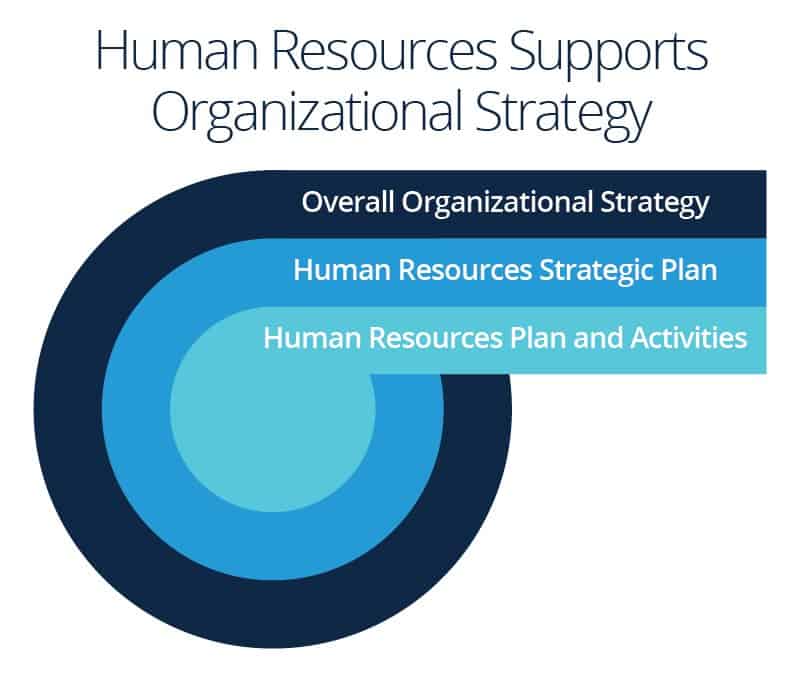
Both strategic and tactical human resource plans support the overall organizational strategy. To learn more about strategic human resources management, read Welcome to the HR Revolution: Strategic Human Resources Management .
Why Is It Important to Plan Human Resources?
Our world is increasingly one of swift technological change, constant product innovation, economic globalization, and generational and cultural shifts. Correspondingly, the life cycles of business designs and products are shortening. Companies must adapt. More than physical or financial capital, human capital efficiently adapts to this new reality. Simultaneously, human capital is at most significant risk of depreciation or obsolescence within a business — and that’s a risk that organizations can’t afford if they’re going to survive and thrive. In fact, only 12% of firms that were on the Fortune 500 list in 1955 remain on the list in 2016.

“Talented people will always have options; Knowing succession plans, training, leadership development will be a tremendous asset to a growing firm,” adds Burr. “HR planning is critical to organizational strategy: We need subject matter experts and leaders to drive the strategy forward in evolving industries. HR planning plays a significant part in supporting strategy, as human resources are the biggest investment for any organization. Evolving laws and regulations also impact strategy internationally. Staffing levels, recruitment and retention programs support scalability of any firm or organization.”

Handrick says it’s all about planning for future growth. “Small businesses that are planning to open a physical or second location also need to think through their HR strategy. Most small businesses begin as sole proprietorships. They need to know when it makes sense to bring on staff, where that staff will work, their compensation, and how to offer benefits, perhaps by partnering with a professional employer organization (PEO).”
- Improving Company Operations: Human capital management and resource planning is a driver for improved company operations and value creation. In July 2017, a group of institutional investors petitioned the Securities and Exchange Commission to disclose policies, practices, and performance of public companies’ human resources management . The petition signifies a move to use workforce analytics to measure the value of an organization’s most valuable asset in a knowledge-based economy .

“You need to work systemically,” says Adler. “Part of the operating plan has to be a workforce plan. HR has to make sure they have a place at the strategy and decision-making table. In my experience, I’ve seen that HR usually doesn’t get involved until it’s late. In this environment, you need to be moving at the speed of light and not the speed of sound.”
- The Talent Shortage and Demographic Change: In its 2016/2017 Talent Shortage Survey , the ManpowerGroup reported the highest worldwide talent shortage since 2007. Forty percent of employers are having difficulty filling positions, up from 38 percent in 2015. The Harvard Business Review article, Employers Aren’t Just Whining - the “Skills Gap” Is Real , states that “New technologies frequently require specific new skills that schools don’t teach and that labor markets don’t supply.” At the same time, there’s a demographic change. In most developed economies, the ‘silver tsunami’ - the group of aging individuals that results from ebbing birth rates and graying baby boomers - is surging. The percentage of the U.S. workforce between the ages of 55 and 64 is growing faster than any other age group.
- Technological Change and The New Generation: Millennials now make up more than 50 percent of the current workforce — and will be 75 percent of the global workforce by 2020 . Human resources need to ride this rising tide and learn to welcome technological advancements to meet talent’s expectations and business requirements. Talent and workplace analytics will become customary, and organizations using the data will be far more competitive.
- Organizational Change: With technology driving change everywhere, organizations need to be nimble and often make significant changes in the way they do business. They also need to make changes with care. Research shows that change initiatives are more likely to fail because of poor communication, employee resistance, and failure to adequately prepare. Human resources are an integral part of change management , which is a systematic approach that applies tools, knowledge, and resources to deal with business transformation. The primary goal of change management is to successfully implement new processes, products, and business strategies while minimizing adverse outcomes. Effective change management includes and also goes beyond project management and involves leading the "people side" of the change equation.
- Government/Legislative Changes: Each state has regulations that affect everything from employee criminal records checks, labor relations, records retention, and mileage reimbursements. Additional federal laws impact human resource management, too. Consequently, human resource professionals need to be conversant in dynamic employment law to minimize company liability. Not being on top of legislation can pose a significant risk to companies and expose them to expensive lawsuits or damage their brand, which can also be off-putting for potential hires.
Seven Steps to Human Resource Planning
There are seven different steps in the human resource planning process, but the pivot point is forecasting demand. That means that today’s human resources professionals need to have a well-rounded picture of their own company and a grasp of multiple factors to put together a plan. “Understanding the three- to five-year business strategy provides what HR must have to forecast workforce needs within the firm,” says Burr. “But there’s also a need to understand the global economy and potential growth options, laws, and regulations to add value to any HR strategy and forecast.”
The seven steps to creating a human resource plan provide a roadmap for companies, but one size does not fit all. The amount of detail and which factors to include are different for every organization. Startup sole proprietorships working in a single geographic area will need to create an entirely different plan than a multinational enterprise.
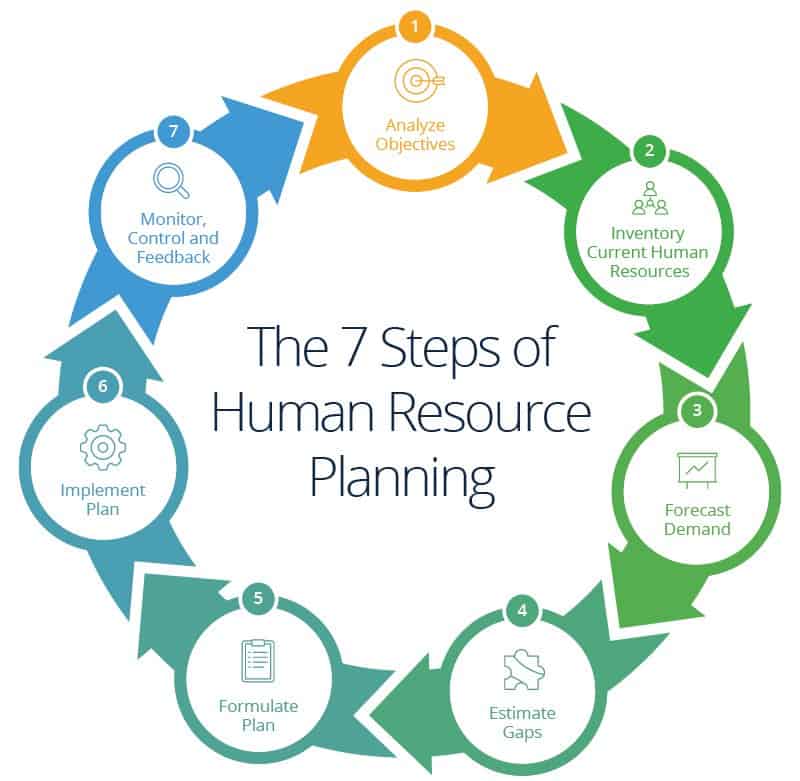
Step One: Analyze Organizational Objectives
Aligning HR practices to strategic objectives is fundamental to an effective human resources plan. In a perfect world, human resources management works hand in hand with other top managers so there is a clear understanding of ultimate goals, and then they focus on the human capital needed to meet them. It’s vital that the human resources plan encompasses every part of the company from product development to sales and expansion plans.
HR Strategic Plan Template
If your company hasn’t written a strategic human resource plan, this template will help you get started. Modify the template to suit your specific needs or to focus on target areas such as benefits or retirement. Stakeholders will appreciate the basic design when they want to review important aspects of your plan.
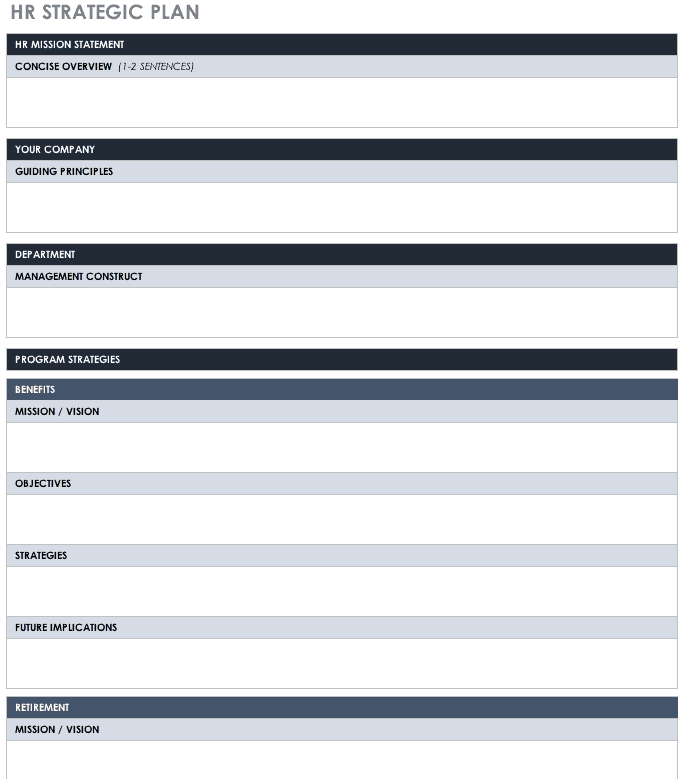
Download HR Strategic Plan Template
Need more strategic planning templates to clarify goals for your organization? You can find more free strategic planning templates here .
Step Two: Inventory Current Human Resources
If you have one, use the updated human resource information storage (HRIS) system to analyze the number of people you currently employ, along with their skills, performance, and potential. Once you determine which jobs need to be filled based on your forecast, you can then decide whether you have enough internal candidates to fill the job requirements or if you need to go to external sources or strategies to add staff.
Employee Evaluation Template
If you don’t have an HRIS system, you can use this performance evaluation template for performance reviews and as a first step in referencing your current human resource inventory. Adapt this easy-to-use form to gain a better understanding of the duties for each position by identifying gaps in performance and staffing when you review information in the aggregate. This template documents performance against set goals, employee evaluation, and professional development plans for the upcoming year.
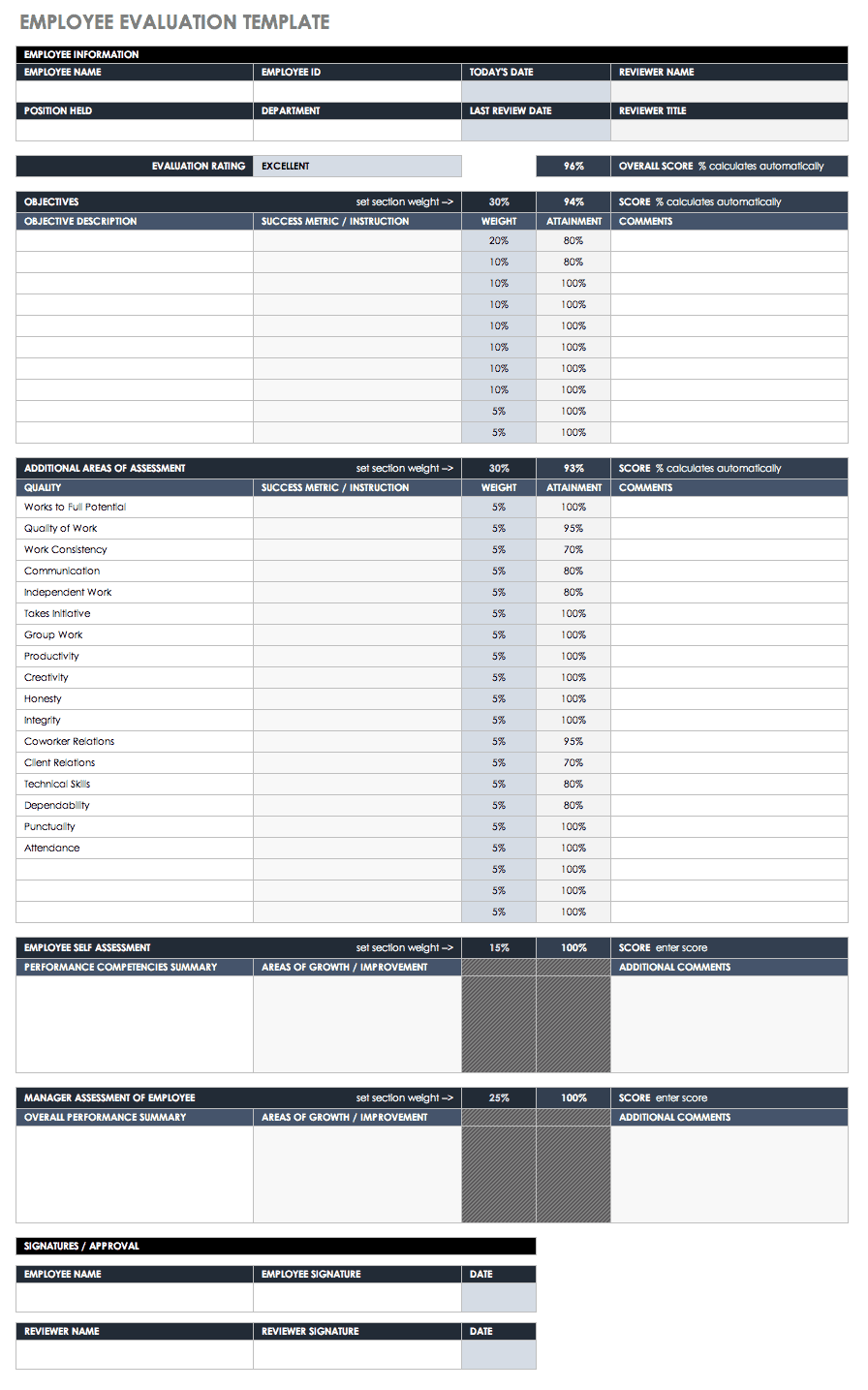
Download Employee Evaluation Excel Template
Excel | Smartsheet
Step Three: Forecast Demand
Forecasting human resource demand involves estimating the number of future employees of the right quality and quantity, with a view to the company’s strategic plan over a given period of time. Forecasting demand is the most crucial part of human resource planning and the most daunting. It’s challenging for many reasons, and even more so because there are no absolute answers on how to accomplish it.
There are two categories of forecasting methods: quantitative and qualitative. You can use both methods to track the work performance of the workforce as a whole, individuals, or business units. Qualitative reports contain anecdotal observations, while quantitative data is statistical or more data-driven. Select the methods that make the most sense in your environment. For example, in a non-manufacturing company, the work-study method which calculates the necessary working hours to produce units may not make sense. By gathering both quantitative and qualitative information, you can identify issues that are impacting your business's productivity, and then develop a well-rounded forecast to increase the company's efficiency, ensure you’re not over or understaffed, and understand future needs.
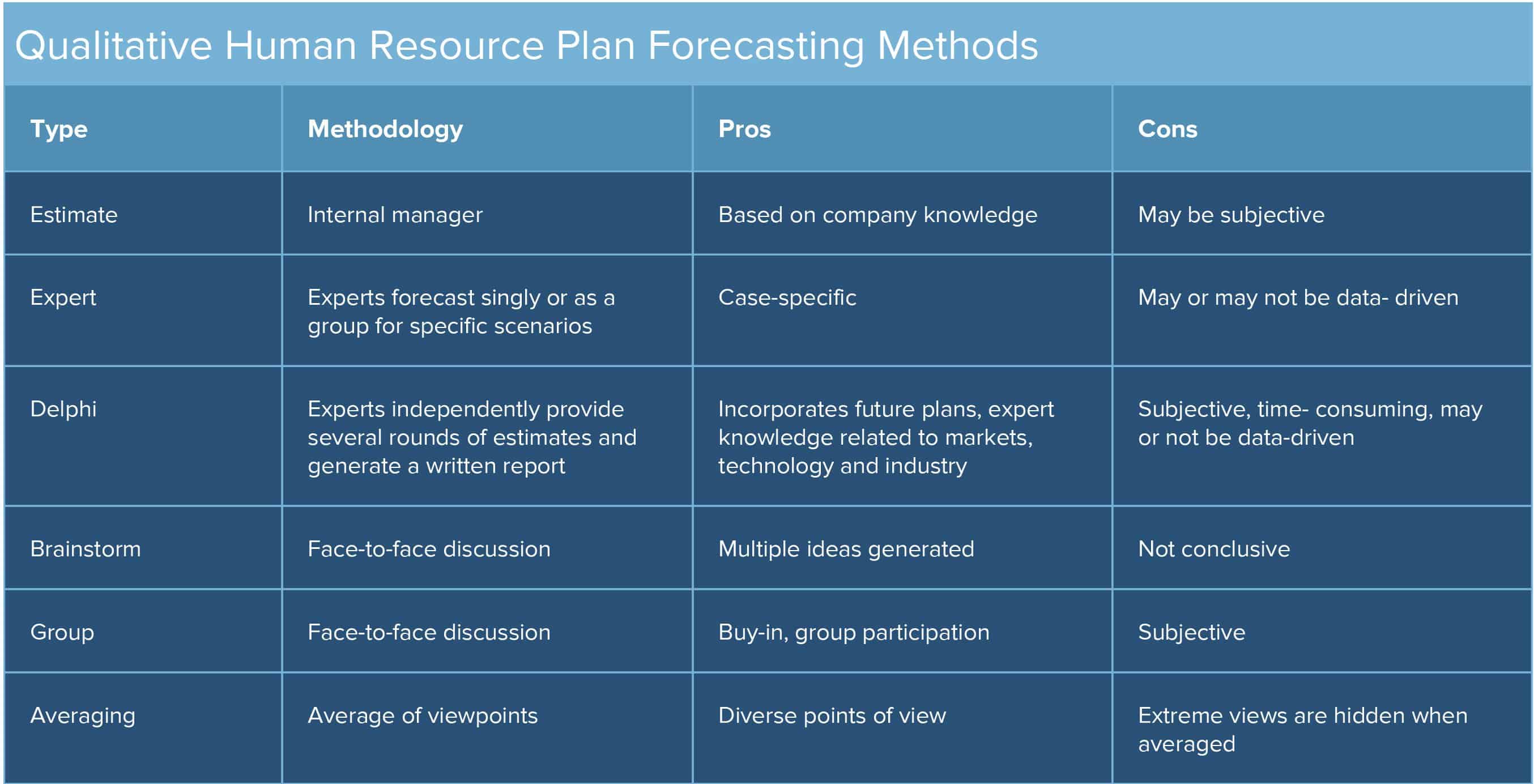
SWOT Matrix Template
The classic SWOT layout provides a clear view of your compiled findings as they relate to your human resources plan. The template also includes a column for rating the importance of each item by category so you can have a clear understanding of how the analysis elements compare and which will need the most attention. You can add Excel worksheets to hold supporting data and clarify the basis of your findings.
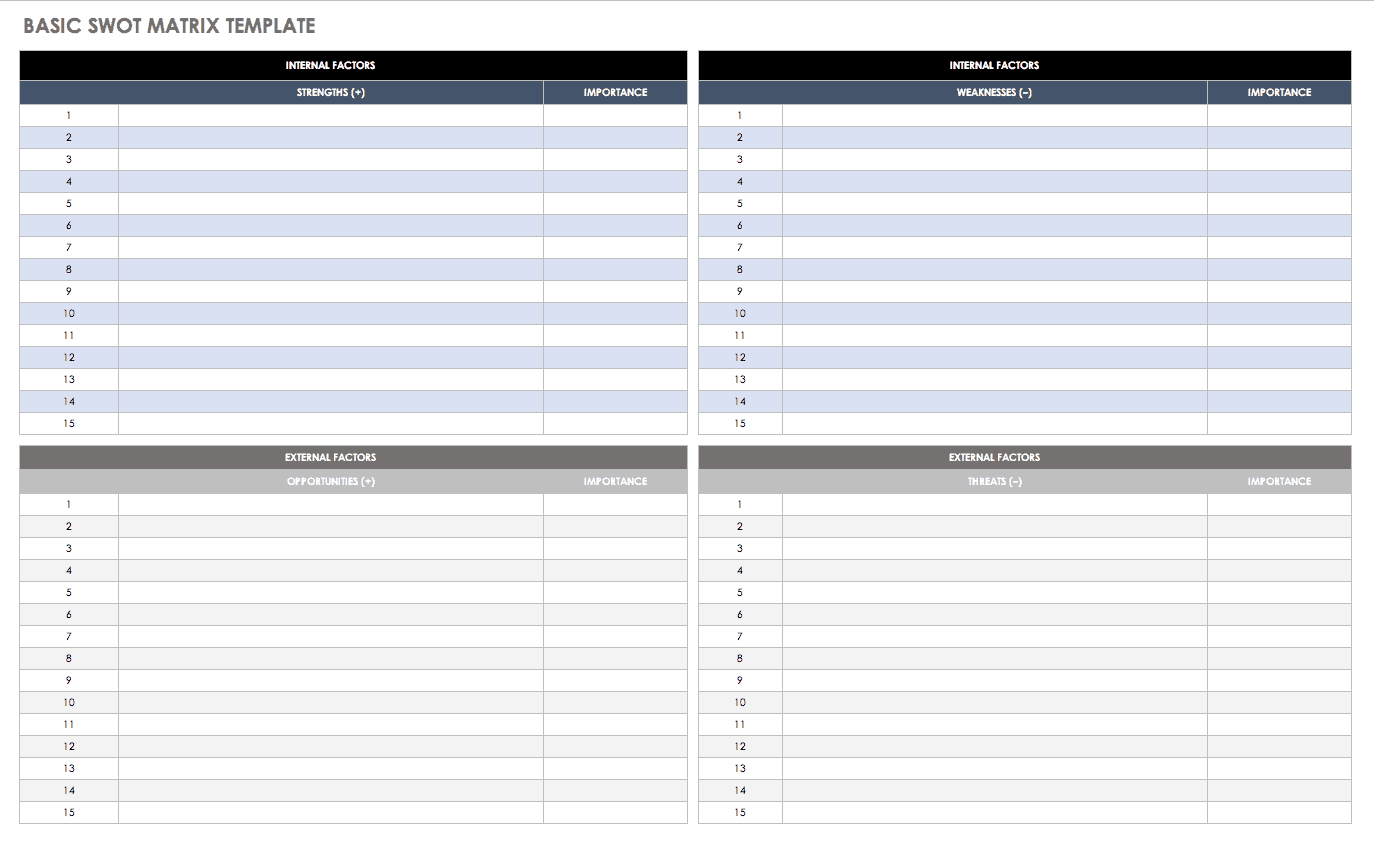
Download Basic SWOT Matrix Template
If you’re looking for different formats in Excel, PowerPoint, or Word, you can find free SWOT templates here .
Step Four: Estimate Gaps
With your forecast completed, you’ll have an understanding of future needs and if you will need to fill them with external workers hired full-time, part-time, or as contractors. If you have the right number of employees that don’t have the right skills, you can use training and development to upgrade employee skills to fill the gaps, or you may need to deploy workers in another role.
Employee Training Plan Template
Training is relevant for both employee success and team member retention. Though training takes time and effort, it's essential to have a plan in place to ensure a productive ramp-up period for new employees or existing employees who are learning the tasks and responsibilities of a new role. With this adaptable employee training schedule template, you can create training activities lists, add details about which team members need help to complete each task, track status, and provide a way for the manager and employee to enter feedback.
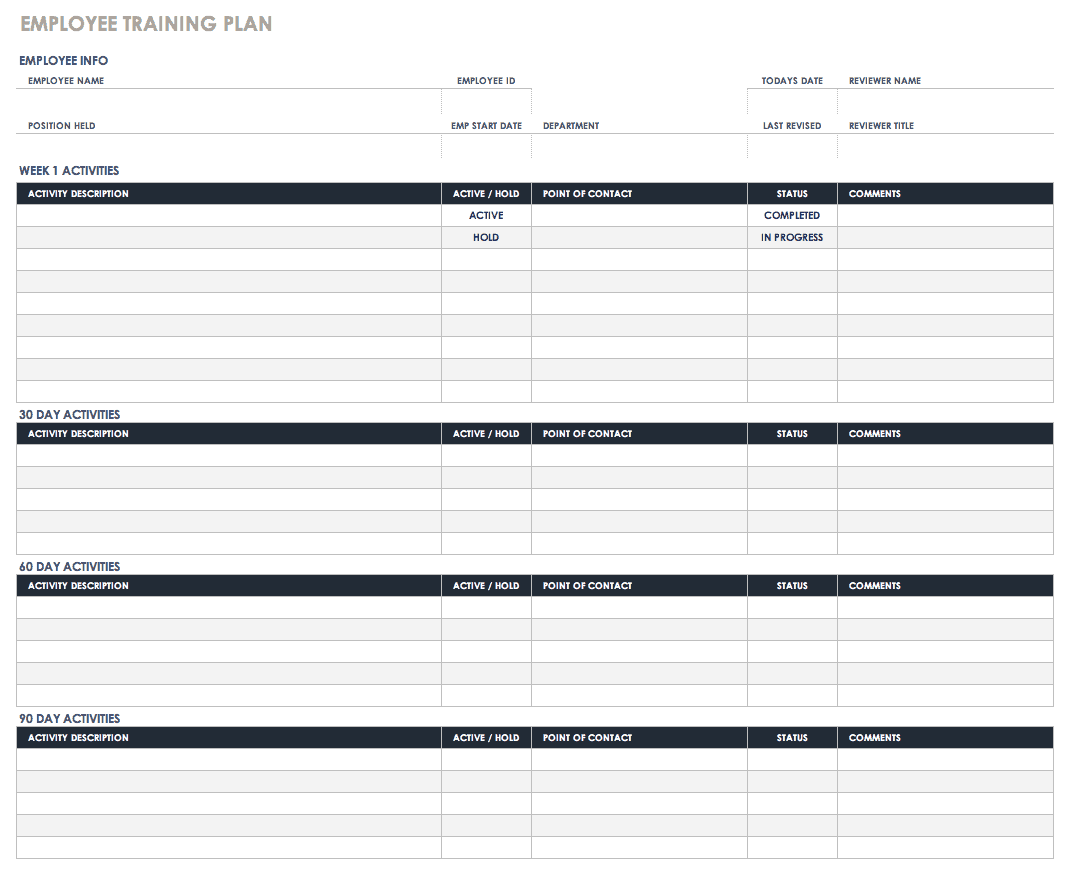
Download Employee Training Template
Transition Plan Template
Moving team members to fill different roles can be the ideal solution to filling workforce gaps. When making these changes, ensure that you maintain the information and knowledge the employee had in the initial role. An employee transition plan keeps the information accessible and easy to share. You can also use this transition plan template to assist the person previously in the role train any new team members. Input every aspect of the role that will be useful in the present and future.
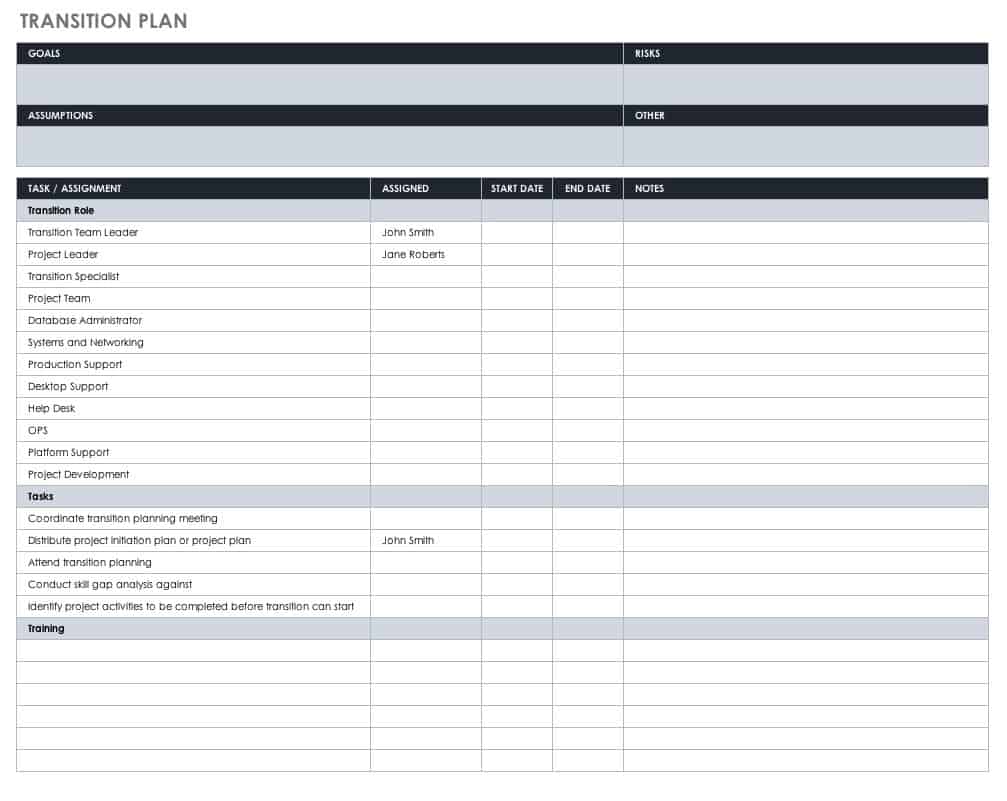
Download Transition Plan Excel Template
Step Five: Formulate the Human Resource Action Plan
The human resource plan relies on identifying deficits or surplus in the company. You’ll need to determine if you need to begin recruiting or training, transition, or develop voluntary retirement processes and redeployment in case of a surplus. Include priorities and critical planning issues in your plan.
Action Plan Template
This action plan template provides sections for goals, but you can add more sections to customize it to complete your human resources plan. Goals are translated into actionable steps that you can track to check progress. Assign start and end dates for each action, and take notes about each part of the plan.

Download Action Plan Template
Word | Smartsheet
Step Six: Integrating/Implementing the Plan
This is the most challenging aspect of any human resources plan. The organization often invests time and money on plans that are shelved and not utilized. Company executives need to grant buy-in, embrace the plan, and bring the organization on board. Overcome any potential employee resistance to the process by rolling in one aspect of the plan at a time to help employees acclimate to changes. Staffing or Recruiting Plan Recruitment is one of the top responsibilities of any human resources team. Searching for, vetting, and finding the right talent to join your team are all crucial steps to ensure the success of your organization. Having a staffing plan in place makes your team aware of the available recruitment sources, hiring goals, and budget. Use this staffing plan to organize all staffing details with columns for budgets, hiring goals, status, and comments.
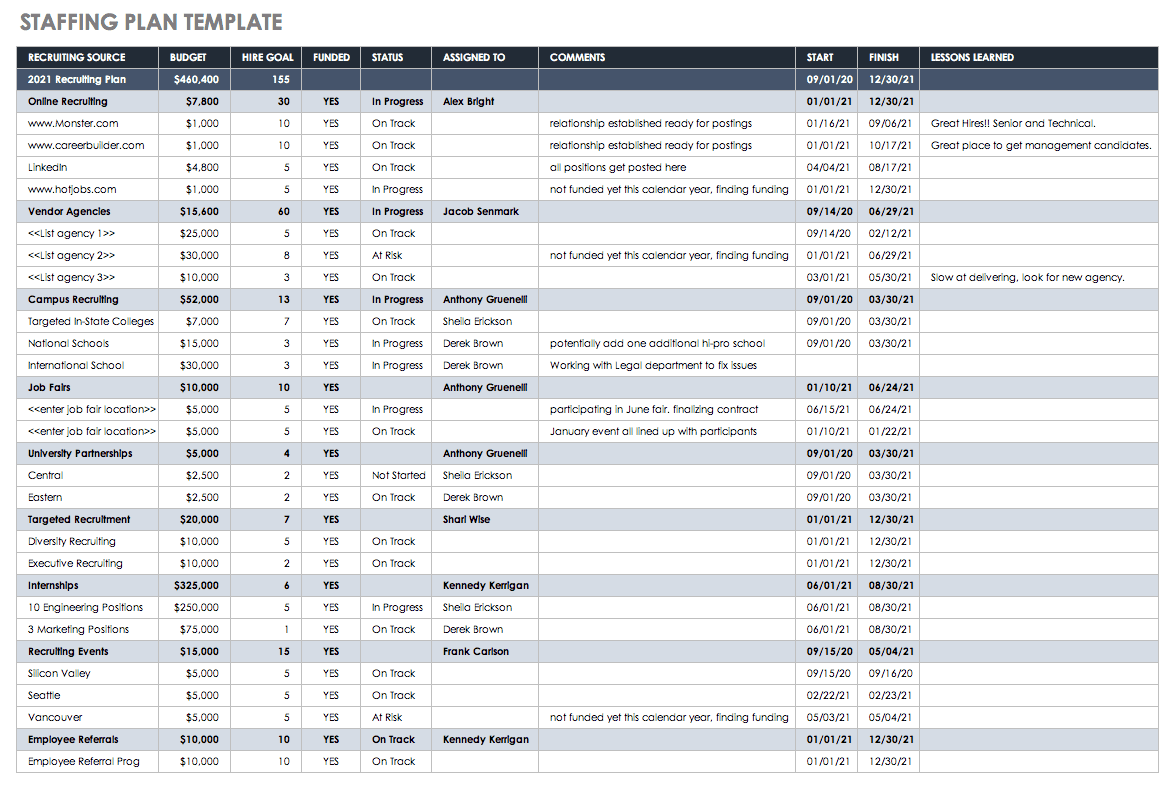
Download Staffing Plan Excel Template
Candidate Screening Tracker
If you don’t have an automated system, you can track and manage applicants’ cover letters, resumes, applications, and details about job openings. Tracking this information can be a lot of work depending on the size of the company and current hiring plan. Use this candidate tracker template to organize candidate documentation and details, and ensure that you provide a positive experience for candidates and people involved in the interview process. Track candidate contact information, phone interview questions and answers, status, comments, next steps, and more using this template.
Download Candidate Tracker Excel Template
Onboarding Plan Template
Onboarding ensures proper training and enculturation for new team members, and is also a powerful retention tool for any organization. Develop your own onboarding plan by using this template to plan activities at each stage of the process. Since a full year of onboarding is a best human resources practice, this spreadsheet shows tasks assigned to individual contacts over a twelve-month period. Add or remove columns to create a comprehensive onboarding plan.
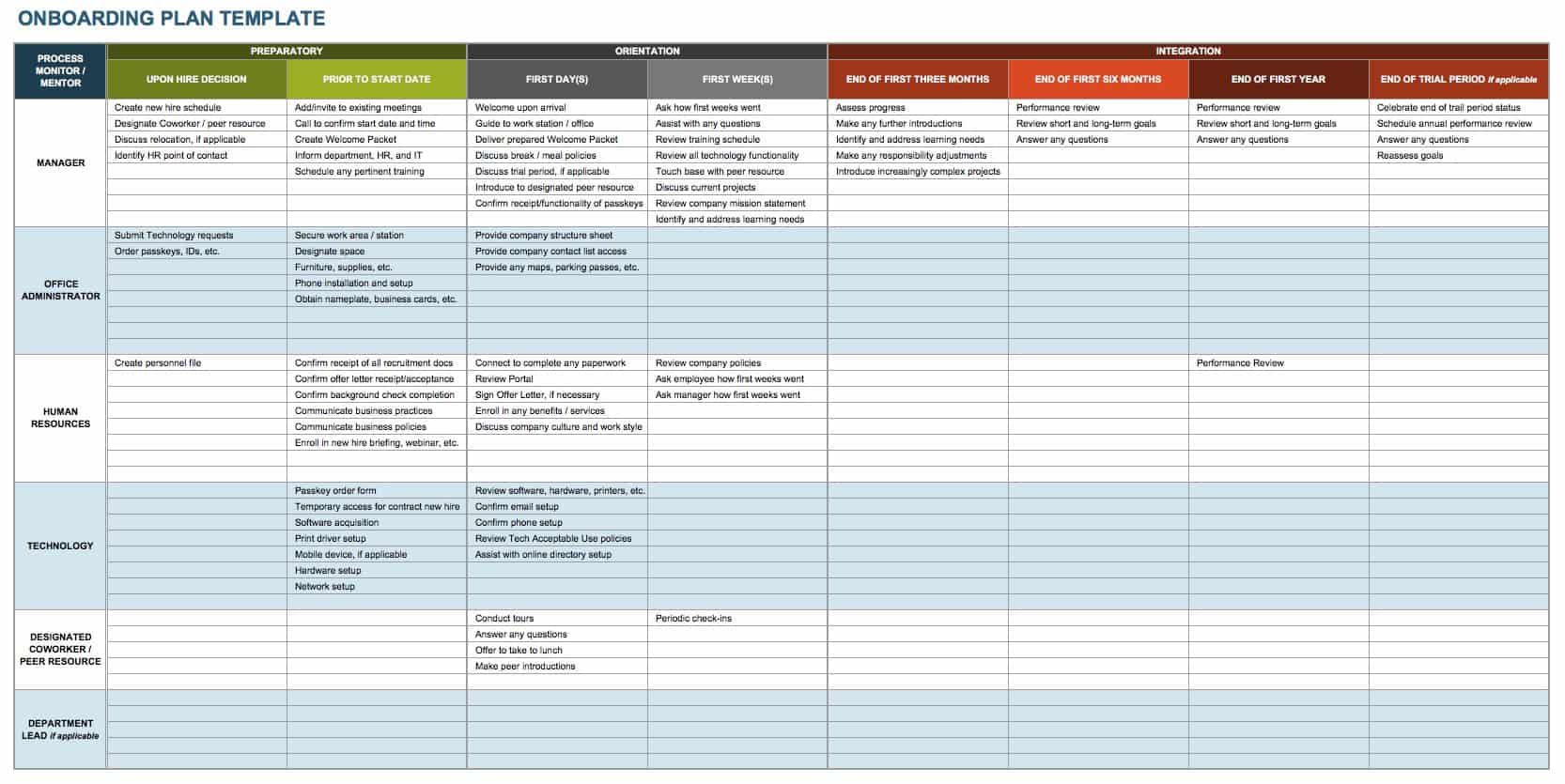
Download Onboarding Plan Template
For more best practice information and free templates to support your human resources planning, read Top Excel Templates for Human Resources .
Step Seven: Monitoring, Control, and Feedback
Strictly monitoring progress helps identify sticking points in your plan and helps you avoid making changes too quickly. It’s essential to compare actions to how the plan is being implemented to ensure fidelity. The human resource plan is an evergreen document that takes changing circumstances into account. Ongoing measurement, reporting, and continuous improvement efforts will keep the company moving towards its stated strategic goals.
Project Management Dashboard Template
Monitoring all the changes you need to while executing a complicated human resources plan can be time consuming. With this customizable project management dashboard, you can compile every aspect of the process, share status information with management and other team members, and view the big picture at a glance.
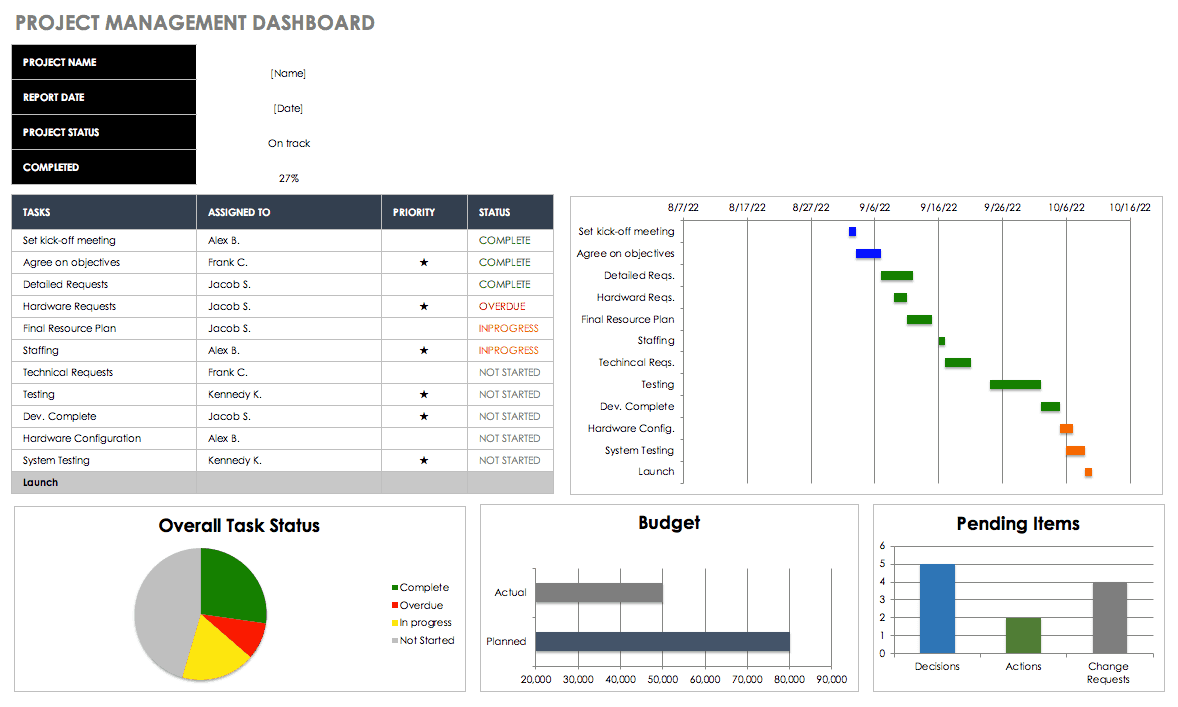
Download Excel Project Management Dashboard
Forecasting Is an Ongoing Process
“HRP plans should be reviewed annually, just after the business completes its strategic planning and forecasting for the year,” says Handrick. “For example, if the business plans to open an additional manufacturing location, or offer additional services requiring tech skills not currently in place, then HR will come along and provide estimates as to how many FTEs, what roles, and what kind of skills will be needed. HRP helps with the budgeting for the next fiscal year, and once approved can get to work filling those roles. In a fast-moving environment, HRP may need to be updated with every major change. For example, let's say your organization is project based and you just won a huge contract. Right away your HRP team will need to work with project managers to estimate staffing needs, whether temp or permanent, contract or hire.”
Human Resource Planning Round-Up: Best Practices and Expert Insights
Our experts share their thoughts on some additional issues to keep in mind as you develop your own plan:
- The Importance of Policy Planning: Company policy supports your human resources plan. Policies such as employment classification, benefits, compensation, performance, and improvement are designed to target not only the selection, training, and support of team members, but also to provide guidelines for conduct in and out of the work environment and many other aspects of employment.
- Social Media as Friend and Foe: Social media sites like LinkedIn and Twitter can be powerful recruiting platforms and a friendly, fun way to communicate with team members. However, they can also potentially be an issue when disgruntled employees or competitors get into negative commentary. It’s important to be alert to your company’s social media profile and to take corrective action when the buzz may not be favorable to your goals.

Sharon Margules, MA, CPC, ACC and CEO of Margules Leadership Consulting says, “The ability of a business to achieve its strategy is largely based on the talent it has to execute. While market and competitive forces can significantly impact the capacity of an organization’s pursuit of its strategy, the explicit capabilities of those doing the work will determine if the result is a success or failure.”
- The “New” Human Resources Professional: “Ultimately, a good HR person is a good business person,” says Adler. “The best HR professionals are system and integration project managers who understand deadlines and highly complex projects. A great candidate has business experience in something other than HR. In my consulting work, I’ve told CEOs that they should look for HR managers with a business background. I think it’s an important consideration, particularly for large firms.”
- More About Markov Predictive Analysis Modeling: One of the most difficult analyses to execute and potentially one of the most valuable tools in forecasting is the Markov model. It’s not a quick fix, but for most mid-to-large companies, it’s worth the time investment to learn how to execute it. For a detailed explanation, read A Markov Model for Human Resources Supply Forecast Dividing the HR System into Subgroups .
- Leadership and Succession Planning: “HR plays a critical role in enabling leadership, in mature or scaling organizations, to anticipate and understand the talent capabilities that will be necessary to meet their strategic objectives,” says Margules. She lists four items:
- HR should have a seat at the table when the strategy is being conceived to align on what capabilities are needed, and by when, to realize the strategy.
- HR needs to influence progressive and aggressive budgeting for resource acquisition, training, coaching, and development every year.
- HR must institutionalize effective succession and talent planning practices at all levels, and build an adaptive organization that can flex its structure to optimize performance.
- HR must use far-reaching ideas to retain its key talent and sustain a highly-engaged workforce in a diverse and driven culture.
- Plan Implementation: “HR plans should align with business strategy and annual plans and should be adaptive to a volatile and uncertain business climate,” says Margules. “While many organizations take a reactive, in-service approach to HR planning and determine their priorities and plans largely in support of annual plans, the most effective organizations are proactive: They anticipate needs and build plans that achieve short term and long term objectives. They adopt progressive practices such as allocating a portion of the staffing budget and resources to recruit and hire key talent for future-focused work. And, they have enough foresight to invest in high potential programs at multiple levels, entry-level accelerated development programs and coaching to build pools of qualified talent for future growth plans.”
- Buy HR Planning Tools or Do It Yourself? “The problem with traditional human resource planning is that it often hasn't supported the scalability of a growing business,” says Burr. “This is precisely why we have to consider new models for talent management, organizational design, and learning and development to ensure that our human resource planning processes can be flexible to meet the scaling needs of the business. This is part of the reason why you have seen an explosion of people analytics tools in the HR marketplace. It is to fill the demand for flexible and scalable models that provide the needed tools for business leaders to plan their people needs as the business grows.” Adler concurs and says: “I think a spreadsheet can often do a better job. Workforce planning has been around a long time. I think the main point is to be proactive and less reactive in the planning process.”
Five Challenges to Human Resources Planning and Implementation
“People are naturally change- and-risk-averse. Planning and proper support by HR and the people they hire need to happen 100 percent of the time,” says Adler. More often than not, there are some challenges involved in human resources planning and implementation. Here are the five main hurdles:
- Forecasting Is an Imperfect Art: Human resource planning relies on forecasting and supply, which can never be a 100 percent accurate process.
- Resistant Workforce: Employees may feel that their workload will increase, so they resist the process, or they may be uncomfortable altering familiar patterns in their work life and tasks.
- Ambiguity and Rapid Change: Uncertainties such as labor absenteeism, employee turnover, seasonal employment, technological changes and market fluctuations all affect planning.
- Inefficient Information Systems: Human resource information systems need to be reliable, comprehensive, and up to date. It makes it difficult to plan without good data about current employees.
- Cost and Time Factors: With all of the work hours involved in completing and repeating the seven steps, human resource planning is a time consuming and expensive process, so companies sometimes avoid it altogether, despite the benefits.
A Look to the Future of Human Resources Planning
Here are some of the themes experts think will influence human resources professionals, their companies, and the people they hire in the near future:
- Going Global: Globalization, the export of U.S. jobs and the import of non-U.S. employees are already underway, as is offshoring (basing services or processes in different countries). “Globally planning can be complex for any HR professional,” says Burr. “It can be a stressful situation for offshoring and outsourcing of jobs within a firm. HR planning should involve a detailed assessment of the new location globally, the workforce demographics, industry competitors, laws and regulations and the potential impact on U.S. jobs. How do we communicate? How do we train? This will all vary by organization, but a strategic HR plan that communicates the information can lessen the impact. With a sound and detailed HR plan, recruiting, retaining and growing talent within the organization will be much easier.” “Expect more offshore jobs, outsourcing and contract hiring because frankly they’re cheaper, and in many disciplines like finance, IT, marketing, can do the same work for less,” says Handrick. “Other than providing training for supervisors to manage off-site work teams, there's really no difference for HRP except where the line item goes on the plan. For instance, if you know you'll need 12 FTEs next year, and can get four of them offshore, that line item goes to 'expenses' rather than to 'salary' for the remaining eight.”
- More Technology: Social media will likely be in higher use to reach potential workers, particularly millennials who use Twitter, LinkedIn, and Facebook in their job hunts. Telecommuting and the use of social collaboration tools and video conferencing apps will keep people working and in touch with company culture. Emerging platforms will further streamline basic human resources functions to make onboarding and professional development more cost-effective and accessible from anywhere in the world for a virtual workforce.
- Big Data: Metrics and in-depth analysis of processes and people will become increasingly important in human resources as they are in other functional areas. Data- driven decision making is the future, as are metrics to show ROI in people and technology.
- Security Issues: All this new technology brings up security concerns for employers and employee. Data breaches are a fact of life, and the threat to personal data security, company security, and supply chain risks will likely continue.
- Health Care Costs: Costs are likely to continue increasing, since they have been rising steadily in the last several decades. New legislation will perhaps slow the costs of health care. In the meantime, strategies to lower employee healthcare costs will likely take the form of initiatives to improve employee health, and taking advantage of health reimbursement accounts (HRAs) that are consumer-driven or health savings accounts (HSAs).
Improve Human Resources Planning with Smartsheet
Empower your people to go above and beyond with a flexible platform designed to match the needs of your team — and adapt as those needs change.
The Smartsheet platform makes it easy to plan, capture, manage, and report on work from anywhere, helping your team be more effective and get more done. Report on key metrics and get real-time visibility into work as it happens with roll-up reports, dashboards, and automated workflows built to keep your team connected and informed.
When teams have clarity into the work getting done, there’s no telling how much more they can accomplish in the same amount of time. Try Smartsheet for free, today.
Discover why over 90% of Fortune 100 companies trust Smartsheet to get work done.
Prepare Your Annual HR Plan for 2024

Each year, it is important to create an annual HR plan to guide your people team or human resources department. However, in 2024, it is even more important for HR departments to take into account recent changes , and develop a sound hr strategic plan to take their teams to the next level.
More important than the details of the plan itself is to make sure the company’s mission and vision are reflected within your annual HR plan for 2024. Without clear objectives and a path to achieve them, you may fall short in reaching your company’s goals.
A highly focused and clearly communicated annual HR plan helps to guarantee your HR objectives will be met.
In this article, we will cover the ins and outs of yearly HR planning and provide the key steps to reach your HR goals.
Table of Contents
What is Meant by HR Planning ?
The purpose of a human resources plan is to analyze and evaluate all the elements related to the human resources policy for the coming year.
Everything from staff dynamics, organizational structure , and working conditions to the hiring process and onboarding of new employees .
As there are many aspects of an HR annual work plan, it’s important to first understand the company environment within which you work, as this will greatly affect the HR plan you create. Once you evaluate the company environment, you can then move forward with creating a successful HR plan of action.
Prepare your annual business plan for HR in 2024 and reach all of your objectives.
Map Out Your Annual HR Plan: Evaluate the Company Environment
At the beginning of the year, companies establish a strategic plan, dependent heavily on the human resources department, where the key annual objectives are set. In order to develop a successful annual HR plan, it’s important to take into consideration the company’s policies and procedures , as well as the employee handbook . That way, you can rest assured that the goals and plans of the company are aligned with those of HR.
To reach your HR objectives, you must first know the answers to the following questions:
What Can We Improve on From Last Year’s Annual HR Planning?
Success is simply the result of many failures and tried attempts, all put together. Identifying past struggles and using them as fuel to propel you forward is what leads to success and improvement.
What Expected Challenges Can I Include in My Yearly HR Plan?
When you know what’s coming, you can better adapt and take advantage of the changes, rather than let them take advantage of you. Consider learning about change management techniques to stay in control through the ups and downs. Analyzing the potential challenges is fundamental for preparing your team for what’s ahead. Also, knowing which changes, events and activities are taking place in the coming months, and how they will likely influence your team, allows you to better manage what lies ahead.
What Areas Within the Company Should I Plan to Improve?
Constant evaluation of the state of the company and its staff is crucial to coming up with solutions to improve. With Factorial, for example, you can create human resources reports that display a graphical vision of the company, outlining the required areas of improvement. If used correctly, these charts can also allow you to make visual conclusions about things such as the turnover rate or employee motivation.
Identifying key areas of improvement is one of the stepping stones to a successful large or small business HR plan.
As a result, reaching your yearly objectives is easy when you take the proper steps to first analyze the company’s environment and what you are working with . Clear communication between the human resources department and the company’s management is vital to creating a solid base for your annual human resources plan.
Define Your Annual HR Plan Goals & Objectives
The objectives of the company’s strategic plan are called long-term objectives . These types of objectives help measure the reach and success of the human resources plan. Generally speaking, they can be divided into two categories:
- Explicit Objectives : Focus on attracting and retaining talent, employee motivation, and improving employee engagement. To set explicit objectives in your annual HR operating plan you have to consider employee experience, the onboarding process, career plans, etc.
- Implicit Objectives: Follow the company’s philosophy and help form the company culture. They show the power of the HR department and how it can help improve productivity. In addition, these objectives focus on the work environment and quality of life for the employees while maintaining all labor regulations.
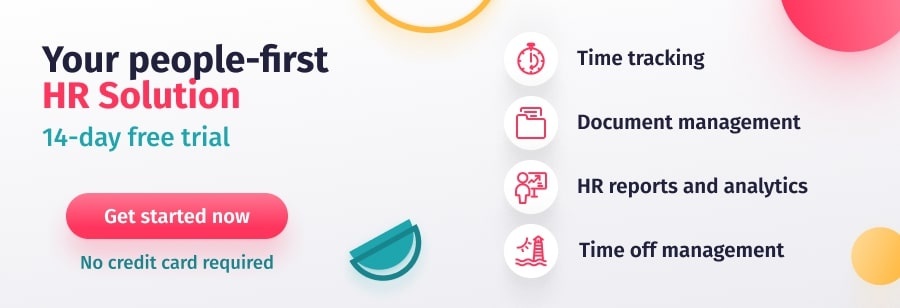
Organize Your Annual HR Planning: Set Team Responsibilities
Once the objectives are clear, both for the company and for the human resources department, it’s time to create your HR plan by reviewing the team responsibilities. Keep in mind, a thorough analysis of what each department will do in order to contribute to achieving the 2024 HR goals is necessary before moving forward.
Following this, the first step in the HR action plan 2024, is to assign a person who will be in charge of creating and implementing the HR plan . For smaller companies, this person will probably be the CEO. In slightly larger businesses, the person responsible is normally the same one who handles all of the human resources-related tasks. Medium-sized companies will look to their HR team; with every member delegated to a specific task, each corresponding with a goal.
Human resources organizational charts are a great way to visually see who is responsible for what, and who reports to who in the company. Using this type of chart is incredibly helpful for your staff planning. They can be also useful to ensure that the HR management to HR employee ratio is in check. Try using a free organizational chart template to have a clear picture of your company’s structure.
These charts are great for displaying the following:
- The structural hierarchy of the company : Directors, managers, intermediate profiles, employees, etc.
- The departments within the company : Marketing, sales, product, human resources, etc.
- Positions to fill : If there are any gaps in the company structure, the organizational chart will make them clear.
Annual HR Staff Planning: Identify Open Positions
Thanks to the organizational chart you can clearly see how many people you need to hire and for which positions. If you want to achieve your objectives for the coming year, you’ll need to have the right team in place.
In your HR plan you will define:
- Which positions are open – Write a detailed description of all the positions to be filled, including the corresponding department, responsibilities, functions, where they fit in the hierarchy, and their workload.
- Define the ideal profile – Here you’ll have to specify the profile of the candidate you are interested in hiring. Clearly outline the level of education you are looking for, the experience level, and the skills required. Based on this, you can decide whether to recruit from within the company if there is an employee that fits the desired profile.
Clearly defining the above details, are important steps to take in your HR plan. Therefore, allow yourself the time to study and analyze your company at each stage of the HR plan creation process.
Start Planning with a Defined HR Policy
Your updated human resources policy must meet the standards and demands of the general HR and strategic plan. The hr policy will also include guides for the HR department, including, but not limited to:
Hiring Guide
The main purpose of the hiring guide is to assist the HR manager in hiring and onboarding. This guide serves to outline the roles and responsibilities of the employees you are looking to hire. It should contain information on the types of contracts for each position as well. Also, including an HR annual training plan template in your hiring guide is beneficial.
Note: As an HR manager, you will need to decide whether the hiring process will be outsourced or handled within the company. If hiring is done from inside the company , a strategic onboarding process must be established to ensure successful recruitment and retention.
Compensation Guide
With every new contract you plan on offering, you need to state the details of each. For example, the salary amount, benefits, and economic bonuses. Make sure that what is offered in your compensation guide is in line with your overall Human Resources budget.
Workplace Satisfaction Guide Personal
Taking care of new hires is important, but don’t forget about your veteran employees. Long-term employees need to feel continually valued and supported as well. In your HR plan, you should invest part of your budget for the personal and professional development of each employee in the team.
Investing in employee wellbeing creates greater workplace satisfaction. Providing employees with the right personal development tools for success is key. Employees that feel supported display greater motivation for achieving their own goals and career aspirations.
Company Guide
Inside the HR policy, you should think about including a practical guide from the company. Contained in this guide, would be the company vision and mission, proper conduct guides, and conflict resolution codes
Build Your Annual HR Plan 2024
Now that you’ve gone through all the previous steps, you’re ready to build the best HR plan for 2024.
As you can see, creating the ideal HR plan for 2024 takes time and effort to compile . Unfortunately, a high percentage of small and medium-sized businesses simply don’t have the personnel to create a dynamic HR plan.
Save time creating your Annual HR plan with Factorial!
A solid HR plan is fundamental to achieving company goals. If you don’t have the correct tools to do the job, you’ll end up exhausting yourself creating a plan that will miss the mark in the end.
With Factorial, you can create your human resources plan for 2024 with ease. Build your organizational chart , fast and easy, and see who is in charge of what at a glance. Decide which departments need more assistance or restructuring.
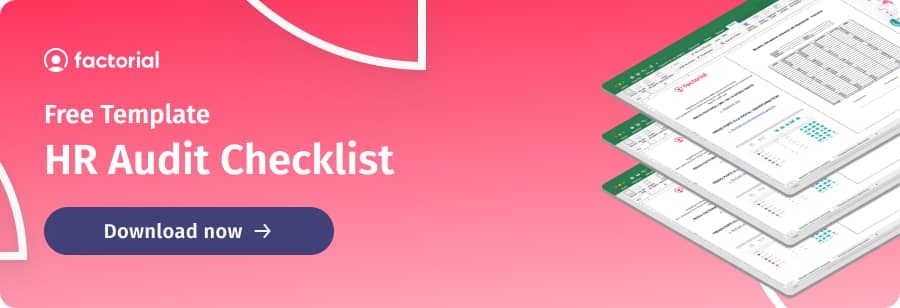
Furthermore, Factorial gives you access to all kinds of human resources reports. These reports help you analyze the state of your company, allowing you to more effectively create the most successful HR plan for the coming year!
Are you looking for a little extra support to streamline your HR processes?
Simplify your HR processes with Factorial
Related posts
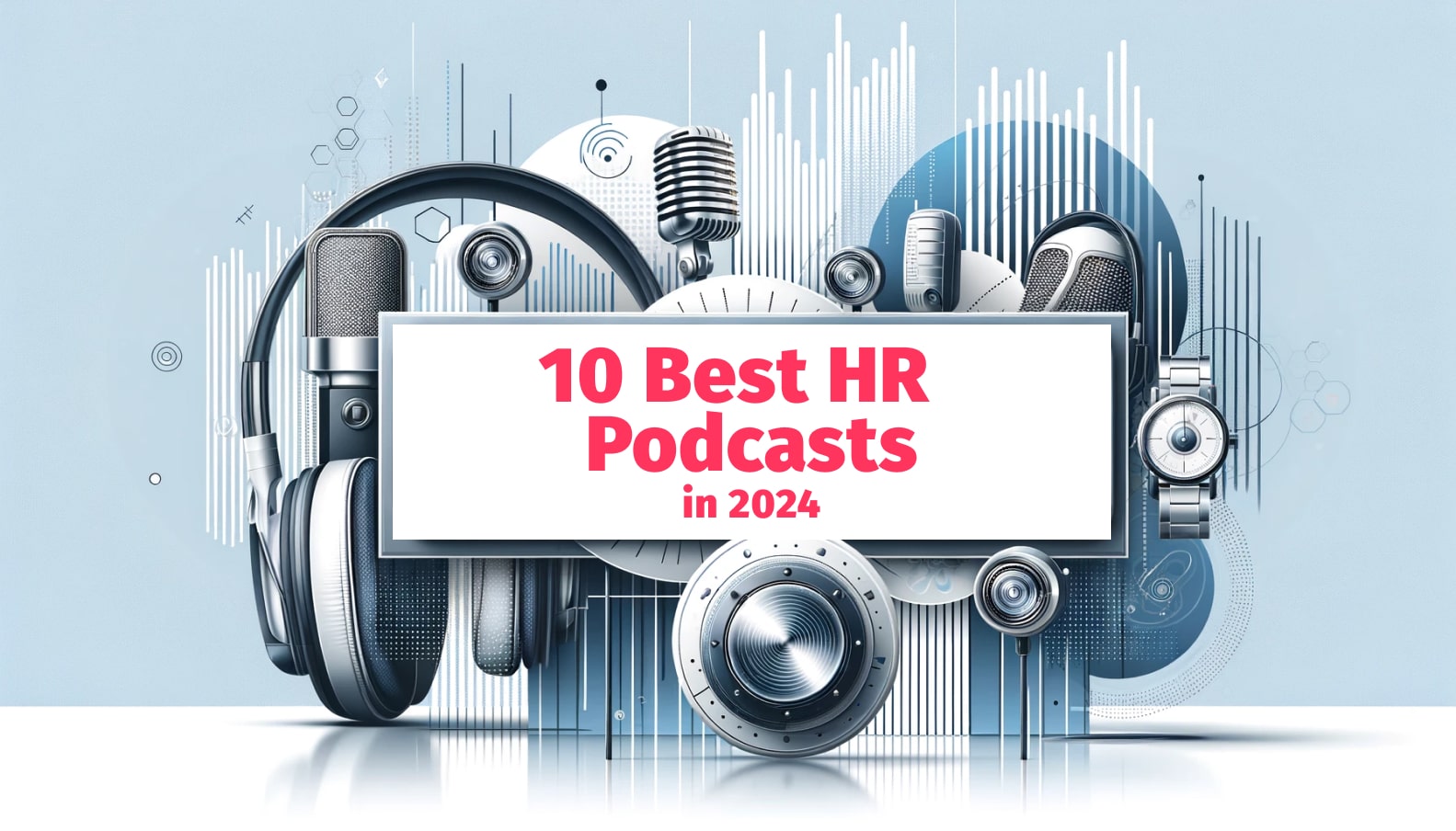
The 10 Best HR Podcasts for 2024: Stay Informed and Inspired

A Millennium Forward: What HR will look like in 1000 years?
“Unfortunately, a high percentage of small and medium-sized businesses simply don’t have the personal to create a dynamic HR plan.”
‘personal’ should be ‘personnel’, unless I am mistaken?
A great article otherwise!
Thanks Trudy!
Post more! Seriously, I am really digging what you have written so far. I’ve scanned your blog right now for more things to read.
Thanks , this piece was indeed very useful.
Leave a Comment Cancel reply
- Responsible: Everyday Software, S.L.
- Contact information DPO: [email protected]
- Purpose: manage your subscription to the newsletter.
- Legal basis of the treatment: user consent.
- Recipients: no data will be transferred to third parties, except legal obligation or except to national supplier companies and treatment managers.
- Rights: access, rectification and deletion, among other rights detailed in the additional information.
- Additional Information: you can check the additional and detailed information about data protection in: Privacy policy
- Purpose: improve your experience in the blog.

Boost your HR with software
See how Factorial powers productivity, engagement, and employee retention.
Book a free demo
- HR department
- Performance review
- Recruitment
- Free HR course
- HR Software
- HR Services
- Compensation
- Learning & development
- Remote work
- Blue Collar
- Occupational health
How to create a human resources plan

Benjamin Franklin is often quoted as saying, “If you fail to plan, you are planning to fail.” We can’t deny that there are few instances in life in which the result turns out better without preparation, especially when we’re talking about business. As a central component of any company, the HR department is no exception to this rule, meaning the human resources plan must be given the importance it deserves.
If you’re still not sure what the purpose of human resources planning is , then this article is for you. We’ll explain in detail how to translate your department’s strategic thinking onto paper and put it into practice.
What is s trategic human resource planning ?
The human resources plan outlines the general strategy for this business area . It includes measures to adapt to current and future supply and demand requirements relating to the workforce, as well as pay policies, wellbeing, etc.
Generally, the document considers the following topics:
- How many staff are required to fulfil the organisation’s needs .
- Staff management strategies .
- Job descriptions for all posts.
- Channels and sources for attracting candidates.
- Recruitment and selection processes.
- Growth and development planning.
The importance of a human resources plan
A company human resources plan is essential if the staff and organisation are to operate effectively . This document is also key to achieving a company’s business objectives.
It also serves to:
- Promote flexibility within the organisation : we are living in a constantly changing world. Effective planning helps companies adapt more easily to new situations and negotiate market volatility.
- Improve the distribution and use of internal talent : by analysing and organising the human capital, companies can make better use of internal talent and distribute employees more coherently.
- Facilitate growth for small to medium enterprises : HR planning is a fundamental aspect of growth strategies. It is important to know when to subcontract, how many people to hire, what benefits will it bring, etc.

The objectives of a human resources plan
Why do companies design human resources management plans ? The main goals are as follows:
- Supply information : the data acquired through a company’s human resources plan are hugely important to, for example, identify surplus, unused resources. Similarly, the information can also be used in other management functions.
- Analyse the current workforce : the document should also determine the workforce’s strengths and existing skills.
- Use human resources effectively : Planning is the HR management’s primary responsibility, as their duty is to ensure efficient use of the current and future labour force.
- Identify salary gaps : the document will also examine any potential salary gaps and, in turn, create more equal policies.
- Ensure internal wellbeing : good planning and organisation almost automatically generate an improvement in the work environment, boosting productivity and employee satisfaction.
- Retain talent : this, in turn, has a direct impact on talent retention. Employees who are content in their job are less likely to accept offers from other companies.
- Foresee potential department needs : all planning should include a forecasting section. Understanding when it will be necessary to incorporate new people into the team and what type of role is required is essential.
6 steps to create a human resources plan
At this point you may be thinking, “but how do I do a human resources plan ?” If that’s the case, here are the steps you need to follow:
1. Define the plan’s objective
Any measures that are developed by a company must be aligned with the general business objectives. This goes for the human resources plan, too.
Aside from this, the specific objectives of the plan will be targeted at a particular area: employee retention, attracting talent, promoting the business culture, etc. It is important to be clear and precise at this stage for the content to be useful and have a real impact on the organisation.
2. Analyse the current human capital
The next key step is to analyse and evaluate the availability and resilience of the current resources. This will entail carrying out an exhaustive assessment of each member of the organisation in terms of skills, experience, performance, seniority, etc.
3. Carry out a needs forecast
Analysing future labour requirements is an important step in human resources planning. Although there will always be fluctuations, it is critical to have a forecast in place of factors such as: redundancies, dismissals, retirements, promotions, etc.
4. Write the HR plan
Once you’ve gathered all the information, it’s time to create a solid plan that fulfils current needs and forecasted possibilities. For example, you will have to decide whether it is necessary to hire, train or subcontract labour to achieve the company’s objectives.
In general, try to include the following information:
- Definition of targets and goals.
- Required measures, expected results and resources used.
5. Implement the plan
Implementing the plan is probably the most challenging step. Many organisations, in fact, do not achieve what they have set out to do. To approach it successfully, trust your team and introduce changes gradually. Try to handle any incidents as they come along and make sure you are complying with the organisation’s general standards.
6. Monitor and review the process
HR planning is an ongoing process. It is important to review the plan periodically to make sure the strategy is pointing in the right direction and achieving the objectives.


How to Succeed with Human Resource Planning: A Step-By-Step Guide (+11 Free Templates)
“ The term planning is imbecilic; everything can change tomorrow. “
That was a quote made by a French manager , straight after the 1973 oil crisis.
He’s right, of course. Everything can change tomorrow. We’re living in a world where we see changes every day. Ground-breaking technology, product innovations, and medical breakthroughs.
But does that mean “ planning is imbecilic ” though?
The truth is that planning can be ineffective and damaging if it’s done badly.
Good planning, on the other hand, can minimize the uncertainty brought on by change.
Don’t believe me?
Take the 1911 race to the South Pole, for example. The race was between two explorers: Roald Amundsen and Robert Falcon Scott. They each had a similar amount of experience and were the same age. Both faced 1,400 miles of gale-force winds, blizzards, and minus temperatures on their expeditions.
Amundsen meticulously planned his trip for several years. Scott didn’t.
Guess which expedition tragically failed?
Amundsen was already sailing back to Norway when Scott’s team finally gave up hope.
So, now we’ve established that planning is sensible, and not ‘ imbecilic ’, let’s find out why human resource planning is one of the most valuable processes a company can follow.
To do this, I’ll cover:
What is human resource planning?
Why is human resource planning important, the 7 steps of human resource planning, how human resource planning is done, human resource planning in hrm.
Let’s get on with helping you to plan for success!
Corporate leaders often say employees are their most valuable asset . In fact, employees are so valuable that over 23% of businesses fail because they don’t have the right team.
That’s why investing in Human Resource Planning (HRP) is one of the most important decisions a company can make. It’s also why 80% of companies do HRP on a regular basis.
In simple terms, HRP is a process that manages employees within an organization .
No organization can afford the risk of a critical skills shortage and without HRP, companies face expensive losses. This can be seen with 90% of the UK’s larger organizations , which have all restructured in the last five years – nearly always involving job losses.
“ Human resource planning is the most important component of the entire human resource system. ” – Dr. Rajendra Mishra
We’ve established what human resource planning is, let’s talk about why it’s important.
The success of a business is directly linked to the performance of those who work for that business. It’s therefore critical to make sure that the business has the skills and competencies that it needs to succeed.
The quality of human resources in an organization is solely dependent on the success of human resource planning.
Look at Starbucks.
Starbucks has the lowest employee turnover rate among quick-service restaurants. Most quick-serve restaurants have between a 150 to 400% turnover rate. Starbucks’ rate is at 65% , and it’s all down to their human resources planning approach.
Not only will its low turnover rate positively affect the culture, motivation, and morale of its staff , but it will also massively help its profit margins.
On average, companies spend 33% of an employee’s annual salary to replace them when they leave.
We know that human resource planning is a continuous process of planning ahead to make optimum use of an organization’s most valuable asset: its employees .
We also know that the process helps companies maintain a steady supply of skilled employees to meet their strategic objectives.
So we know what human resource planning is and why it’s important, now let’s look at how to do it.
There are seven steps to a good human resource planning process:
- Understand business goals
- Assess the current workforce
- Forecast demand
- Estimate gaps
- Formulate a plan
- Implement the plan
- Monitor the plan
Let’s dive into the detail of each step.
Step 1: Understand business goals
The first step in HRP involves analyzing the organizational strategy, goals, and objectives.
It’s important to understand where the organization wants to go and how it wants to get there so that HR practices can be aligned with the company’s strategic objectives .
Step 2: Assess the current workforce
The next step is to take stock of the current employees in the organization to see if they fit the organizational needs.
The inventory of current employees should capture data concerning ages, locations, capabilities, and skills. This will determine what jobs are required and if you can use internal candidates or if you need to look elsewhere.
Step 3: Forecast demand
The third step in the process is to forecast future staffing needs based on the company goals.
This process will establish if the company needs to grow its workforce , or if it can improve its current staff through training.
Step 4: Estimate gaps
Once the future resource needs and the current capability of the workforce have been identified, step four requires you to highlight the gaps between the two .
These questions will help you find out where the gaps are:
- Do you foresee a skill shortage in a specific occupational group?
- Will changes in program delivery require the acquisition of new skills?
- Do you have succession plans for critical positions?
- Have you conducted a risk analysis of the elements of the scan critical to the success of your organization?
Step 5: Formulate a plan
Step 5 is all about formulating a plan to close the gaps you found in step 4.
The plan should identify the skill shortages and surpluses within the company. It should determine HR priorities and list actions to be taken around recruitment, training, internal role transitions, retirements, and lay-offs.
Step 6: Implement the plan
This step involves integrating the HR plan into the company . It will require support from different departments and teams.
Step 7: Monitor the plan
This step often gets missed, but is a fundamental part of the HR planning process.
Ongoing measurement, reporting, and continuous improvement will keep the company moving toward its strategic goals. If everything is running smoothly, continue with the plan . If there are roadblocks, change the plan to suit your company’s needs.
And there you have it. Seven steps to the efficient management of human resources in an organization.
What’s next?
Lucky for you, this isn’t where your human resource planning journey ends.
Process Street has created eleven super-powered checklists to help you with your human resource planning:
- Training plan template
Employee evaluation form
Employee transition plan.
- Gap analysis template
HR strategic plan
- Employee satisfaction survey
Workforce planning template
Employee development plan template, hipaa compliance checklist for hr, vacation request form, business needs assessment checklist.
These templates will enable you to:
- Analyze your current workforce;
- Establish future workforce requirements;
- Formulate, implement, and monitor a formidable human resource plan.
Use the following Process Street templates to really smash your human resource planning!
Training plan
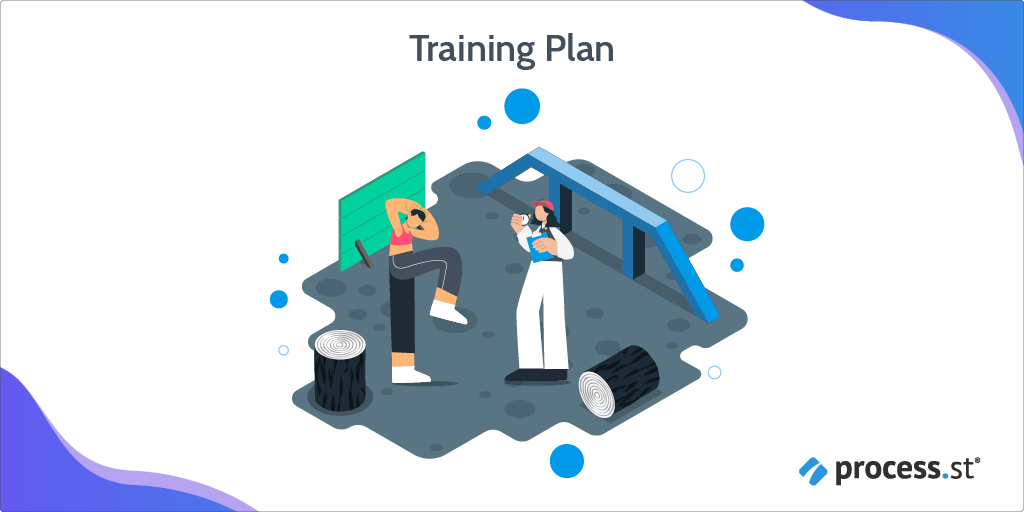
The training plan aims to improve workforce competency to increase productivity and reach organizational goals. Preparing an annual, company-wide training plan is a detailed and complex process .
Our training plan template will make it easy for you. It will identify who needs to be trained, when they should be trained, and what they need to be trained in. It also ensures alignment with your organizational goals.
Click here to access our training plan template!
Employee evaluations exist to make sure there is clear communication between employers and employees about performance levels. The process boosts morale and identifies areas of weakness. These can inform your HR strategy, gap analysis, and training plans.
Use this employee evaluation form to:
- Capture performance metrics;
- Analyze your workforce;
- Make decisions about what future resources are needed.
Click here to access our employee evaluation form!
Performance review
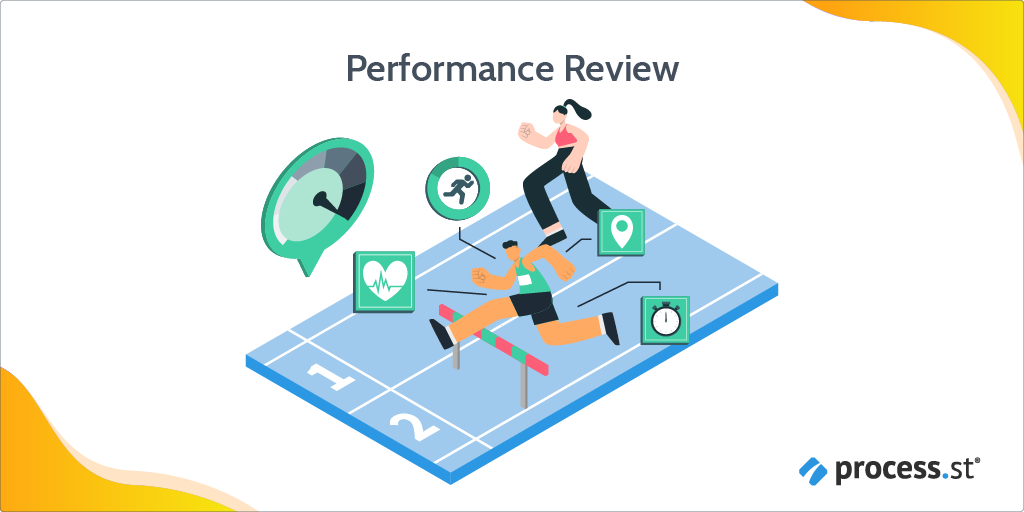
We also have this performance review template which you can use as an alternative.
Click here to access this performance review template!
This process is for the HR team to ensure that a transitioning employee moves into their new role, smoothly and at a minimal cost to the business. It’s important the employee, their current line manager and their new line manager are all clear about the transition arrangements.
Our employee transition plan will provide guidance on handover and orientation tasks. It will also minimize disruption and uncertainty for employees affected by the change.
Click here to access our employee transition plan!
Gap analysis
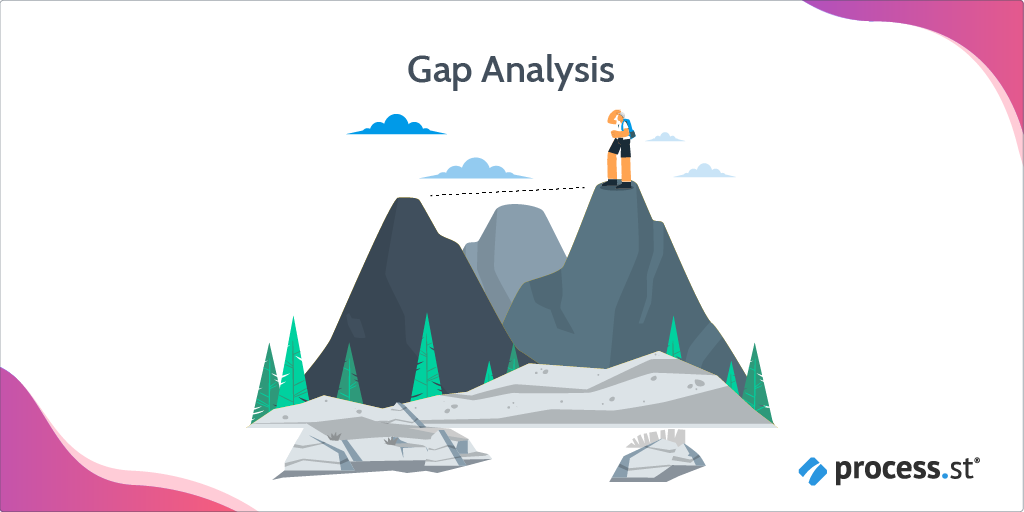
Gap analysis involves you considering current skills in your workforce. As times change, skills will change to suit the modern business market. The below template gives you the foresight to keep your team and company up to date with current skill trends.
Use this gap analysis template to help your organization plan for growth. Use it to project the hiring needs for your future workforce. It can also help you to understand the skills and experience of your current workforce. You can also use it to develop strategies for overcoming the gap between the two.
Click here to access our gap analysis template!
An HR strategic plan is a tool to help businesses align their HR capabilities with their organizational goals . It establishes how human resources can make a direct impact on a company’s growth.
Our HR strategic plan will assess the needs of your organization. It can help to determine appropriate initiatives for the HR department to pursue and support the business in meeting its goals.
Click here to access our HR strategic plan!
Employee satisfaction
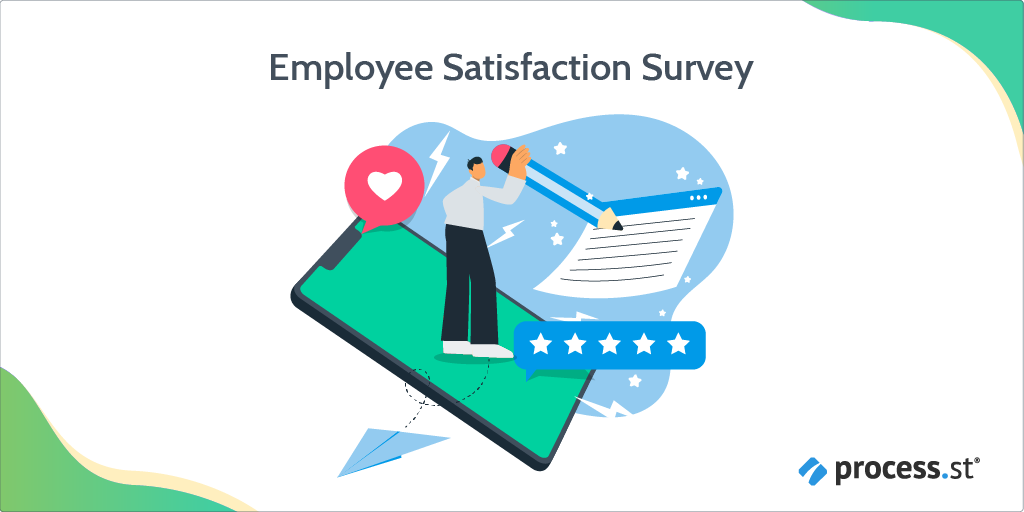
An employee satisfaction survey is intended to understand how employees are feeling about the company.
Our employee satisfaction survey will help you understand the current dynamics of the workplace. Once completed, it will identify areas within the business that need to be improved to keep your employees satisfied.
Click here to access our employee satisfaction survey!
Workforce planning ensures that a business has the right staff in place with the right skill sets.
Our workforce planning template will highlight areas within the workforce that need attention .
Click here to access our workforce planning template!
The employee development plan template will help your employees improve in their current job. It will also help them acquire knowledge and skills for new roles and responsibilities within the organization.
Click here to access our employee development plan template!
HIPAA is a series of regulatory standards that health care organizations must implement in their business to protect the privacy, security, and integrity of protected health information .
The compliance program that healthcare organizations need to follow is complicated and can take a long time to complete. Use our HIPAA compliance checklist for HR to make sure you don’t miss any vital steps.
Click here to access our HIPAA compliance checklist for HR!
You can also use this HIPAA compliance checklist , which is specifically for hospitals.
Run this checklist to determine how compliant your hospital is with HIPAA standards and regulations.
Click here to access our HIPAA compliance checklist!
Our vacation request form is designed to make sure that the company doesn’t suffer as a result of the employee’s holiday .
Using this checklist, a line manager can approve or reject a holiday request and HR can keep track of the number of holiday days an employee has taken.
Click here to access our vacation request form!
Or, try this other holiday leave application form .
Click here to access our holiday leave application form!
Use our business needs assessment checklist to:
- Determine priorities;
- Make improvements;
- Allocate resources.
Click here to access our business needs assessment checklist!
So you’ve done your HR planning, now you need to put your plans into action.
We have thousands of HR-related articles and functional checklists to help you implement your HR plans. From refining recruitment processes, and interview techniques, building a strong work culture, and improving employee engagement.
Take a look at this list of insightful gems:
- The Essential Processes Your HR Team Needs Today (+60 Free Templates)
- 12 HR Management Tips to Run an Effective Business (and Prevent Total Chaos)
- A Beginner’s Guide to Setting up HR Software in the Cloud
- How to Choose the Best HRIS (Human Resources Information System)
- Why HRMS is Becoming a Must-Have & How to Get Started
And there we have it. Your complete guide to planning for success with human resource planning!
We’d love to hear what you think about human resource planning in the comments. Who knows? You may even get featured in an upcoming article!
Get our posts & product updates earlier by simply subscribing
Amanda Greenwood
Amanda is a content writer for Process Street. Her main mission in life is to write content that makes business processes fun, interesting, and easy to understand. Her background is in marketing and project management, so she has a wealth of experience to draw from, which adds a touch of reality and a whole heap of depth to the content she writes.
Leave a Reply Cancel reply
Your email address will not be published. Required fields are marked *
Save my name, email, and website in this browser for the next time I comment.
Take control of your workflows today
NEW: Create engaging, efficient and insightful employee surveys – find out how
Download : Free HR Business Plan Template
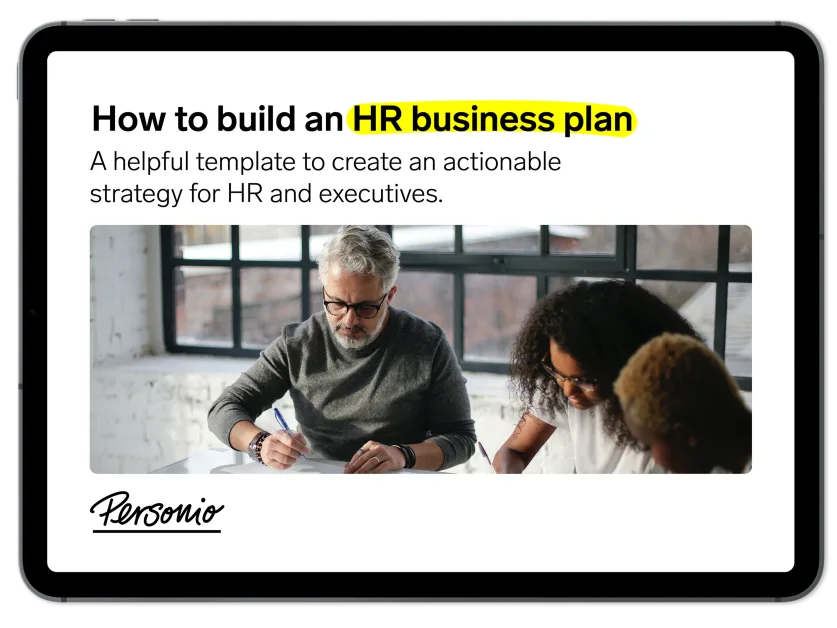
Every success story starts with a plan. Using this template, you can help flesh out a business plan for your HR function with:
Best practices for HR business partnerships
A helpful template to realise your people team’s goals
Tangible ways to action and activate an HR strategy
Download for free here
- Search Search Please fill out this field.
- Human Resource Planning (HRP)
- Understanding HRP
What Is the Goal of Human Resource Planning (HRP)?
- Human Resource Planning FAQs
The Bottom Line
- Business Essentials
Human Resource Planning (HRP) Meaning, Process, and Examples
Adam Hayes, Ph.D., CFA, is a financial writer with 15+ years Wall Street experience as a derivatives trader. Besides his extensive derivative trading expertise, Adam is an expert in economics and behavioral finance. Adam received his master's in economics from The New School for Social Research and his Ph.D. from the University of Wisconsin-Madison in sociology. He is a CFA charterholder as well as holding FINRA Series 7, 55 & 63 licenses. He currently researches and teaches economic sociology and the social studies of finance at the Hebrew University in Jerusalem.
:max_bytes(150000):strip_icc():format(webp)/adam_hayes-5bfc262a46e0fb005118b414.jpg)
What Is Human Resource Planning (HRP)?
Human resource planning (HRP) is the continuous process of systematic planning to achieve optimum use of an organization's most valuable asset—quality employees. Human resources planning ensures the best fit between employees and jobs while avoiding manpower shortages or surpluses.
There are four key steps to the HRP process. They include analyzing present labor supply, forecasting labor demand, balancing projected labor demand with supply, and supporting organizational goals. HRP is an important investment for any business as it allows companies to remain both productive and profitable.
Key Takeaways
- Human resource planning (HRP) is a strategy used by a company to maintain a steady stream of skilled employees while avoiding employee shortages or surpluses.
- Having a good HRP strategy in place can mean productivity and profitability for a company.
- There are four general steps in the HRP process: identifying the current supply of employees, determining the future of the workforce, balancing between labor supply and demand, and developing plans that support the company's goals.
Michela Buttignol
What Is Human Resource Planning (HRP) Used For?
Human resource planning allows companies to plan ahead so they can maintain a steady supply of skilled employees. The process is used to help companies evaluate their needs and to plan ahead to meet those needs.
Human resource planning needs to be flexible enough to meet short-term staffing challenges while adapting to changing conditions in the business environment over the longer term. HRP starts by assessing and auditing the current capacity of human resources.
Here, identifying a company's skill set and targeting the skills a company needs enables it to strategically reach business goals and be equipped for future challenges. To remain competitive, businesses may need advanced skills or to upskill their employees as the market environment evolves and changes.
To retain employees and remain competitive, HRP often looks at organizational design, employee motivation, succession planning, and increasing return on investment overall.
Challenges of Human Resource Planning (HRP)
The challenges to HRP include forces that are always changing. These include employees getting sick, getting promoted, going on vacation, or leaving for another job. HRP ensures there is the best fit between workers and jobs, avoiding shortages and surpluses in the employee pool.
To help prevent future roadblocks and satisfy their objectives, HR managers have to make plans to do the following:
- Find and attract skilled employees.
- Select, train, and reward the best candidates.
- Cope with absences and deal with conflicts.
- Promote employees or let some of them go.
Investing in HRP is one of the most important decisions a company can make. After all, a company is only as good as its employees, and a high level of employee engagement can be essential for a company's success. If a company has the best employees and the best practices in place, it can mean the difference between sluggishness and productivity, helping to lead a company to profitability.
What Are the Four Steps to Human Resource Planning (HRP)?
There are four general, broad steps involved in the human resource planning process. Each step needs to be taken in sequence in order to arrive at the end goal, which is to develop a strategy that enables the company to successfully find and retain enough qualified employees to meet the company's needs.
Analyzing labor supply
The first step of human resource planning is to identify the company's current human resources supply. In this step, the HR department studies the strength of the organization based on the number of employees, their skills, qualifications, positions, benefits, and performance levels.
Forecasting labor demand
The second step requires the company to outline the future of its workforce. Here, the HR department can consider certain issues like promotions, retirements, layoffs, and transfers—anything that factors into the future needs of a company. The HR department can also look at external conditions impacting labor demand , such as new technology that might increase or decrease the need for workers.
Balancing labor demand with supply
The third step in the HRP process is forecasting the employment demand. HR creates a gap analysis that lays out specific needs to narrow the supply of the company's labor versus future demand. This analysis will often generate a series of questions, such as:
- Should employees learn new skills?
- Does the company need more managers?
- Do all employees play to their strengths in their current roles?
Developing and implementing a plan
The answers to questions from the gap analysis help HR determine how to proceed, which is the final phase of the HRP process. HR must now take practical steps to integrate its plan with the rest of the company. The department needs a budget , the ability to implement the plan, and a collaborative effort with all departments to execute that plan.
Common HR policies put in place after this fourth step may include policies regarding vacation, holidays, sick days, overtime compensation, and termination.
The goal of HR planning is to have the optimal number of staff to make the most money for the company. Because the goals and strategies of a company change over time, human resource planning must adapt accordingly. Additionally, as globalization increases, HR departments will face the need to implement new practices to accommodate government labor regulations that vary from country to country.
The increased use of remote workers by many corporations will also impact human resource planning and will require HR departments to use new methods and tools to recruit, train, and retain workers.
Why Is Human Resource Planning Important?
Human resource planning (HRP) allows a business to better maintain and target the right kind of talent to employ—having the right technical and soft skills to optimize their function within the company. It also allows managers to better train the workforce and help them develop the required skills.
What Is "Hard" vs. "Soft" Human Resource Planning?
Hard HRP evaluates various quantitative metrics to ensure that the right number of the right sort of people are available when needed by the company. Soft HRP focuses more on finding employees with the right corporate culture, motivation, and attitude. Often these are used in tandem.
What Are the Basic Steps in HRP?
HRP begins with an analysis of the available labor pool from which a company can draw. It then evaluates the firm's present and future demand for various types of labor and attempts to match that demand with the supply of job applicants.
Quality employees are a company's most valuable asset. Human resource planning involves the development of strategies to ensure that a business has an adequate supply of employees to meet its needs and can avoid either a surplus or a lack of workers.
There are four general steps in developing such a strategy: first, analyzing the company's current labor supply; second, determining the company's future labor needs; third, balancing the company's labor needs with its supply of employees; and fourth, developing and implementing the HR plan throughout the organization.
A solid HRP strategy can help a company be both productive and profitable.
International Journal of Business and Management Invention. " Human Resource Planning-An Analytical Study ," Page 64.
:max_bytes(150000):strip_icc():format(webp)/operational_risk.asp-Final-4be32b4ee5c74958b22dfddd7262966f.png)
- Terms of Service
- Editorial Policy
- Privacy Policy
- Your Privacy Choices

HR Consulting Business Plan Template
Written by Dave Lavinsky

Human Resources Consulting Business Plan
Over the past 20+ years, we have helped over 1,000 entrepreneurs and business owners create business plans to start and grow their human resources consulting businesses. On this page, we will first give you some background information with regards to the importance of business planning. We will then go through an HR consulting business plan template step-by-step so you can create your plan today.
Download our Ultimate Business Plan Template here >
What is an HR Consulting Business Plan?
A business plan provides a snapshot of your human resources consulting business as it stands today, and lays out your growth plan for the next five years. It explains your business goals and your strategy for reaching them. It also includes market research to support your plans.
Why You Need a Business Plan for an HR Consulting Firm
If you’re looking to start an HR consulting business or grow your existing business, you need to write your own business plan. A business plan will help you raise funding, if needed, and plan out the growth of your HR consulting business in order to improve your chances of success. Your business plan is a living document that should be updated annually as your company grows and changes.
Sources of Funding for Human Resources Consulting Businesses
With regards to funding, the main sources of funding for a human resources consulting business are personal savings, credit cards, bank loans and angel investors. With regards to bank loans, banks will want to review your business plan and gain confidence that you will be able to repay your loan and interest. To acquire this confidence, the lender will not only want to confirm that your financials are reasonable, but they will also want to see a professional plan. Such a plan will give them the confidence that you can successfully and professionally operate a business. Personal savings is the most common form of funding for a human resources consulting business. Personal savings and bank loans are the most common funding paths for HR consulting businesses.
Finish Your Business Plan Today!
If you want to start an HR consulting business or expand your current one, you need a business plan. Below we detail what should be included in your own business plan for an HR consulting firm.
Executive Summary
Your executive summary provides an introduction to your own business plan, but it is normally the last section you write because it provides a summary of each key section of your plan.
The goal of your Executive Summary is to quickly engage the reader. Explain to them the type of HR consulting business you are operating and its status. For example, are you a startup, do you have an HR consulting firm that you would like to grow, or are you operating human resources consulting firms in multiple markets?
Next, provide an overview of each of the subsequent sections of your plan. For example, give a brief overview of the HR consulting industry. Discuss the type of HR consulting business you are operating. Detail your direct competitors. Give an overview of your target customers. Provide a snapshot of your marketing plan. Identify the key members of your team. And offer an overview of your financial plan.
Company Analysis
In your company analysis, you will detail the type of HR consulting business you are operating.
For example, you might operate one of the following types of human resources consulting businesses:
- Human Capital Strategy : this type of business focuses on strategic matters such as corporate culture, diversity, and organization design.
- Compensation & Benefits: this type of business involves analyzing and consulting on all aspects of employee compensation, from base pay to secondary benefits, as well as pension and retirement.
- Talent Management: this type of business focuses primarily on recruitment and retention of talent, as well as on talent development.
- Professional Development: this type of business offers services ranging from leadership coaching and development to developing learning management systems.
In addition to explaining the type of HR consulting business you will operate, the Company Analysis section of your business plan needs to provide background on the business.
Include answers to questions such as:
- When and why did you start the business?
- What milestones have you achieved to date? Milestones could include the number of websites launched, the types of sites developed, etc.
- Your legal structure. Are you incorporated as an S-Corp? An LLC? A sole proprietorship? Explain your legal structure here.
Industry Analysis
In your industry analysis, you need to provide an overview of the HR industry.
While this may seem unnecessary, it serves multiple purposes.
First, researching the HR industry educates you. It helps you understand the market in which you are operating.
Secondly, market research can improve your strategy, particularly if your research identifies market trends.
The third reason for market research is to prove to readers that you are an expert in your industry. By conducting the research and presenting it in your plan, you achieve just that.
The following questions should be answered in the industry analysis section of your HR consulting business plan:
- How big is the human resources industry (in dollars)?
- Is the market declining or increasing?
- Who are the key competitors in the market?
- Who are the key suppliers in the market?
- What trends are affecting the industry?
- What is the industry’s growth forecast over the next 5 – 10 years?
- What is the relevant market size? That is, how big is the potential market for your human resources consulting business? You can extrapolate such a figure by assessing the size of the market in the entire country and then applying that figure to your local population.
Customer Analysis
The customer analysis section of your HR consulting business plan must detail the customers you serve and/or expect to serve.
The following are examples of customer segments: financial services companies, government entities, healthcare institutions, and technology companies.
As you can imagine, the customer segment(s) you choose will have a great impact on the type of human resource consulting business you operate. Clearly, government entities would respond to different marketing promotions than technology companies, for example.
Try to break out your target customers in terms of their demographic and psychographic profiles. With regards to demographics, include a discussion of the ages, genders, locations, and income levels of the customers you seek to serve. Because most HR consulting businesses primarily serve customers living in the same city or town, such demographic information is easy to find on government websites.
Psychographic profiles explain the wants and needs of your target customers. The more you can understand and define these needs, the better you will do in attracting and retaining your customers.
Finish Your HR Consulting Business Plan in 1 Day!
Don’t you wish there was a faster, easier way to finish your business plan?
With Growthink’s Ultimate Business Plan Template you can finish your plan in just 8 hours or less!
Competitive Analysis
Your competitive analysis should identify the indirect and direct competitors your business faces and then focus on the latter.
Direct competitors are other human resource consulting firms.
Indirect competitors are other options that customers have to purchase from that aren’t direct competitors. This includes more generalized management consultants or dedicated in-house HR teams.
With regards to direct competition, you want to describe the other HR consulting businesses with which you compete. Most likely, your direct competitors will be human resource consulting businesses located very close to your location.

For each such competitor, provide an overview of their businesses and document their strengths and weaknesses. Unless you once worked at your competitors’ businesses, it will be impossible to know everything about them. But you should be able to find out key things about them such as:
- What types of customers do they serve?
- Do they specialize in specific industries (i.e. healthcare, technology, etc.)?
- What is their pricing (premium, low, etc.)?
- What are they good at?
- What are their weaknesses?
With regards to the last two questions, think about your answers from the customers’ perspective. And don’t be afraid to ask your competitors’ customers what they like most and least about them.
The final part of your competitive analysis section is to document your areas of competitive advantage. For example:
- Will you provide either a wider range or more specialized range of services?
- Will you offer virtual service options?
- Will you provide superior customer service?
- Will you offer better pricing?
Think about ways you will outperform your competition and document them in this section of your plan.
Marketing Plan
Traditionally, a marketing plan includes the four P’s: Product, Price, Place, and Promotion. For an human resource consulting business, your marketing plan should include the following:
Product : In the product section, you should reiterate the type of HR consulting company that you documented in your Company Analysis. Then, detail the specific products you will be offering. For example, in addition to strategic consulting, will your HR consulting business provide compliance consulting?
Price : Document the prices you will offer and how they compare to your competitors. Essentially in the product and price sub-sections of your marketing plan, you are presenting the services you offer and their prices.
Place : Place refers to the location of your company. Document your location and mention how the location will impact your success. For example, will you operate from a physical office, or will you primarily interact with clients online and/or at their place of business? In this section, discuss how your location will affect the demand for your services.
Promotions : The final part of your marketing plan is the promotions section. Here you will document how you will drive customers to your location(s). The following are some promotional methods you might consider:
- Advertising in local papers and magazines
- Reaching out to local websites
- Signs and billboards
- Social media marketing
- Local radio advertising
Operations Plan
While the earlier sections of your business plan explained your goals, your operations plan describes how you will meet them. Your operations plan should have two distinct sections as follows.
Everyday short-term processes include all of the tasks involved in running your HR consulting business, including marketing, providing consultations, building analytics processes, developing and presenting recommendations, etc.
Long-term goals are the milestones you hope to achieve. These could include the dates when you expect to sign your 50 th consulting contract, or when you hope to reach $X in revenue. It could also be when you expect to open an HR consulting business in a new location.
Management Team
To demonstrate your HR consulting business’ ability to succeed, a strong management team is essential. Highlight your key players’ backgrounds, emphasizing those skills and experiences that prove their ability to grow your business.
Ideally you and/or your team members have direct experience in human resources and/or managing HR consulting businesses. If so, highlight this experience and expertise. But also highlight any experience that you think will help your business succeed.
If your team is lacking, consider assembling an advisory board. An advisory board would include 2 to 8 individuals who would act like mentors to your business. They would help answer questions and provide strategic guidance. If needed, look for advisory board members with experience in Human Resources, or successfully running small businesses.
Financial Plan
Your financial plan should include your 5-year financial statement broken out both monthly or quarterly for the first year and then annually. Your financial statements include your income statement, balance sheet and cash flow statements.

In developing your income statement, you need to devise assumptions. For example, will you focus on one client at a time, or will you have teams working on multiple projects at once? And will sales grow by 2% or 10% per year? As you can imagine, your choice of assumptions will greatly impact the financial forecasts for your business. As much as possible, conduct research to try to root your assumptions in reality.
Balance Sheets : Balance sheets show your assets and liabilities. While balance sheets can include much information, try to simplify them to the key items you need to know about. For instance, if you spend $50,000 on building out your business, this will not give you immediate profits. Rather it is an asset that will hopefully help you generate profits for years to come. Likewise, if a bank writes you a check for $50,000, you don’t need to pay it back immediately. Rather, that is a liability you will pay back over time.

In developing your Income Statement and Balance Sheets be sure to include several of the key costs needed in starting or growing an hr consulting business:
- Office build-out
- Cost of buying or leasing a company vehicle
- Cost of office supplies such as computers and software
- Payroll or salaries paid to staff
- Business insurance
- Taxes and permits
- Legal expenses
Attach your full financial projections in the appendix of your plan along with any supporting documents that make your plan more compelling. For example, you might include your office lease, any notable clients you’ve served, or an overview of the services you offer.
Putting together a business plan for your HR consulting business is a worthwhile endeavor. If you follow the template above, by the time you are done, you will have an expert HR consulting business plan; download it to PDF to show banks and investors. You will really understand the HR industry, your competition, and your customers. You will have developed a marketing plan and will really understand what it takes to launch and grow a successful HR consulting business.
HR Consulting Business Plan FAQs
What is the easiest way to complete my hr consulting business plan.
Growthink's Ultimate Business Plan Template allows you to quickly and easily complete your HR Consulting Business Plan.
What is the Goal of a Business Plan's Executive Summary?
The goal of your Executive Summary is to quickly engage the reader. Explain to them the type of HR consulting business you are operating and the status; for example, are you a startup, do you have an HR consulting business that you would like to grow, or are you operating a chain of HR consulting businesses?
Don’t you wish there was a faster, easier way to finish your HR Consulting business plan?
OR, Let Us Develop Your Plan For You
Since 1999, Growthink has developed business plans for thousands of companies who have gone on to achieve tremendous success. Click here to learn about Growthink’s business plan writing service .
Other Helpful Business Plan Articles & Templates

10+ SAMPLE HR Business Plan in PDF
Hr business plan, 10+ sample hr business plan, what is a hr business plan, areas of human resources, tips to improve human resource management , how to create a hr business plan, what is a hr business plan, how do you write a human resources business plan, what are the 7 major hr activities.
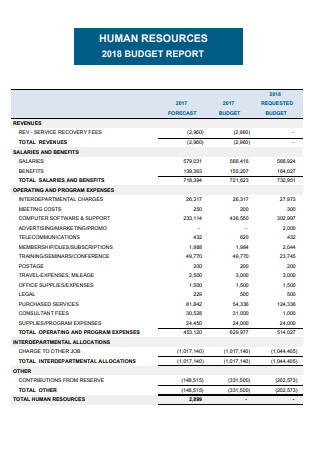
HR Business Plan And Budget
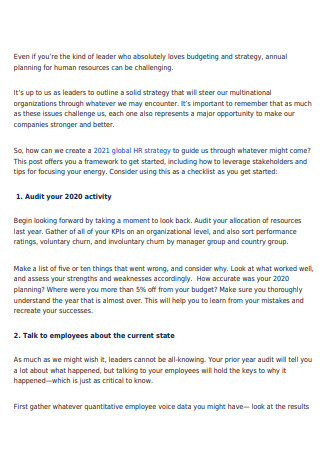
7 Steps for HR Business Plan
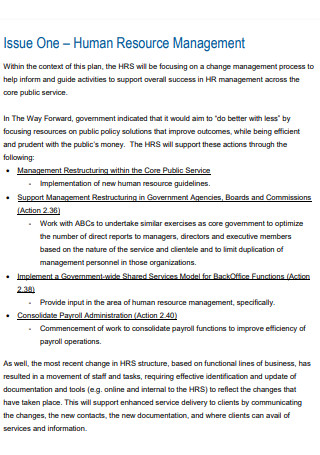
HR Secretariat Business Plan
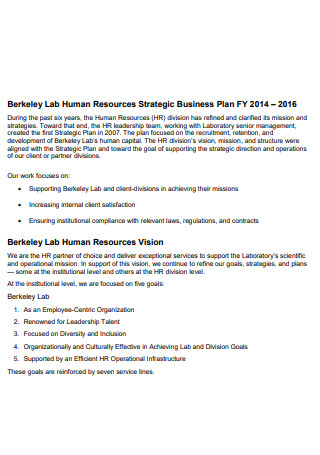
HR Strategic Business Plan
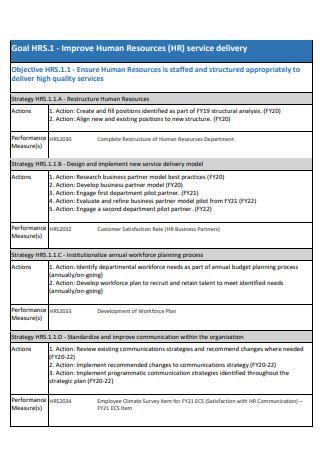
Sample HR Business Plan
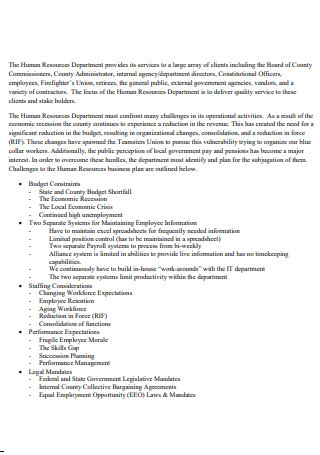
HR Business Plan Example

HR Department Business Plan
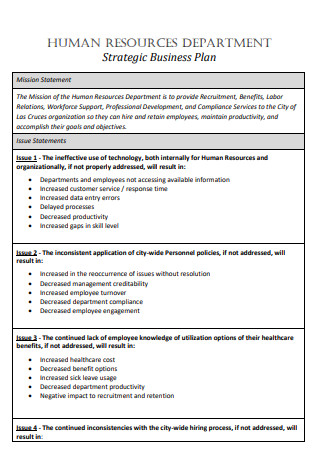
HR Approved Strategic Business Plan
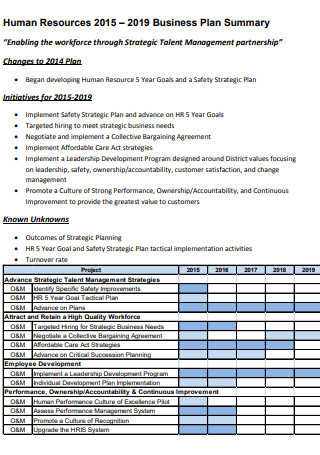
HR Business Plan Summary
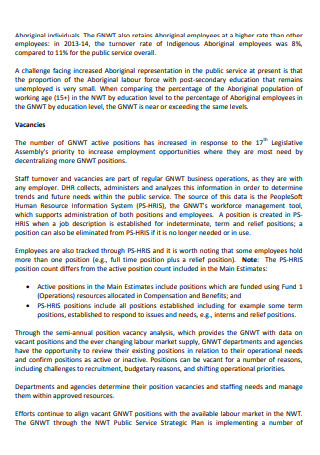
HR Budget and Business Plan
Step 1: establish the objectives, step 2: clarify the roles and job descriptions, step 3: assess the programs and resources, step 4: identify the strategies , share this post on your network, file formats, word templates, google docs templates, excel templates, powerpoint templates, google sheets templates, google slides templates, pdf templates, publisher templates, psd templates, indesign templates, illustrator templates, pages templates, keynote templates, numbers templates, outlook templates, you may also like these articles, 5+ sample investment company business plan in pdf.

What do you do when you have tons of spare cash lying around your home or burning a hole in your wallet or expensive jeans pocket? For some people, the…
41+ SAMPLE Unit Plan Templates in PDF | MS Word

As a teacher, you might know about every school policy, the steps to keep classrooms safe for intellectual development, how to set up an organized classroom, and the proposed…
browse by categories
- Questionnaire
- Description
- Reconciliation
- Certificate
- Spreadsheet
Information
- privacy policy
- Terms & Conditions
Don't bother with copy and paste.
Get this complete sample business plan as a free text document.
Human Resources Consulting Business Plan
Start your own human resources consulting business plan
Human Capital Maximizers
Executive summary executive summary is a brief introduction to your business plan. it describes your business, the problem that it solves, your target market, and financial highlights.">.
Human Capital Maximizers (HCM) is a human resource consulting company located in Portland, Oregon. HCM has expertise in a wide range of HR areas and is targeting the emerging company market. HCM will offer this market the ability to compensate client’s employees with stock options from their company. This will be especially appealing to many start-up companies that find capital scarce.
Major Adversity, the founder and owner will be leveraging his past and current personal/professional relationships to generate business for Human Capital Maximizers. Major will be the sole employee until month six when he will be hiring a human resource specialist/manager to help out with the consulting. Human Capital Maximizers will show increasing profitability over the next three years.

1.1 Keys to Success
The keys to success are to provide a needed service while providing a flexible means of compensation.
1.2 Mission
Human Capital Maximizers’ mission is to provide human resource consulting for emerging companies. We exist to attract and maintain customers. When we adhere to this maxim, everything else will fall into place. Our services will exceed the expectations of our customers.
1.3 Objectives
The objectives for the first three years of operation include:
- To create a service-based company whose primary goal is to exceed customer’s expectations.
- To increase our number of clients served by 20% per year through superior performance and word-of-mouth referrals.
- To develop a sustainable start-up consultancy firm that can survive off its own cash flow and has significant equity holdings in emerging companies.
Company Summary company overview ) is an overview of the most important points about your company—your history, management team, location, mission statement and legal structure.">
Human Capital Maximizers is a HR consultancy firm serving the Portland area market. HCM will be set up as an Oregon Corporation owned by Major Adversity and will focus on emerging companies.
2.1 Company Ownership
Human Capital Maximizers is a privately held Oregon corporation founded and owned by Major Adversity.
2.2 Start-up Summary
Human Capital Maximizers will incur the following start-up expenses:
- Two desks, two chairs, and two lockable file cabinets.
- Two computer systems including a CD-RW, printer and a third computer to serve as a server.
- DSL router and DSL connections.
- Two telephones, fax machine, and copier.
Please note that the following items which are considered assets to be used for more than a year will labeled long-term assets and will be depreciated using G.A.A.P. approved straight-line depreciation method.

Human Capital Maximizers provides human resource consulting to emerging companies in the Portland/Vancouver market. Human Capital Maximizers will charge a below market rate and take stock options in the company. Human Capital Maximizers will provide consulting for the following service areas:
- Human resource management.
- Organizational management.
- Professional development.
- Employee relations.
- Labor relations.
- Benefits and compensation.
- HR policy and procedure.
- Executive search.
- Sexual harassment.
- Position classification.
- Personnel management systems.
- Performance evaluations.
The pricing structure will either be an hourly rate or a per project fee. These options will be settled on in negotiation with the client. In general, Human Capital Maximizers is willing to be as flexible as possible.
Market Analysis Summary how to do a market analysis for your business plan.">
Emerging companies will be the target market for several reasons:
- They are in need of HR services as they are growing rapidly.
- They often do not have a large enough in-house solution as they are increasing in size.
- Capital is a scarce resource for emerging companies so the ability to accept stock options in replace of cash is appealing.
The emerging company market can be further broken down into two categories, technology and non-technology. The significance of the breakdown is not that significant because many of the networking activities are occurring in settings that do not differentiate between technology and non-technology.
4.1 Market Segmentation
Human Capital Maximizers market can be segmented into two different groups, emerging high-tech companies and emerging non-high tech companies. The emerging high-tech companies are going to be the larger of the two segments. Even with the Internet bubble bursting within the last year, there are still many different emerging high-tech companies proliferating. This is evidenced by the Business Journal of Portland which in their annual list of fastest growing companies for this year, 18 of the top 25 were technology companies.
There are also non-technology companies that are emerging in the Portland area and Human Capital Maximizers will be able to serve them as well.

4.2 Target Market Segment Strategy
Human Capital Maximizers’ two markets will be primarily targeted through networking activities. Some networking will be conducted through the Oregon Entrepreneur Association, an association that supports entrepreneurial ventures in the local area. This organization has monthly meetings that are in round-table format, allowing members to socialize.
Human Capital Maximizers will also be networking from personal/professional contacts that Major has developed professionally in the last five years in the HR/start-up industry. HCM will also be relying on word of mouth to grow its customer base.
Strategy and Implementation Summary
Human Capital Maximizers will use their competitive edge of compensation flexibility to attract emerging companies. This competitive advantage is especially valuable to emerging companies who are typically struggling to find enough capital to grow their business. Accepting stock options as compensation is useful because equity is one thing these companies have lots of (that is of course if they haven’t given it all away to the Venture Capitalists).
5.1 Milestones
Human Capital Maximizers will have several milestones early on:
- Business plan completion. This will be done as a roadmap for the organization. This will be an indispensable tool for the ongoing performance and improvement of the company.
- Set up office.
- HCM’s first five customers.
- Profitability.
5.2 Sales Strategy
Brought to you by
Create a professional business plan
Using ai and step-by-step instructions.
Secure funding
Validate ideas
Build a strategy
Major will also be able to speak about Human Capital Maximizers ability to accept options in lieu of cash. This will be appealing to companies, particularly in the current capital market which is quite scarce. Since capital is more difficult to come by now than in the last few years, emerging companies will be excited about this option.
5.2.1 Sales Forecast
The first month will be used to set up the office. Additionally, during the first month Major will be working hard on developing contracts. The second month will see some activity, but it will not be until month six when business will be picking up at a higher rate. Sales will continue to grow through year three.

5.3 Competitive Edge
Human Capital Maximizers competitive edge is their flexibility for compensation. Most or all other companies require compensation to be in the form of cash, for them cash is king. Human Capital Maximizers is able to take stock options in lieu of some cash. While Human Capital Maximizers needs some cash to float the business, it can take up to 75% of its fees in equity. Human Capital Maximizers is able to do this because they have secured an office space that is low in cost, helping them reduce their overhead. In addition, Major’s wife contributes a significant portion of money to the household so Major is not in need of a lot of monthly compensation. This allows him to accept options as payment in hopes of an upside to come several years for now. (Please note the the HR industry, unlike law firms and accounting firms do not run into conflict of interests situations regarding receiving equity as compensation.)
Web Plan Summary
The website will be used as a resource that prospective companies can view to gain more information about the company. In essence it is Human Capital Maximizers’ brochure. On the site there will be information about the management of the company and corresponding bios indicating all of their experience. Also on the website will be a list of present and past clients and information regarding Human Capital Maximizers’ fee structure and willingness to accept stakes of option.
6.1 Website Marketing Strategy
The marketing of the website will consist of submitting it to the popular search engines. The website will be used more as a information tool that prospective companies can be sent to for more information about Human Capital Maximizers as opposed to marketing the website in order for the website to develop new leads.
6.2 Development Requirements
The development requirements will entail hiring an individual (preferably a student for cost saving purposes) to develop and produce the site.
Management Summary management summary will include information about who's on your team and why they're the right people for the job, as well as your future hiring plans.">
Major Adversity, the founder and owner received his undergraduate degree in marketing from Reed College. After completing college Major recognized that he would eventually need to go to graduate school but was not ready to yet.
Major worked in a large bicycle store for four years after college. Major started out as a mechanic but quickly moved up to manager where he was responsible for much of the operation. Some of the new responsibilities that Major enjoyed was the interviewing, selection & hiring, compensation, and employee relations. After fours years in the bike shop Major was looking for a new challenge so he entered the University of Portland to pursue his MBA.
Major received his MBA within two years and went to work for Nike out of school in their HR department. After a year and half Major left Nike to work for a HR consultancy boutique that worked primarily with technology companies, many of them start ups. Major enjoyed this thoroughly because of the dynamic environment that his clients worked in. Major stayed with this firm for a total of four years.
Toward the end of Major’s four years he got married and his wife, as a professional, was contributing large amounts of salary to the household. This led Major to consider opening his own HR consultancy because he would be able to undertake some risk since the household was supported to a large degree by his wife. Additionally, Major was could consider taking equity as compensation because a monthly salary was not a necessity.
7.1 Personnel Plan
Major will work full time for Human Capital Maximizers. By month six Major will have developed more work than he will be able to manage himself and he will hire an additional HR consultant to help him out. The employee will receive a straight salary and will have no future equity options in the client’s companies. This employee will be given HR projects and will do the research and sometimes present the findings to the client, other times will allow Major to present to the client.
Financial Plan investor-ready personnel plan .">
The following sections will outline important financial information. Please note that the stock options granted in lieu of compensation are not entered into the financial plan as they are not yet of value. Upon exercising the options there will be tax consequences (because one of the realizing events has occurred) as well as assets to be accounted for.
8.1 Important Assumptions
The following table details important financial assumptions.
8.2 Break-even Analysis
The Break-even Analysis is shown below.

8.3 Projected Profit and Loss
The following table will indicate projected profit and loss.

8.4 Projected Cash Flow
The following chart and table will indicate projected cash flow.

8.5 Projected Balance Sheet
The following table will indicate the projected balance sheet.
8.6 Business Ratios
The following table outlines some of the more important ratios from the Management Consulting Resources industry. The final column, Industry Profile, details specific ratios based on the industry as it is classified by the Standard Industry Classification (SIC) code, 8742.

The quickest way to turn a business idea into a business plan
Fill-in-the-blanks and automatic financials make it easy.
No thanks, I prefer writing 40-page documents.

Discover the world’s #1 plan building software
- By Job Titles
- By College Majors
- By Companies
- By Location
- Job Search Advice
HR Business Plan: What Is It And What Are Its Steps?
Every company that has an HR department needs an HR business plan. Without it, you will have inconsistencies when you deal with your employees.
Human resources manage the relationship between your company and its employees. Due to this, it is only natural for human resources to have their own plan of approach to their tasks.
Key Takeaways:
An HR business plan is the strategic approach of the human resources department.
The HR business plan should clarify responsibilities, organize its processes, and create performance standards in which to gauge its success.
First assess the current HR situation, then establish goals and strategies to enact those goals for the HR department.
Make sure your HR strategies comply with legal requirements.
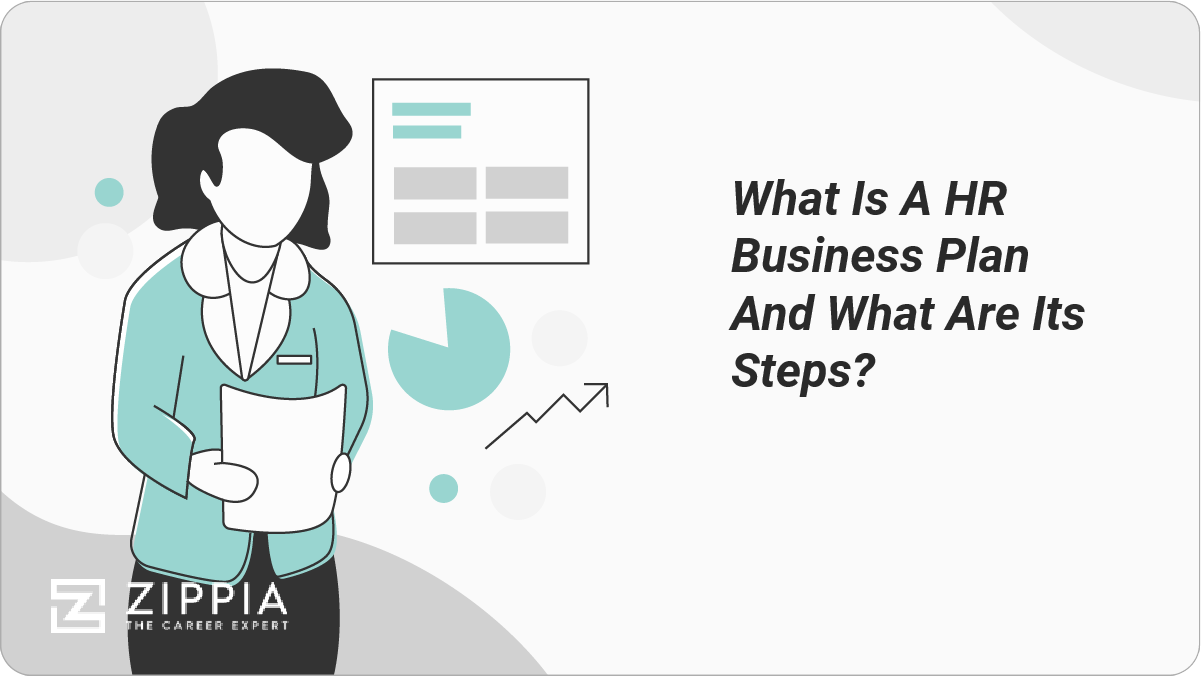
What Is A HR Business Plan?
An HR business plan is a strategic approach your human resource department will follow to accomplish its goals.
Like all business plans, an HR business plan needs to define its objectives, organize systems of measured success, and incorporate a flexible framework. A robust plan can adapt to new scenarios and still focus on its long-term aims.
Though this will vary by company, in general, every HR business plan will want to:
Clarify roles and responsibilities. Focus on the roles and responsibilities of the department and its members. You want to understand the job descriptions of each member of the human resource department. Then decide what the overall purpose of the department is and connect it back to each member. Be aware of any conflicting or contradictory agendas and seek to streamline.
Design and organize processes. Human resources helps hire, train, onboard, and terminate staff. There should be well-detailed plans for each process that keeps the human resources department prepared for any scenario.
Address compensation and benefits. Human resources manages the implementation of benefits and compensation. Therefore, the department’s plan must discuss how this will be handled.
Comply with legal requirements. The human resource department needs to be well-versed in the legal requirements and protections of the employees. The plan should provide a clear compliance with the law.
Create performance standards. A business plan is useless unless it can be evaluated against measures of success. It helps to provide metrics with results to be more objective in analysis.
Tie in to overall business plan. The HR business plan needs to complement the overarching business plan of the company. Avoid any policies or procedures that conflict with the overall business plan.
A human resource business plan will develop these points into a coherent strategy.
Steps To Develop A HR Business Plan
Assess current human resource situation. Before a plan is made, the human resources department and the company executives need to know what they have already. Your company should evaluate the roles and responsibilities of its human resource staff. You will want to see if anything is missing or if there is anything that is expendable.
Establish goals for human resource department. Now that you know what you’re working with, it is time now to think about what you want the human resource department to accomplish. Use the roles and responsibilities you just clarified to arrange practical benchmarks you want the department to make. Make sure goals do not interfere with one another but build toward an overall objective.
Create strategies to enact goals. Once you have your goals in place, it is time to build strategies to accomplish those goals. These strategies should work in tandem, so make sure each one has a logical progression. Like the goals, you do not want your strategies to interfere with one another but instead build towards an overall objective.
Evaluate business plan. Once you enact the plan, you need to make sure you accomplish your goals. Have a feedback system put in place where you can measure the success and failures of your plan. Come up with contingency plans in case your initial plans need to be re-evaluated.
Why Have A Human Resource Business Plan
An HR business plan is needed to establish long-term success with your employees.
Your plan gives focuses on the roles and responsibilities of the department. Human resources play a critical role in the hiring, training, and retention of staff. A business plan will clarify these procedures.
A HR business plan also provides consistency in the implementation of benefits and managing the welfare of the employees.
The human resource business plan empowers the department to perform at its best. In turn, it will help employees be equipped and compensated to perform at their best.
Without a HR business plan, your company is at risk conflicted and contradictory procedures that impede growth and success.
- Guide to Customer Retention
- Management Abbreviations
- Innovation in the Workplace
- Zappos Hiring Case Study
- Why a Clean Workspace Is Good for Business
- Tips for HR Magement Success
- How to Achieve Better Results With Your Team
- Working With a New Client
- What Is Market Mapping
- Managing Unprofessional Online Behavior
- Morale-Boosting Activities
- Understanding Your Team
- Signs of a Bad Hire
- How to Spot Leadership Potential
- Quality Management Implementation
- Goal Setting Tips for Business Owners
- How To Create An Effective HR Business Plan
- How To Avoid Nepotism
- Safeguarding Procedures For HR Managers
- How To Create A Productive Workplace
- The Power Of Strategic Partnerships
- Advice From Successful Business Leaders
- Why You Should Network
- How To Manage Up
- Corporate Retreat Ideas
- What Is An Employee ID?
- What Is Employee Self-Service?
- The 4 Ps Of The Marketing Mix
- How To Be Flexible At Work
- What Is Greenwashing?
- What Does A Chamber Of Commerce Do For Businesses
- How To Write A Sales Introduction Email
- A Guide To The Critical Path Method
- What Is A Change Agent?
- How To Build Your Employer Brand
- How To Have Effective Meetings
Conor McMahon is a writer for Zippia, with previous experience in the nonprofit, customer service, and technical support industries. He has a degree in Music Industry from Northeastern University and in his free time he plays guitar with his friends. Conor enjoys creative writing between his work doing professional content creation and technical documentation.
Find Your Next Hire Out Of Over 5 Million Candidates
Get connected with quality candidates whose resumes on Zippia best fit your job description.
Related posts

How To Understand Your Team

What Is Customer Retention? (Definition, Importance, And Strategies)
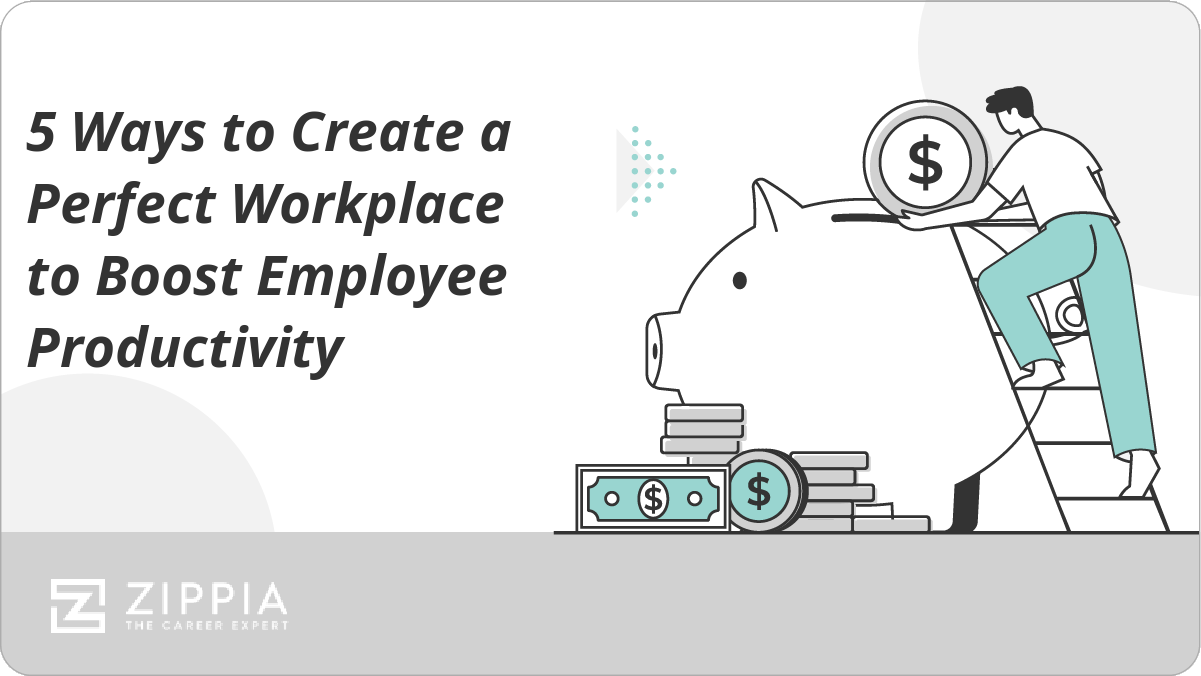
5 Ways to Create a Perfect Workplace to Boost Employee Productivity

15 Ways to Spot Leadership Potential in Your Employees
- Zippia For Employers >
- Hiring Hub >
- Life At Work >
- Become A Better Manager >
- 5 Steps To Creating An Effective Hr Business Plan

Want to create or adapt books like this? Learn more about how Pressbooks supports open publishing practices.
2.2 Writing the HRM Plan
Learning objective.
- Describe the steps in the development of an HRM plan.
As addressed in Section 2.1 “Strategic Planning” , the writing of an HRM strategic plan should be based on the strategic plans of the organization and of the department. Once the strategic plan is written, the HR professional can begin work on the HR plan. This is different from the strategic plan in that it is more detailed and more focused on the short term. The six parts described here are addressed in more detail in Chapter 4 “Recruitment” , Chapter 5 “Selection” , Chapter 6 “Compensation and Benefits” , Chapter 7 “Retention and Motivation” , Chapter 8 “Training and Development” , Chapter 9 “Successful Employee Communication” , Chapter 10 “Managing Employee Performance” , and Chapter 11 “Employee Assessment” .

How Would You Handle This?
Compensation Is a Touchy Subject
As the HR manager, you have access to sensitive data, such as pay information. As you are looking at pay for each employee in the marketing department, you notice that two employees with the same job title and performing the same job are earning different amounts of money. As you dig deeper, you notice the employee who has been with the company for the least amount of time is actually getting paid more than the person with longer tenure. A brief look at the performance evaluations shows they are both star performers. You determine that two different managers hired the employees, and one manager is no longer with the organization. How would you handle this?
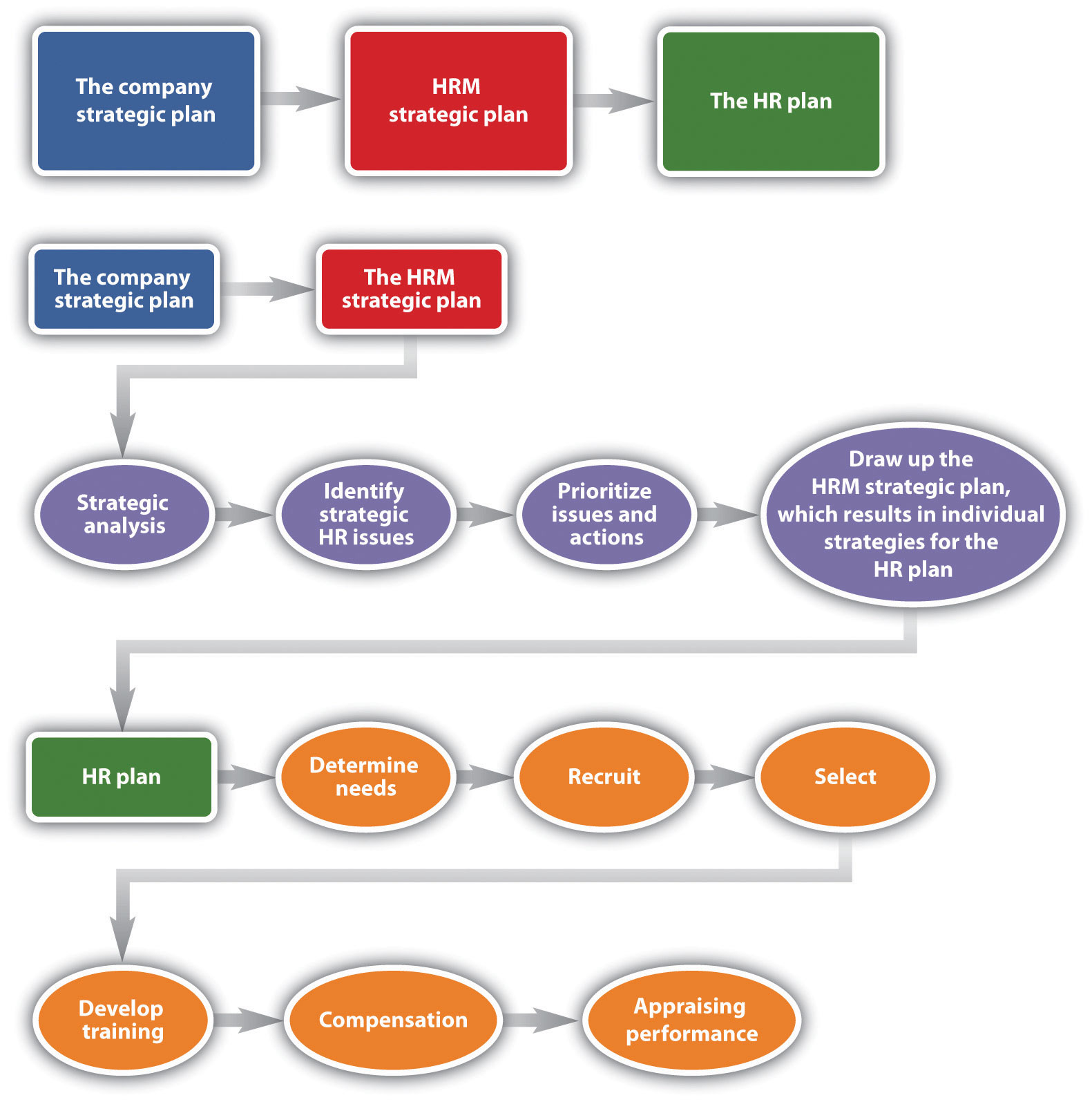
As you can see from this figure, the company strategic plan ties into the HRM strategic plan, and from the HRM strategic plan, the HR plan can be developed.
The six parts of the HRM plan include the following:
- Determine human resource needs. This part is heavily involved with the strategic plan. What growth or decline is expected in the organization? How will this impact your workforce? What is the economic situation? What are your forecasted sales for next year?
- Determine recruiting strategy. Once you have a plan in place, it’s necessary to write down a strategy addressing how you will recruit the right people at the right time.
- Select employees. The selection process consists of the interviewing and hiring process.
- Develop training. Based on the strategic plan, what training needs are arising? Is there new software that everyone must learn? Are there problems in handling conflict? Whatever the training topics are, the HR manager should address plans to offer training in the HRM plan.
- Determine compensation. In this aspect of the HRM plan, the manager must determine pay scales and other compensation such as health care, bonuses, and other perks.
- Appraise performance. Sets of standards need to be developed so you know how to rate the performance of your employees and continue with their development.
Each chapter of this text addresses one area of the HR plan, but the next sections provide some basic knowledge of planning for each area.
Determine Human Resource Needs
The first part of an HR plan will consist of determining how many people are needed. This step involves looking at company operations over the last year and asking a lot of questions:
- Were enough people hired?
- Did you have to scramble to hire people at the last minute?
- What are the skills your current employees possess?
- What skills do your employees need to gain to keep up with technology?
- Who is retiring soon? Do you have someone to replace them?
- What are the sales forecasts? How might this affect your hiring?
These are the questions to answer in this first step of the HR plan process. As you can imagine, this cannot be done alone. Involvement of other departments, managers, and executives should take place to obtain an accurate estimate of staffing needs for now and in the future. We discuss staffing in greater detail in Chapter 4 “Recruitment” .
Many HR managers will prepare an inventory of all current employees, which includes their educational level and abilities. This gives the HR manager the big picture on what current employees can do. It can serve as a tool to develop employees’ skills and abilities, if you know where they are currently in their development. For example, by taking an inventory, you may find out that Richard is going to retire next year, but no one in his department has been identified or trained to take over his role. Keeping the inventory helps you know where gaps might exist and allows you to plan for these gaps. This topic is addressed further in Chapter 4 “Recruitment” .
HR managers will also look closely at all job components and will analyze each job. By doing this analysis, they can get a better picture of what kinds of skills are needed to perform a job successfully. Once the HR manager has performed the needs assessment and knows exactly how many people, and in what positions and time frame they need to be hired, he or she can get to work on recruiting, which is also called a staffing plan . This is addressed further in Chapter 4 “Recruitment” .
Recruitment is an important job of the HR manager. More detail is provided in Chapter 4 “Recruitment” . Knowing how many people to hire, what skills they should possess, and hiring them when the time is right are major challenges in the area of recruiting. Hiring individuals who have not only the skills to do the job but also the attitude, personality, and fit can be the biggest challenge in recruiting. Depending on the type of job you are hiring for, you might place traditional advertisements on the web or use social networking sites as an avenue. Some companies offer bonuses to employees who refer friends. No matter where you decide to recruit, it is important to keep in mind that the recruiting process should be fair and equitable and diversity should be considered. We discuss diversity in greater detail in Chapter 3 “Diversity and Multiculturalism” .
Depending on availability and time, some companies may choose to outsource their recruiting processes. For some types of high-level positions, a head hunter will be used to recruit people nationally and internationally. A head hunter is a person who specializes in matching jobs with people, and they usually work only with high-level positions. Another option is to use an agency that specializes in hiring people for a variety of positions, including temporary and permanent positions. Some companies decide to hire temporary employees because they anticipate only a short-term need, and it can be less expensive to hire someone for only a specified period of time.
No matter how it is done, recruitment is the process of obtaining résumés of people interested in the job. In our next step, we review those résumés, interview, and select the best person for the job.
After you have reviewed résumés for a position, now is the time to work toward selecting the right person for the job. Although we discuss selection in great detail in Chapter 6 “Compensation and Benefits” , it is worth a discussion here as well. Numerous studies have been done, and while they have various results, the majority of studies say it costs an average of $45,000 to hire a new manager (Herman, 1993). While this may seem exaggerated, consider the following items that contribute to the cost:
- Time to review résumés
- Time to interview candidates
- Interview expenses for candidates
- Possible travel expenses for new hire or recruiter
- Possible relocation expenses for new hire
- Additional bookkeeping, payroll, 401(k), and so forth
- Additional record keeping for government agencies
- Increased unemployment insurance costs
- Costs related to lack of productivity while new employee gets up to speed
Because it is so expensive to hire, it is important to do it right. First, résumés are reviewed and people who closely match the right skills are selected for interviews. Many organizations perform phone interviews first so they can further narrow the field. The HR manager is generally responsible for setting up the interviews and determining the interview schedule for a particular candidate. Usually, the more senior the position is, the longer the interview process takes, even up to eight weeks (Crant, 2009). After the interviews are conducted, there may be reference checks, background checks, or testing that will need to be performed before an offer is made to the new employee. HR managers are generally responsible for this aspect. Once the applicant has met all criteria, the HR manager will offer the selected person the position. At this point, salary, benefits, and vacation time may be negotiated. Compensation is the next step in HR management.
Determine Compensation
What you decide to pay people is much more difficult than it seems. This issue is covered in greater detail in Chapter 6 “Compensation and Benefits” . Pay systems must be developed that motivate employees and embody fairness to everyone working at the organization. However, organizations cannot offer every benefit and perk because budgets always have constraints. Even governmental agencies need to be concerned with compensation as part of their HR plan. For example, in 2011, Illinois State University gave salary increases of 3 percent to all faculty, despite state budget cuts in other areas. They reasoned that the pay increase was needed because of the competitive nature of hiring and retaining faculty and staff. The university president said, “Our employees have had a very good year and hopefully this is a good shot in the arm that will keep our morale high” (Pawlowski, 2011).

Determination of compensation systems is a balancing act. Compensation should be high enough to motivate current employees and attract new ones but not so high that it breaks the budget.
Nathan Rupert – Venice Beach Tightrope Walker – CC BY-NC-ND 2.0.
The process in determining the right pay for the right job can have many variables, in addition to keeping morale high. First, as we have already discussed, the organization life cycle can determine the pay strategy for the organization. The supply and demand of those skills in the market, economy, region, or area in which the business is located is a determining factor in compensation strategy. For example, a company operating in Seattle may pay higher for the same job than their division in Missoula, Montana, because the cost of living is higher in Seattle. The HR manager is always researching to ensure the pay is fair and at market value. In Chapter 6 “Compensation and Benefits” , we get into greater detail about the variety of pay systems, perks, and bonuses that can be offered. For many organizations, training is a perk. Employees can develop their skills while getting paid for it. Training is the next step in the HR planning process.
Develop Training
Once we have planned our staffing, recruited people, selected employees, and then compensated them, we want to make sure our new employees are successful. Training is covered in more detail in Chapter 8. One way we can ensure success is by training our employees in three main areas:
- Company culture. A company culture is the organization’s way of doing things. Every company does things a bit differently, and by understanding the corporate culture, the employee will be set up for success. Usually this type of training is performed at an orientation, when an employee is first hired. Topics might include how to request time off, dress codes, and processes.
- Skills needed for the job. If you work for a retail store, your employees need to know how to use the register. If you have sales staff, they need to have product knowledge to do the job. If your company uses particular software, training is needed in this area.
- Human relations skills. These are non-job-specific skills your employees need not only to do their jobs but also to make them all-around successful employees. Skills needed include communication skills and interviewing potential employees.
Perform a Performance Appraisal
The last thing an HR manager should plan is the performance appraisal. While we discuss performance appraisals in greater detail in Chapter 11 “Employee Assessment” , it is definitely worth a mention here, since it is part of the strategic plan. A performance appraisal is a method by which job performance is measured. The performance appraisal can be called many different things, such as the following:
- Employee appraisal
- Performance review
- Career development review
No matter what the name, these appraisals can be very beneficial in motivating and rewarding employees. The performance evaluation includes metrics on which the employee is measured. These metrics should be based on the job description, both of which the HR manager develops. Various types of rating systems can be used, and it’s usually up to the HR manager to develop these as well as employee evaluation forms. The HR manager also usually ensures that every manager in the organization is trained on how to fill out the evaluation forms, but more importantly, how to discuss job performance with the employee. Then the HR manager tracks the due dates of performance appraisals and sends out e-mails to those managers letting them know it is almost time to write an evaluation.
Human Resource Recall
Have you ever been given a performance evaluation? What was the process and the outcome?
Communication Is Key in Performance Evaluations
(click to see video)
Communication is imperative in any workplace, but especially when giving and receiving a performance evaluation.
Key Takeaways
- Human resource planning is a process that is part of the strategic plan. It involves addressing specific needs within the organization, based on the company’s strategic direction.
- The first step in HR planning is determining current and future human resource needs. In this step, current employees, available employees in the market, and future needs are all analyzed and developed.
- In the second step of the process, once we know how many people we will need to hire, we can begin to determine the best methods for recruiting the people we need. Sometimes an organization will use head hunters to find the best person for the job.
- After the recruiting process is finished, the HR manager will begin the selection process. This involves setting up interviews and selecting the right person for the job. This can be an expensive process, so we always want to hire the right person from the beginning.
- HR managers also need to work through compensation plans, including salary, bonus, and other benefits, such as health care. This aspect is important, since most organizations want to use compensation to attract and retain the best employees.
- The HR manager also develops training programs to ensure the people hired have the tools to be able to do their jobs successfully.
- Of the parts of HR planning, which do you think is most difficult, and why? Which would you enjoy the most, and why?
- Why is it important to plan your staffing before you start to hire people?
- What is the significance of training? Why do we need it in organizations?
Crant, J., “How Long Does an Interview Process Take?” Jobsinminneapolis.com, December 2, 2009, accessed October 28, 2010, http://www.jobsinminneapolis.com/articles/title/How-Long-Does-an-Interview-Process-Take/3500/422 .
Herman, S., Hiring Right: A Practical Guide (Thousand Oaks, CA: Sage, 1993), xv.
Pawlowski, S., “Illinois State University to Get Salary Bump,” WJBC Radio, July 11, 2011, accessed July 11, 2011, http://wjbc.com/illinois-state-university-faculty-to-get-salary-bump .
Human Resource Management Copyright © 2016 by University of Minnesota is licensed under a Creative Commons Attribution-NonCommercial-ShareAlike 4.0 International License , except where otherwise noted.
Human Resource Planning (HRP): A Step-By-Step Guide

In today’s rapidly evolving business landscape, having a plan in place for managing your human capital is key — and that’s where human resource planning (HRP) comes in. Human resource planning plays a critical role in making sure that your organization is well-equipped with the right talent at the right time.
Today, we’re walking through the intricacies of HRP so you can implement this practice in your organization.
What Is Human Resource Planning?
Human resource planning, or HRP, stands out as a strategic and methodical process designed to ensure that your organization fully leverages its human capital . It is not a one-time event but rather a continuous journey toward operational excellence and strategic alignment.
At its core, HRP aims to establish a seamless alignment between your employees and their respective roles, meticulously crafting a workforce that is both skilled and adequately sized to meet your organizational demands.
This proactive approach goes a long way in safeguarding your business against potential manpower shortages or surpluses, ensuring that you are well-prepared for the future.
Why Is HRP Important?
HRP is crucial for syncing your current workforce with your future needs. It entails a rigorous analysis of your existing staff, evaluating their skills, competencies, and performance.
This is where metrics come into play, providing a quantitative backbone to your workforce planning efforts. By leveraging data-driven insights, you can make informed decisions, ensuring that your team is not only talented but also aligned with your business objectives.
HRP doesn’t stop there, though — it’s a comprehensive approach that intertwines various facets of human resource management. Staffing, forecasting , performance management, and employee retention all fall under its umbrella. Each of these elements is crucial in building and maintaining a robust workforce.
In terms of staffing, HRP helps you decipher not just the number of employees you need, but also the types of skills and competencies they should possess. Forecasting, on the other hand, empowers your HR department to anticipate future demand, aligning your human resources with your company’s strategic direction.
Performance management is another vital cog in the HRP machine. It ensures that your employees are not just present but also productive and engaged. This, in turn, enhances employee retention, fostering a company culture that values growth, stability, and satisfaction.
HRP even plays a role in shaping your company culture . By aligning your human resources with your company’s needs and values, you create an environment where employees feel valued and aligned with the organization’s goals.
What Are the Advantages of Human Resource Planning?
At its core, human resource planning places the right talent in the right place at the right time, ensuring that your organization’s objectives align with your workforce’s capabilities. Now, let’s talk about the advantages of HRP and how it can lay the foundation for organizational success.
Ensures Effective Management of Current Employees
Strategic workforce alignment is at the heart of HRP. With effective human resource management, HR professionals can ensure that the current workforce is in sync with the company’s overarching goals.
This alignment can translate to better resource allocation, more informed decision-making, and enhanced overall performance.
Reveals Knowledge Gaps in the Workforce
The ever-evolving business landscape means organizations need to be adept at forecasting and adapting — and human resource planning plays a role here.
By examining current employees’ skill sets and comparing them with future needs, knowledge gaps can become more apparent. Addressing these gaps, whether through hiring new talent or upskilling existing employees, helps you ensure that your business stays competitive.
Balances HR Costs
Cost-effectiveness is crucial for the HR planning process. By anticipating future human resource needs, last-minute external recruitments — which often come with high costs — can be avoided.
Plus, recognizing surplus areas within your current workforce allows for internal reassignments to take place, cutting down on recruitment and onboarding expenses.
Keeps Companies Adaptable to Change
Change is constant, especially in today’s fast-paced business world, and human resource planning positions organizations to seamlessly navigate these changes.
From staying updated with industry trends to adapting to regulatory shifts, an HR department’s proactive planning ensures businesses remain resilient and agile. With Mosey , you can more effectively track, manage, and stay on top of changing regulations and requirements, making HR compliance a breeze.
Helps Secure Long-Term Growth
Another key component of HRP is succession planning. Identifying roles and preparing a talent pipeline ensures that your organization isn’t caught off-guard if leadership positions open up.
This planning not only opens the door to future leaders, but also ensures that institutional knowledge is retained, fueling your business’s long-term growth and stability.
Contributes to Organizational Goals
The nexus between human resource planning and organizational goals is undeniable. By streamlining the hiring process, ensuring employee satisfaction , and fostering employee retention, HRP contributes directly to the achievement of business objectives.
When employees see clear growth trajectories and development avenues, their commitment to the company’s vision intensifies, driving the organization closer to its goals.
What Are the Steps for Human Resource Planning?
HRP ensures that businesses are well-equipped, both in terms of the quantity and quality of their workforce, to meet their evolving goals and challenges. So, how can you actually navigate the intricacies of HRP? Here’s a step-by-step walkthrough of the essential phases that make up the human resource planning process.
Analyze Employee Skills and Performance
Human resource planning centers around an understanding of your company’s current workforce.
During this initial phase, the HR department dives into understanding the number of employees, their competencies, qualifications, positions, benefits, and performance levels. This skill inventory ensures that HR professionals have a clear picture of the strengths and areas for improvement in the present workforce.
Research Industry Trends and Forecasts
Effective human resource planning can also help you predict, and plan for, the future, so the next stage is to outline what your company will need in terms of human capital in the foreseeable future.
This forecasting phase requires the HR department to consider various factors, such as potential promotions, retirements, layoffs, and transfers. External conditions, like emerging technologies or industry shifts, can also have a significant impact on labor demand. Ensuring you stay ahead in terms of industry trends helps you align your staffing needs more effectively.
Conduct Demand Forecasting
Having a clear understanding of both the present workforce, potential employees, and future needs is vital to bridge the two through demand forecasting. This step in the HR planning process involves creating a gap analysis that points out discrepancies between the current workforce and future human resource demands.
This type of analysis leads to important questions like:
- Should current employees learn new skills?
- Is there a need for more managers?
- Are all employees fully utilizing their competencies in their present roles?
Answering these questions is key to crafting a strategic human resource plan that aligns with both the present and the future.
Determine Future Human Resource Needs
Once your demand forecasting has highlighted the shortages or surpluses in terms of competencies or number of employees, the next step is to determine the specific future human resource needs.
Whether it’s upskilling the current employees, succession planning for key roles, or identifying the need for new hires, this phase ensures that your business is poised for future growth without any HR hiccups.
Align HR Needs With Organizational Strategy
Human resource planning is intertwined with your broader business goals and strategies. Once your HR needs are identified, it’s important to make sure those needs align with your organizational goals.
This strategic planning phase ensures that every hiring process, training initiative, or retention effort contributes directly to your company’s overarching objectives.
Plan for Employee Development and Training
Once your future human resource needs are aligned with your company strategy, it’s time to implement plans for employee development. This might involve setting up training programs, workshops, or certifications to upskill current employees.
Ensuring your workforce is equipped with the right skills enhances employee satisfaction and retention and gives your business a competitive advantage.
Implement Plan for Forecasted HR Needs
The culmination of the human resource planning process is the implementation of your action plan. Taking cues from the gap analysis and strategic alignment, HR can now roll out a well-thought-out plan.
This could involve tweaking job descriptions, initiating new hiring processes, onboarding new employees, or even revisiting HR policies such as vacation, sick days, or overtime compensation. Collaboration with all departments is key here to ensure the successful execution of your plan, ensuring the HR strategies benefit the organization as a whole.
Support HRP Efforts With Mosey
From identifying when and where to open payroll accounts to managing workers’ compensation and paid family medical leave, Mosey simplifies the complex web of compliance and regulatory demands.
Why not explore how Mosey can streamline your HR processes and compliance management ? Our platform is designed to provide clarity, guidance, and ease, allowing you to focus on what matters most — nurturing and growing your most valuable asset, your employees. Try Mosey today .
Read more from Mosey:
- Compliance Automation: How It Works & Its Value
- Sole Proprietorship vs. LLC: Key Differences
- What Is a Foreign Corporation? FAQs Explained
- What Is a C Corporation (C Corp)?
- What Is Payroll? A Guide for Small Business Payroll
- What Is a Legal Entity? Definition & Examples
- What Is SUI? State Unemployment Insurance FAQs
Review your compliance risks, free.
Use our compliance checkup to learn more about what to do to be compliant in any state! It's free and takes less than five minutes.
Ready to get started?
Sign up now or schedule a free consultation to see how Mosey transforms business compliance.

Mosey has everything you need to get compliant in all 50 states in one, easy to use, platform.
Sling is now Sling by Toast! Learn more
More Features

- Restaurants
- Get Started

Human Resource Planning: Definition, Objectives, And Steps
- Employee Management , Templates & Guides
Human resource planning is an essential part of every successful business. Unfortunately, many managers neglect this vital practice for other, easier tasks because they don’t understand what this type of planning requires.
Other times, managers may not understand how pivotal human resource planning is to their long-term corporate strategy and the ultimate success of their business.
That’s where Sling can help. In this article, we define human resource planning, outline its objectives, and provide a step-by-step guide to implementing this crucial practice in your business.
Table Of Contents
Human Resource Planning Defined
Human resource planning objectives, hrp vs. shrm, hrp and organizational strategy, steps in human resource planning, why human resource planning is important, challenges of human resource planning, scheduling and communication for effective hrp.
Human resource planning (or HRP for short) is the ongoing process of systematically planning ahead to optimize and maximize your business’s most valuable asset — high-quality employees .
When you incorporate HRP into every aspect of your strategy — functional , business , or organizational — you streamline the process of creating the best fit between available jobs and available employees. All while avoiding a shortage or surplus in your workforce.
As simple as that may sound, there’s more to human resource planning than setting up a system and implementing it in your organization.
The objectives of HRP are very specific and can mean the difference between success or stagnation. We’ll discuss those objectives in the next section.

As we mentioned earlier, human resource planning is about matching the right employees with the right jobs in your business.
You can do this while interviewing prospective employees, or even during the performance review of a long-time team member who is reaching out for more responsibility.
While matching employees to jobs is a big part of human resource planning, the goals of HRP don’t stop there. Other HRP objectives include:
- Adapting to rapid technology changes
- Powering product innovation
- Adjusting to a more globalized economy
- Preparing for generational and cultural shifts
- Anticipating job and skill changes
- Facilitating growth
- Improving business operations
- Mitigating risk
- Preventing talent shortage or surplus
- Complying with local, state, and federal regulations
- Implementing a successful onboarding process
As you can see, HRP is integral to the successful operation of your business and its growth over both the short- and long-term.
Because this process is connected to every aspect of your business , you may feel overwhelmed by the prospect of creating a new HRP strategy.
Don’t let this prevent you from implementing a system that can revolutionize the way your business operates — both now and in the future .
Keep in mind that human resource planning doesn’t have to address all of the objectives on this list from the moment it goes into effect. Start small and expand into different areas once you’ve addressed one or two objectives.
Later on in this article, we discuss a step-by-step method for producing a human resource planning strategy for your business.
But, first, let’s take a moment to discuss one of the most-confused aspects of human resource planning: how it differs from strategic human resource management.

Before we delve into the minutiae of human resources , let’s put the two relevant definitions side-by-side to see how they compare.
Human Resource Planning : HRP is the ongoing process of systematically planning ahead to optimize and maximize your business’s most valuable asset — high-quality employees.
Strategic Human Resource Management : SHRM is a holistic approach to assembling the best team for your business’s growth and success.
At first glance, it may appear that human resource planning is the same thing as strategic human resource management under a different name. They seem so similar because one is actually part of the other.
In this case, HRP is a small part of SHRM. Viewed from a different perspective, SHRM contains and governs HRP.
It’s very much like a set of nesting dolls: the smallest one (HRP) fits nicely into the next largest (SHRM), which, in turn, fits into the next largest, and so on.
For practical purposes, it helps to think about human resource planning as the frontline, boots-on-the-ground application, while strategic human resource management is the guiding principle behind those applications.
In other words, SHRM is the why to HRP’s what.
Another way to think about SHRM and HRP is to view your business as a large, complicated machine.
Human resource planning is one component (a gear, for example) that works with other similar components (e.g., production, logistics, shipping, management, etc.) to keep the machine running.
Strategic human resource management, on the other hand, takes a step back and analyzes the machine itself.
SHRM looks at the performance of each component (each department in your business), how they work together to make everything run smoothly, and what the business as a whole can do to improve.

Let’s return, for a moment, to the example of the nesting dolls mentioned earlier.
We established that human resource planning is the smallest doll and that strategic human resource management is the next largest doll. But what comes after that?
What’s the next largest doll in the series? Organizational strategy.
Organizational strategy , at its most basic, is a plan that specifies how your business will allocate resources to support infrastructure, production, marketing, inventory , and other business activities.
How does this affect human resource planning? Organizational strategy directs strategic human resource management directs human resource planning.
In many ways, the strategy side of your business mirrors the relationship between SHRM and HRP.
Organizational strategy is subdivided into three distinct categories: corporate strategy, business strategy, and functional strategy. Just like SHRM and HRP, each level is a part of the one above it.
Corporate level strategy is the main purpose of your business — it’s the destination toward which your business is moving.
Business level strategy is the bridge between corporate level strategy and much of the “boots-on-the-ground” activity that occurs in functional level strategy.
Functional level strategy is the specific actions and benchmarks you assign to departments and individuals that move your business toward the goals created by your corporate level strategy. They are a direct offshoot of your business level strategies.
With those categories in mind, we start to see the bigger picture of your business. SHRM is a component of your business level strategy, while HRP is a component of your functional level strategy.
Now that you understand the theory behind human resource planning, let’s focus our attention on the practice itself.

1) Analyze Organizational Strategy
Any successful workforce-management program — including human resource planning — is a direct offshoot of your business’s organizational strategy.
Therefore, you should always start your HRP process by analyzing the goals and plans of your organization. With those strategies in mind, you can then move on to crafting a general human resources mission statement.
From there, you can work your way through the various departments in your business to address issues such as:
- Recruitment
- Employee relations
When you have that information written down, you can craft a human resource plan to help your business reach and maintain its goals.
2) Inventory Current Human Resources
After analyzing your organizational strategy, it’s time to take stock of your business’s current human resources.
In the process, it’s beneficial to investigate such variables as:
- Total number of team members you employ
- Who works in what department
- Skills of each employee
- Performance reviews
- Team and individual potential
With that data in hand, you then make sure that your existing workforce is large enough and skilled enough to cover current demands before moving on to the next step in this guide.
3) Forecast The Future Of Your Workforce
Step three is all about planning, prediction, and preparing for the future.
Guided by your organizational strategy and your current employee data, do your best to forecast what the future of your workforce will look like. Be sure to incorporate any goals and plans into your forecast.
Examine variables such as:
- New product offerings
- New services
- A second (or third) location
- Labor costs
- Vendor and supplier relations
- Cost of goods sold
A forecast of this type, coupled with the workforce data from step two, gives you an accurate picture of where your business is right now and where you want it to be five, 10, even 15 years down the road.
4) Estimate Gaps
Armed with the information you’ve produced so far, you can now estimate whether or not there are any gaps in your human resource strategy.
Will you need more employees to get your business from the present to where you want it to be in the future? If so, how many? Will you need fewer employees? If so, how many?
Does your forecast call for a reallocation or redistribution of current team members? If so, how would you go about doing this?
Once you’ve estimated the gaps between your current and future workforce numbers, you can move on to step five, where all the planning and brainstorming comes to fruition.
5) Formulate An Action Plan
Formulating an action plan is where the rubber meets the road, so to speak.
Your action plan should take into account all the analysis that came before it — organizational strategies, current HR inventory, HR forecast, and gaps between present and future — to create a step-by-step system for taking your business from point A to point B.
The action plan will be different for every business. Some businesses may need to begin recruiting and training . Other businesses may need to promote or transition their existing workforce.
Still other businesses may need to develop a retirement program or a redeployment process to deal with surplus employees.
When crafting your plan, start with the theoretical — evolve from X to Y — and then move on to actionable steps that your HR department can take — hire and retain two new team members every year, for example — to transform the theory into reality.
With these steps in mind, you can implement a successful human resource planning system into your business, no matter how many employees you have.
As you go about implementing your business’s HRP, don’t neglect the foundation of all good employer/employee relations: scheduling and communication. We’ll discuss this topic at the end of the article.
6) Integrate With The Rest Of The Company

Now that you’ve got an action plan, your human resource planning efforts will start to yield results.
That said, the integration stage is the most difficult of the entire process, so be ready for some speed bumps.
Without proper preparation — and even with proper preparation, in some cases — both management and frontline employees may show resistance to the proposed changes.
In addition, all departments within your business work together in one way or another (even if it doesn’t at first appear so). This makes the integration phase challenging on many levels.
One of the best ways to integrate human resource planning into the rest of the company is to start with the recruitment , hiring , and training practices in your business.
Once you’ve brought in new, high-potential employees and have begun funneling them into the various departments, you can start to make other changes to accommodate these new hires.
Integrating slowly and pairing the changes with new employees who will further the goals and productivity of each department makes putting your new human resource planning into place much easier.
7) Monitor, Evaluate, And Adjust
The final step in human resource planning is to monitor the new practices, evaluate them for their effectiveness, and adjust as necessary.
In addition to monitoring each department and your business as a whole, it’s also beneficial to zoom in on how any changes made affect the individual employee.
To take the pulse of the front-line worker, include questions about your human resource planning during mid-year reviews and performance appraisals . You can even ask for their opinion when you have them complete an employee self-evaluation .
Monitoring and evaluating in this way will help you get a detailed view of how any new policies, procedures, and practices affect the men and women in the trenches.
Once you have all the information you need, you can then take steps to adjust your human resource planning accordingly.
For that, it’s best to return to the top of this list and start again at step one, incorporating what you learned from the previous run-through.
In essence, then, you can view this list as less of a straight line and more of a circle, with step seven leading directly back into step one. As such, your HRP should be in a constant state of development.

Your business can function without HRP, and, yes, it can be a challenge to get the plans in place, but the benefits far outweigh the drawbacks.
Among other things, HRP can help your business:
- Anticipate workforce needs in a changing market
- Plan for short-term and long-term growth
- Improve operations
- Facilitate staffing changes
- Avoid talent shortage
- Stay ahead of the technology curve
- Remain agile as the market evolves
- Maintain compliance with government laws and regulations
Human capital management is one of the most important parts of your business. HRP helps you maximize that potential.
As beneficial and powerful as human resource planning is, it is not without its drawbacks and challenges.
For one thing, HRP relies on forecasting, which is an imperfect art and is never — and can never be — 100% accurate.
Similarly, you can never account for the ambiguity in the market and the rapid change that could come out of nowhere.
There may be some error when you forecast the future of your workforce. That error will affect the other steps on this list for the good or the bad (depending on how accurate your forecast is).
Realistically, though, that can’t be helped and all you can do is give it your best shot. If you discover errors in your forecasting, you can always return to step one and start the process over with the new information.
Other challenges of the human resource planning process include:
- Resistant workforce
- Inefficient information systems
- Overall cost
- Time and effort
That said, when you are aware of these challenges going in, you can take steps to overcome them right away so that you can get to the benefits sooner.

Scheduling and communication are key components of an effective human resource planning process.
Your team’s schedule is the cornerstone on which you build their work experience. If the schedule doesn’t satisfy all parties — employees and management alike — your business suffers.
Similarly, clear communication with all your employees fosters a strong team and keeps everyone in the loop about employee performance, inventory, standard operating procedures , customer satisfaction , and your business as a whole.
In the 21st century, the best schedules are created and the best communication maintained with help from dedicated software like Sling .
Whether your business has one shift or three, offers flextime or a compressed workweek , or works a 9-to-5 work schedule or a 9/80 work schedule , Sling can help simplify the schedule-creation process.
And with advanced communication features built in, Sling is the only tool you’ll ever need to keep your employees informed about your business and connected with each other.
In fact, we developed the Sling app to streamline communication as well as make scheduling, tracking labor, finding substitutes, assigning tasks, and building employee engagement extremely simple.
There are so many ways Sling can help improve your human resource planning that we don’t have room to talk about them here. So instead of reading about it, why not try it out?
Sign up for a free account and see for yourself how Sling can help you implement the necessary strategies to make your team and your business successful.
For more free resources to help you manage your business better, organize and schedule your team, and track and calculate labor costs, visit GetSling.com today.
See Here For Last Updated Dates: Link
This content is for informational purposes and is not intended as legal, tax, HR, or any other professional advice. Please contact an attorney or other professional for specific advice.
Find the article useful? Share with others:

Related articles

Strategic Human Resource Management: What Is It And Why Is It Important?
Most businesses have some type of human resource management plan — even if it�...

Human Resource Management: What Is It And Why Is It Important?
Regardless of the size of your team, human resource management is crucial for th...

What Is a Human Resource Management System (HRMS)?
A human resource management system can help your business get ahead in the game....
Get started today
Schedule faster, communicate better, get things done.
HR Consulting Business plan Template
Written by Dave Lavinsky
HR Consulting Business Plan
You’ve come to the right place to create your Human Resources Consulting business plan.
We have helped over 1,000 entrepreneurs and business owners create business plans and many have used them to start or grow their HR Consulting businesses.
Below is a template to help you create each section of your Human Resource business plan.
Executive Summary
Business overview.
HR Solutions is a startup human resources company located in Spokane, Washington. The company is founded by Tremaine Jackson, a former human resources manager in a large retail company. Tremaine led a team of twenty human resources employees in overseeing all aspects of human resources for the employer and developed a unique application that he has decided to introduce in his new company, HR Solutions.
HR Solutions will be the comprehensive leader in human resource training, management, negotiations, and solutions-finding company in the state of Washington. They will provide everything human resource personnel need to hire and effectively onboard new employees, as well as everything needed to maintain proper records, effectively cover communication and employee relations, and become proactive about potential conflicts.
Product Offering
The following are the services that HR Solutions will provide:
- Proprietary app that creates comprehensive HR management plans
- Training to maximize personnel potential
- Assistance in compliance with laws and regulations
- Curated HR solutions to solve employee issues
- Assistance in establishing productive work environments
- Onboarding from A to Z
- “Support Cadre” for HR management personnel
- Recruitment and talent acquisition training
- Organizational process-and-procedure manual
Customer Focus
HR Solutions will target small-to-large businesses in the Spokane, Washington region. HR Solutions will also target Washington state with select online training programs and sales of the proprietary HR app. HR Solutions will target C-suite executives in Spokane.
Management Team
HR Solutions will be owned and operated by Tremaine Jackson. He recruited his former administrative assistant, Sharlene Harris, to be his Administrative Manager in HR Solutions, where she will provide oversight of all personnel and HR responsibilities within the company itself. He also recruited Mason Wright, a former associate and HR manager, to be the Senior HR Advisor within the startup; he will lead the other HR managers in their roles as client-focused solution providers.
Tremaine Jackson is a graduate of the University of Washington in Seattle, where he majored in Human Resource Development. He has been a human resources manager in a large retail company, where he led a team of twenty human resources employees in overseeing all aspects of human resources for his employer and he developed a unique application that he has decided to introduce in his new company, HR Solutions. Former clients and associates have indicated they will follow him when he establishes HR Solutions.
Sharlene Harris holds a bachelor’s degree in Business Administration from Spokane College. She has been Tremaine’s administrative assistant for ten years and her new role will be the Administrative Manager in HR Solutions. She will provide oversight of all personnel and HR responsibilities within the company itself.
Mason Wright, a former associate and HR manager, developed a large following of loyal clients. He will be the Senior HR Advisor within the startup; he will lead the other HR managers in their roles as client-focused solution providers. His clients have indicated that they will follow him into the startup business.
Success Factors
HR Solutions will be able to achieve success by offering the following competitive advantages:
- Friendly, knowledgeable, and highly-qualified team of HR Solutions
Financial Highlights
HR Solutions is seeking $200,000 in debt financing to launch HR Solutions. The funding will be dedicated toward securing the office space and purchasing office equipment and supplies. Funding will also be dedicated toward three months of overhead costs to include payroll of the staff, rent, and marketing costs for the print ads and marketing costs. The breakout of the funding is below:
- Office space build-out: $20,000
- Office equipment, supplies, and materials: $10,000
- Three months of overhead expenses (payroll, rent, utilities): $150,000
- Marketing costs: $10,000
- Working capital: $10,000
The following graph outlines the financial projections for HR Solutions.
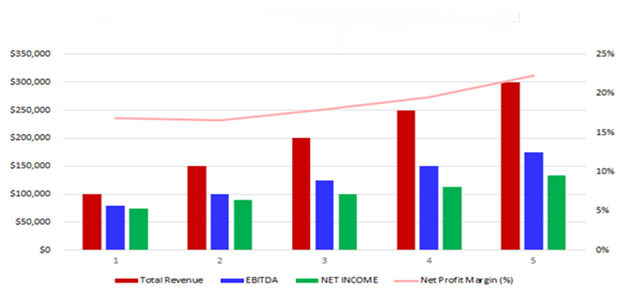
Company Overview
Who is hr solutions.
HR Solutions is a newly established, full-service human resource company in Spokane, Washington. HR Solutions will be the most reliable, cost-effective, and effective choice for HR managers and leaders in Spokane. Certain online programs and the proprietary app will also be the most effective and productive options for HR personnel throughout the state of Washington. HR Solutions will provide a comprehensive menu of training, recruitment, personnel, solution-finding services for any company to utilize. Their full-service approach includes a comprehensive set of training, management, and solution options.
HR Solutions will be able to provide superior HR support and solutions to every business. The team of professionals are highly qualified and experienced in onboarding, training and creating solutions for every human resource quandary. HR Solutions removes all headaches and issues of the human resource personnel and ensures clients find the best answers to all their HR needs with the outstanding customer service found at HR Solutions.
HR Solutions History
HR Solutions is owned and operated by Tremaine Jackson. Tremaine Jackson is a graduate of the University of Washington in Seattle, where he majored in Human Resource Development. He has been a human resources manager in a large retail company, where he led a team of twenty human resources employees in overseeing all aspects of human resources for his employer and he developed a unique application that he has decided to introduce in his new company, HR Solutions. Former clients and associates have indicated they will follow him when he establishes HR Solutions.
Since incorporation, HR Solutions has achieved the following milestones:
- Registered HR Solutions, LLC to transact business in the state of Washington.
- Has a contract in place for a 20,000 square foot office space within a downtown Spokane building.
- Reached out to numerous former clients and contacts to include those who will refer and recommend HR Solutions.
- Began recruiting a staff of ten HR managers and three office personnel to work at HR Solutions.
HR Solutions Services
The following will be the services HR Solutions will provide:
Industry Analysis
The human resources industry is expected to grow during the next five years to over $35 billion. The growth will be driven by an increased number of young employees who require extensive training and onboarding. The growth will be driven by an increased need for employees as the older demographic employee retires. The growth will be driven by an increase in the number of employees who are new to the U.S. and require assistance in onboarding and training. The growth will be driven by new technological advances that are not yet known. Costs will likely be reduced as new applications, such as the one created by HR Solutions, are created and introduced into the industry.
Customer Analysis
Demographic profile of target market, customer segmentation.
HR Solutions will primarily target the following customer profiles:
- Small-to-large businesses in the Spokane region
- Small-to-large businesses throughout Washington (select programs/app)
- C-suite executives in Spokane
Competitive Analysis
Direct and indirect competitors.
HR Solutions will face competition from other companies with similar business profiles. A description of each competitor company is below.
Human Resource RX
Human Resource RX was founded in 2005 by Reme and Janette Choux. As former human resource negotiators within a large firm, they developed distinctive programs that can help HR managers reduce conflicts in the workplace. In addition, the programs assist personnel in recuperating from workplace trauma and other difficulties or issues that arise in the office.
Human Resource RX, headquartered in Spokane, claims to be the “Best HR Prescription” for companies that require assistance in the form of management and oversight in trauma or difficulty. Human Resource RX also assists in compliance issues within the state of Washington, bringing expert advice into thorny issues that can potentially lead to litigation. The company has three offices throughout Washington, each with a staff of twelve “HR managers” who service local businesses. The company has maintained a good standing within the state of Washington, although there have been two separate issues of incorrect legal advice offered to clients. The matters were both brought by former clients to the court system and eventually resolved.
Premier Human Resource Associates
Premier Human Resource Associates is owned and operated by Tami Watson, an HR executive with over thirty years of experience. She is joined in the company by her daughter, Reyna Watson, a recent graduate of Spokane College, where she earned a bachelor’s degree in Communication. Premier Human Resource Associates is located in Spokane and offers an extensive onboarding and training program to support HR managers within local hospitals and medical clinics.
The bulk of services provided to HR managers includes various specific onboarding and training needs of nurses, LVNs, and other care providers. Attention is given in particular to the processes of sanitation and hygienic practices, along with the methods of communication used within these specific businesses. To date, the company has assisted in successfully onboarding over 5,000 nurses and other caregivers.
Transport HR Training
Transport HR Training was started in 1997 as a result of multiple difficult issues within the truck driving industry in Washington. In the decades since, Transport HR Training has established the full spectrum of services and products for HR associates in the long-haul and short-transport businesses. Specific practices and procedures relating to, in particular, medical issues of drivers, have been developed to smooth the HR process and align truck drivers with services they need. Transport HR Training offers a comprehensive package of services that includes negotiation in conflict, onboarding specifics, driver training, legal procedures and processes, and other truck driver-specific conditions.
Competitive Advantage
HR Solutions will be able to offer the following advantages over their competition:
Marketing Plan
Brand & value proposition.
HR Solutions will offer the unique value proposition to its clientele:
Promotions Strategy
The promotions strategy for HR Solutions is as follows:
Word of Mouth/Referrals
HR Solutions has built up an extensive list of clients and contacts over the years by providing exceptional service and expertise to their clients. Associates will follow them to their new company and help spread the word of HR Solutions.
Professional Associations and Networking
HR Solutions will extensively network throughout HR association and industry events. They will take an active role in leadership wherever invited to do so and will work to support the efforts of all associates or members.
Website/SEO Marketing
HR Solutions will fully utilize their website. The website will be well organized, informative, and list all the services that HR Solutions provides. The website will also list their contact information and list their available times to make reservations during the week. This will allow HR managers to speak with HR Solutions when most beneficial to the client. The website presence will engage SEO marketing tactics so that anytime someone types in the Google or Bing search engine “Human Resources company” or “HR near me”, HR Solutions will be listed at the top of the search results.
The pricing of HR Solutions will be moderate and on par with competitors so customers feel they receive excellent value when purchasing their services.
Operations Plan
The following will be the operations plan for HR Solutions. Operation Functions:
- Tremaine Jackson will be the Owner and President of the company. He will oversee all staff and manage client relations. He has spent the past year recruiting the following staff:
Milestones:
HR Solutions will have the following milestones completed in the next six months.
- 5/1/202X – Finalize contract to lease office space
- 5/15/202X – Finalize personnel and staff employment contracts for the HR Solutions
- 6/1/202X – Finalize contracts for new HR Solutions clients
- 6/15/202X – Begin networking at industry events
- 6/22/202X – Begin moving into HR Solutions office
- 7/1/202X – HR Solutions opens its office for business
Financial Plan
Key revenue & costs.
The revenue drivers for HR Solutions are the fees they will charge to clients for their services, online training and proprietary app.
The cost drivers will be the overhead costs required in order to staff HR Solutions. The expenses will be the payroll cost, rent, utilities, office supplies, and marketing materials.
Funding Requirements and Use of Funds
HR Solutions is seeking $200,000 in debt financing to launch its human resources company. The funding will be dedicated toward securing the office space and purchasing office equipment and supplies. Funding will also be dedicated toward three months of overhead costs to include payroll of the staff, rent, and marketing costs for the print ads and association memberships. The breakout of the funding is below:
Key Assumptions
The following outlines the key assumptions required in order to achieve the revenue and cost numbers in the financials and in order to pay off the startup business loan.
- Number of Clients Per Month: 40
- Average Revenue per Month: $80,000
- Office Lease per Year: $100,000
Financial Projections
Income statement, balance sheet, cash flow statement, human resource business plan faqs, what is a human resource business plan.
A human resource business plan is a plan to start and/or grow your human resource business. Among other things, it outlines your business concept, identifies your target customers, presents your marketing plan and details your financial projections.
You can easily complete your Human Resource business plan using our Human Resource Business Plan Template here .
What are the Main Types of Human Resource Businesses?
There are a number of different kinds of human resource businesses , some examples include: Human Capital Strategy, Compensation & Benefits, Talent Management, and Professional Development.
How Do You Get Funding for Your Human Resource Business Plan?
Human Resource businesses are often funded through small business loans. Personal savings, credit card financing and angel investors are also popular forms of funding.
What are the Steps To Start a Human Resource Business?
Starting a human resource business can be an exciting endeavor. Having a clear roadmap of the steps to start a business will help you stay focused on your goals and get started faster.
1. Develop A Human Resource Business Plan - The first step in starting a business is to create a detailed human resource business plan that outlines all aspects of the venture. This should include potential market size and target customers, the services or products you will offer, pricing strategies and a detailed financial forecast.
2. Choose Your Legal Structure - It's important to select an appropriate legal entity for your human resource business. This could be a limited liability company (LLC), corporation, partnership, or sole proprietorship. Each type has its own benefits and drawbacks so it’s important to do research and choose wisely so that your human resource business is in compliance with local laws.
3. Register Your Human Resource Business - Once you have chosen a legal structure, the next step is to register your human resource business with the government or state where you’re operating from. This includes obtaining licenses and permits as required by federal, state, and local laws.
4. Identify Financing Options - It’s likely that you’ll need some capital to start your human resource business, so take some time to identify what financing options are available such as bank loans, investor funding, grants, or crowdfunding platforms.
5. Choose a Location - Whether you plan on operating out of a physical location or not, you should always have an idea of where you’ll be based should it become necessary in the future as well as what kind of space would be suitable for your operations.
6. Hire Employees - There are several ways to find qualified employees including job boards like LinkedIn or Indeed as well as hiring agencies if needed – depending on what type of employees you need it might also be more effective to reach out directly through networking events.
7. Acquire Necessary Human Resource Equipment & Supplies - In order to start your human resource business, you'll need to purchase all of the necessary equipment and supplies to run a successful operation.
8. Market & Promote Your Business - Once you have all the necessary pieces in place, it’s time to start promoting and marketing your human resource business. This includes creating a website, utilizing social media platforms like Facebook or Twitter, and having an effective Search Engine Optimization (SEO) strategy. You should also consider traditional marketing techniques such as radio or print advertising.
Human Resource Planning: The Ultimate Guide
Have you ever wondered how a company decides exactly how many people to hire, what skills they should have, and the best time for them to join?
That's where human resource planning comes into play.
Today, we'll explain what it is, why it's important, and how to do it.
As a bonus, we'll share some of the best tools to make HR planning easier.
What is human resources planning?
Strategic human resource planning involves a company figuring out:
- how many people they need,
- what skills they should have,
- and when they should join the team.
They look at things such as company goals and what's happening in the market to decide.
Then, they fill any gaps by hiring new staff or training current workers . It's all about putting the right people in the right place at the right time to help the company grow.
Why is the HR planning process important?

The HR planning process is key for any business wanting to stay ahead.
Let's break down why you should pay attention to it.
Efficient forecasting
Forecasting is predicting what you'll need in terms of staff in the future.
The HR planning process helps you estimate how many employees you'll need to meet your business goals.
This way, you're never short-handed or overstaffed.
Resource allocation
Resource allocation is assigning the right resources, including human resources, where they are needed most.
Strategic human resource planning ensures that every department has the right number of qualified employees to operate properly.
Talent acquisition and retention
Finding and keeping talented employees is the way to any company’s success.
With a proper plan in place, HR professionals can understand the skills the company needs and develop strategies to attract and keep these skilled individuals.
Cost management
Managing costs cannot be overlooked.
Effective human resources planning can be useful when controlling costs.
This is done by hiring and training staff strategically, avoiding unnecessary expenses by retaining current employees, as well as planning for the future.
Adaptation to change
Change is constant in business.
The HR planning process lets your company adapt quickly by preparing in advance.
This might involve training existing employees to take on new roles or hiring new talent to meet evolving business demands.
The human resource planning process step by step
Now that you know how big of a piece in the puzzle human resource planning is, let's get down to something more practical.
We've prepared a 7-step guide on how to plan human resources in your company:
Environmental analysis
In this initial step, you take a broad look at the outside factors that could influence your workforce.
Key areas include:
- Economic conditions: These refer to the overall health of the economy where your business operates. Are jobs plentiful, or is unemployment high ? Economic swings can affect how easy or hard it is to recruit and retain employees.
- Technological changes: Technology impacts how industries operate. Staying updated on technological advancements helps you anticipate the skills your workforce needs to stay competitive.
- Legal issues: This involves understanding employment laws and regulations. Laws may dictate everything from hiring practices to benefits and can vary by region. Keeping on top of legal changes makes your business comply with the law and avoid costly penalties.
Internal analysis
Next, you should do a detailed examination of your current workforce:
- Skills assessment: Start by cataloging the skills that each employee brings to the table. Are there emerging technologies or new market demands that your current staff can't meet due to a lack of necessary skills? Identifying these gaps early allows you to plan for targeted training or hiring.
- Strengths and weaknesses: Evaluate the overall strengths and weaknesses of your workforce. Which departments excel and which ones struggle? Understanding this can help you make strategic decisions, such as where to allocate resources or which areas might need restructuring.
- Employee feedback: Gather input from your employees about their work environment, job satisfaction, and where they see room for improvement. This feedback will let you identify hidden issues that may not be immediately apparent from a top-down perspective.
Forecasting human resource demand
Moving forward, it's time to predict the future needs of your workforce in terms of both quantity and quality.
Here’s a quick how-to:
- Project business growth: Start by estimating how much your company is expected to grow in the coming years. Will new markets or products require more staff? Understanding your business's trajectory helps you anticipate how many new employees you might need in the future.
- Analyze skill requirements: Evaluate what skills will be necessary to meet your business goals. For example, if you're planning to adopt new technology, you might need employees with expertise in that area.
- Consider turnover rates: It's also important to account for the natural turnover within your company. Employees may retire, resign, or move to other roles, which can affect your staffing levels. Thanks to forecasting these changes, you can plan recruitment and training more effectively.
As a result of forecasting human resource demand, you align your staffing strategy with your business objectives. This way, you have the right people with the right skills at the right time - no more inefficiencies and disruptions in your operations.
Identifying gaps
After forecasting your human resource demands, the next task is to identify any gaps between your future needs and what your current workforce offers.
This involves:
- Skill gaps: Look for discrepancies between the skills your future projects will require and what your current employees possess. For instance, if your business is moving towards more digital solutions, but your team's tech skills are lacking, that's a gap that needs addressing.
- Staffing levels: Assess if your current staff numbers will meet future demands. If you're planning to expand operations or launch new products, you might find that you currently don't have enough hands on deck.
Tip: Use detailed skills matrixes and workforce analytics tools to systematically evaluate and document these gaps. This will provide a clear visual representation of where enhancements are necessary.
Developing action plans
Once you've identified the gaps, it’s time to develop targeted action plans to bridge them.
Here's how you can do it:
- Recruitment strategies: If you need more people or specific skills, create a recruitment plan targeting the kinds of talent that align with your future business needs. Consider which roles are critical and prioritize hiring for those positions.
- Training programs: Develop training and development programs to upgrade the skills of your current employees. This not only helps close the skills gap but also boosts employee engagement and retention.
- Workforce adjustment: Sometimes, aligning your workforce with business goals might mean making tough decisions like staff reductions or restructuring teams to better fit the company's strategic direction.
Tip: When developing action plans, consider using scenario planning to imagine various future states of your business. This approach can help you create flexible strategies that adapt to different possible outcomes.
Implementation
Implementing your action plans is where strategy meets reality. You put into practice the recruitment, training, and retention strategies you've developed:
- Hiring: Start by rolling out your recruitment strategy. Make your job postings clear and reflective of the exact skills and qualities you're looking for. Use both digital platforms and networking events to attract a wide but relevant audience.
- Upskilling: Launch training initiatives that are specifically designed to address the skills gaps identified. Make these programs accessible and engaging to encourage active participation from your staff.
- Retention strategies: Implement retention measures such as competitive compensation, career development opportunities, and a positive work environment to make your employees feel valued and motivated to stay.
Tip: Use project management tools to keep track of implementation processes. Regular check-ins and updates will keep every part of your plan on track and any issues will be addressed swiftly.
Evaluation and adjustment
After implementation, the last stage is to evaluate the success of your human resource strategies:
- Monitor outcomes: Regularly review the outcomes of your recruitment efforts and training programs. Are your new hires meeting expectations? Are employees improving after training?
- Feedback loops: Establish channels for employee feedback to gauge satisfaction and effectiveness from the ground up. This can provide insights that might not be visible through performance metrics alone.
- Adjust strategies: Based on the evaluations, make necessary adjustments. If certain strategies aren't working, tweak them or try new approaches. The business environment is always changing, and your strategies should be flexible enough to adapt.
Consider setting up a dashboard that tracks key performance indicators (KPIs) related to HR activities. This can provide a real-time snapshot of how well your HR strategies are performing and quickly highlight areas needing adjustment.
- Check this out: key HR metrics to track
The best tools for human resource planning
Alright, you know the ins and outs of the human resource planning process.
But do you know how you could supercharge it?
The answer lies in tools.
Check out these top solutions that are extremely useful when it comes to the workforce scheduling process:
Time tracking apps

What do they do:
Time tracking apps monitor how employees spend their work hours. This makes it easier to manage workloads and improve productivity.
Who should use them:
Any business that wants to enhance efficiency and make employees manage their time well should use these apps. They are especially useful for teams with remote or flexible work arrangements.
The best pick: Unrubble

Are you looking for a solution to streamline your HR processes and boost productivity across your teams? Unrubble is here to revolutionize the way you manage time, and make your human resource planning more strategic than ever!
Precision time tracking : Unrubble's cutting-edge time tracking features let you capture every second of billable time with ease and accuracy. From the seamless mobile time clock with face recognition to real-time timesheets, managing your team's hours has never been easier.
Smart scheduling : Say goodbye to the chaos of manual scheduling. With Unrubble, scheduling is not just made easy - it's made smart. Automatically generate schedules, send instant updates, and make changes on the go.
PTO tracker : Planning time off doesn't need to be a headache. Unrubble's PTO tracker simplifies how you handle vacations, WFH days, and business trips.
Employee Self-Service App : Motivate your employees with a tool that speaks directly to them. Our app allows staff to manage their time, request days off, and check their schedules anytime, anywhere.
Optimize your human resource strategy: Unrubble not only helps with the hiring process and tracking skilled employees but also aligns with your strategic human resource planning. Our tools integrate smoothly into your existing systems, supporting your strategic human resource plan and boosting overall efficiency.

Don't just track time, manage it like a pro with Unrubble. Start unrubbling for free today and experience a boost in productivity and collaboration that will propel your business forward.
Human resource information systems (HRIS)
HRIS manage employee data and automate HR processes such as payroll, benefits administration, and compliance. They make operations smoother and reduce administrative burdens.
HR professionals looking to improve strategic human resource planning and reduce time spent on administrative tasks should use HRIS. They're suitable for all sizes of organizations.
Good picks:
BambooHR, Zoho People, and Gusto are well-regarded for their robust features and ease of use.
Workforce planning software

This software assists in predicting future staffing needs, planning for employee development, and managing risks related to workforce changes. It supports strategic human resource planning.
Businesses that want to align their workforce strategy with company goals should use this software. It's ideal for HR professionals responsible for long-term planning.
Workday, SAP SuccessFactors, and Oracle HCM Cloud offer tools for successful workforce planning.
Talent management software
Talent management software helps with hiring, onboarding, performance management, and succession planning. It simplifies processes to retain and develop talented employees.
Organizations looking to nurture and retain top talent through effective employee retention strategies should adopt this software. It's essential for HR teams focused on employee growth and satisfaction.
LinkedIn Talent, Cornerstone OnDemand, and TalentLMS are known for their extensive features that support talent acquisition and development.
Skills assessment and gap analysis tools

These tools evaluate the skills of current employees and identify gaps that could impact organizational goals. This data is needed for targeted training and recruitment.
HR professionals and managers aiming to improve team capabilities and address skill shortages should use these tools. They're particularly valuable for companies undergoing technological upgrades or strategic shifts.
Skillsurvey, GapJumpers, and Thomas International offer precise assessment capabilities to help optimize your workforce according to strategic needs.
- Check this out: free templates for HR
Wrapping up
So, there you have it - the nuts and bolts of human resource planning, all laid out.
It’s not just filling chairs - it's plotting a course for your company’s future.
With each step carefully planned, you’re setting the pace.
Whether it’s by using the power of the latest HR tools or mastering the art of strategic planning, the future of your workforce looks bright.
Your company’s next chapter starts now!
If you found this post useful #share it:
You may also like to read these..
Explore the extensive resources compiled by experts in the field.

What is PTO Accrual and How Does it Work?
PTO accrual can simplify how time off is earned and give benefits to both employees and employers. Read how it works.

7 Top Staff Scheduling Apps for Businesses in 2024
Explore these top staff scheduling apps for your business in 2024 and do much more than just increase productivity.

How to Create a Schedule? The Definitive Guide
Want to know how to create a schedule once and for all? If so, it's good that you've come here. Learn about it in our definitive guide.

What is the Attrition Rate in HR? A Brief Guide
What is the attrition rate in HR? Read our blog post to find out the best practices for improving attrition rate.
We've got more awesome content!
This website uses cookies, pixel tags, and local storage for performance, personalization, and marketing purposes. We use our own cookies and some from third parties. Only essential cookies are turned on by default.
Your favourite senior outside college
Home » Employer Resources » HR Resources » HR Strategic Plan
What is an HR Strategic Plan?: A Comprehensive Guide
Human resources is a key player in transforming a business. With increased focus on digital transformation, inclusion and diversity, data-driven decision-making, and prioritization of employee well-being, organizations are looking to redefine their HR strategies. They seek human resources professionals who can draft a comprehensive strategic plan to guide organizational change. In this blog, we will discuss how to create an HR strategic plan, what to include, best practices, and examples for you to master this aspect of human resource management.
Table of Contents
HR Strategic Plan: Definition & Importance
A human resources strategic plan is a written document that contains details about the HR strategy for the stakeholders to understand and execute. This plan provides information, such as HR goals, initiatives, and priorities, and aligns them with the business objectives. Further, it specifies the resources and actions required to carry out and measure the progress of the strategies developed. The HR heads prepare the strategic plan in collaboration with organizational leadership that serves as a guide for all the HR activities in the organization.
The reasons behind the importance of a strategic plan are given below:
- Helps in setting goals and tracking related progress.
- Ensures the human resources department focuses on the predetermined priorities.
- Facilitates appropriate resource allocation.
- Keeps all the stakeholders informed about the human resource strategy.
- Enhances productivity and engagement of HR professionals by providing a clear roadmap to work.
- Creates accountability for the HR strategy.
If you are an aspiring HR professional looking to build a career in human resources, enroll in an HR course with placement to develop skills and kick-start your professional journey.

Steps to Develop an HR Strategic Plan
The strategic human resource management process is a comprehensive procedure. It evaluates an organization’s strengths, weaknesses, opportunities, and threats to devise a strategy. This strategy ensures operational goals and future demands for labor and talent are met. Let us discuss the steps to develop this document:
1. Understand the Business: Goals and Objectives
You require a thorough understanding of the past and present working of your organization to draft a strategic plan. Communicate with the key stakeholders and engage in discussions about the organization’s achievements, products and services, and goals. This will help you determine the business needs and identify the ways to fulfill them.
2. Assess Current Capabilities: HR and Employees
The next step in strategic HR management and planning is to assess the current capabilities of the human resources department and the existing employees. Begin by evaluating the state of the HR with the SWOT analysis, i.e., understanding strengths, weaknesses, opportunities, and threats. You can perform an HR audit to examine the readiness of your HR department and review the policies and processes. This helps to check if they are functioning well or if any aspects need to be improved.
Assessment of the employee’s current skill sets is essential to check if they meet the operational needs. You can review employee performance, project history, continuing education, professional growth, and resumes to evaluate the collective workforce skill level. The information collected will provide you with an idea of the roles best suited for each individual and if there is a need for upskilling or hiring.
3. Forecast Labor Needs: Gap Analysis
One of the goals of strategic human resource management is to cater to forthcoming changes in a workforce to ensure smooth and continuous operations. You need to conduct a gap analysis to determine if your employees have the necessary skills and knowledge to maximize their productivity.
Take into account both external and internal factors while forecasting the labor needs of the organization. Here are essential factors to consider:
Internal Factors:
- Personnel transfers
- Planned promotions
- Upcoming retirements
- Extended leaves of absence such as maternity or paternity leave
External Factors:
- Technological development
- Global financial environment
- Legal and regulatory environment
- Demographic shifts
- Environmental factors
- Labor market conditions
4. Outline Your Plan: Strategies to Manage, Motivate, and Retain Talent
Once you have done a gap analysis and forecasted your labor needs, move to the next step of the HR strategic planning process. In this step, you will outline your plan to meet the labor requirements of the organization, be it retaining or recruiting employees.
Since employees require much more than rewarding compensation to remain engaged and productive in their work, it is essential to devise strategies to provide them with meaningful and fulfilling opportunities.
Some of the strategies to manage, motivate, and retain employees include:
- Regularly auditing compensation, benefits, work environment, and employee engagement.
- Identifying employees with skills outside their current roles seeking new challenges, and providing them with a development plan to grow within the organization.
- Creating a company culture that supports continuous learning.
- Providing online training opportunities to upskill employees for new roles.
- Evaluating and adapting compensation and benefits packages to be more competitive.
Refer to your HR strategy and list the major objectives. Your HR strategic plan should have a brief description of initiatives and programs you will implement to achieve each HR objective.
5. Decide on a Budget
Considering finances in your human resource planning process is crucial because it ensures you can reference your budget and expenses as needed. The costs incurred on fulfilling the workforce requirements include hiring, training, payroll, etc. Deciding on a budget is essential to ensure you do not spend more than you intend to and efficiently achieve the strategic goals for human resources management.
To achieve this, you can use budget forecasting reports, data visualization tools, and financial software to keep track of your annual expenses.
6. Specify KPIs for HRM Objectives
Specifying key performance indicators (KPIs) is necessary to monitor the performance of strategic HRM objectives. These are measurable results that showcase an organization’s success in achieving predetermined goals. KPIs are mentioned in the strategic plan so that the company can make adjustments and improve future strategies. Some of the performance indicators you can specify are turnover rates, time to hire, employee satisfaction scores, and headcounts.
7. Create a Vision and Mission Statement: Summarize HR strategy
While the human resources strategic plan includes an outline of the HR strategy, you need to add a summary as well. Mission and vision statements are written to fulfill this purpose. These briefly describe the human resources strategy and act as an indicative test for future policies.
8. Prepare a Document: Layout and Design
Remember that the aim of preparing the human resources strategic document is to allow various stakeholders to clearly understand the information. Therefore, this document has to be accessible and engaging. Here are some points to follow while preparing the HR strategic document:
- Select an appealing layout template best suited to your needs. Keep into account the information you will add and if there’s a design style that the documents of your company follow.
- Customize the template so that it speaks to your audience. Use simple and concise language instead of jargon.
- Use company-specific acronyms, words, or phrases that are common among the employees of your organization.
- Include visual elements such as graphs, charts, and infographics to display projections, statistics, metrics, and more effectively.
9. Develop a Communication Plan
The next step is to inform and communicate your HR strategy at all levels of the organization. For this, you need to develop a communication plan. It will include strategies and tactics to convince and motivate everyone in the organization to become familiar with the plan and make efforts towards implementing it. Here are some ways to share the strategic plan:
- For HR Teams: The HR teams of the organization should be well-versed in the plan. Communicate to them how the plan will roll out and their day-to-day responsibilities in implementing the strategy.
- For Leadership Team: Since the leadership team includes a few individuals, you can prepare a presentation to walk them through the strategic plan. Further, explain how the plan aligns with the organization’s overall business strategy.
- For Employees: It is essential that the employees understand the purpose and benefits of your strategic plan. You can use common communication channels like meetings, newsletters, emails, and social media posts to help employees grasp the HR strategy and plan.
If the plan prompts shifts in practices and policies that affect employees, communicate the changes well in advance. Explain how the changes are vital and will benefit the company and teams. Further, provide information about the support you will offer them during the transition.
10. Map Out Action Plans
Use the HR strategic plan to create specific action plans. You can divide each objective into achievable tasks to accomplish them promptly. Then, assign these tasks to relevant teams and fix a schedule. Determine timelines, deadlines, and milestones to keep the HR professionals motivated and focused on the strategic plan. These action plans can act as points of reference for accountability, measuring progress, and avoiding delays.
What to Include in an HR Strategic Plan?
The strategic plan of human resources is a roadmap for implementing initiatives that support the HR goals. Here are vital components that make the HR plan effective:
- Organizational Values and Goals: The official organizational values and goals should be mentioned in the strategic plan.
- HR Objectives and Key Results: These help in quantifying the success of the strategic plan. Therefore, it is essential to specify the plan’s objectives and HR metrics to measure progress.
- HR Mission and Vision Statements: These statements are integral to the HR strategic plan. The vision statement mentions the purpose and ultimate goal of HR, while the mission statement provides the path to achieve the goal.
- List of Core HR Initiatives: Summarize the initiative of HR that will help in achieving the strategic human resource management objectives . These initiatives can be related to any aspect of HR, like recruitment, company culture, employee performance management, and compensation.
- Priority Aspects: The strategic plan includes the tasks in the priority aspects or areas that the HR professionals will focus on when working towards the objectives. A description of how these efforts will enhance assistance from HR and support business goals is also provided.
- Risks and Management: You should include the potential risks or challenges that may arise while executing the strategic plan. Additionally, discuss how the organization can handle these challenges and minimize the risks.
- Resources: Specify how the resources (budgetary, human capital, and technology) required to implement the HR initiatives will be allocated to ensure cost efficiency.
- HR Operating Model and Required Skills: There are various operating models, such as agile, business partner, and functional to describe how the HR department is structured and provides its assistance. Specify which of these models is used in your organization. Additionally, mention the skills and expertise required for this operating model to function effectively.
HR Strategy Implementation: Best Practices
For the successful execution of the HR strategy specified in your plan, you can implement the following best practices:
- Pay Attention to the Budget: Human resource strategy needs a sufficient budget to be enacted proficiently. Therefore, concentrate on initiatives where cost considerations align with the organization’s budget.
- Ensure Collaboration: HR strategy implementation requires collaboration between HR professionals and other key stakeholders. Make sure that managers and senior leaders of the organization are well-informed about the strategy.
- Prefer Strategic Solutions: To implement the HR strategy effectively, analyze the root cause of challenges and plan accordingly. While you can adopt short-term or transactional solutions for immediate issues, they are not viable in the long run. Therefore, prefer strategic solutions that focus on addressing the underlying issues and consider the long-term implications of decisions.
- Monitor and Optimize Strategy: Implementing an HR strategy requires measuring its effectiveness over time with KPIs. If the desired results are not achieved, optimize the strategy accordingly.
- Maintain a Balance: Effective administration acts as the foundation for strategic initiatives. There are several administrative responsibilities of HR , including day-to-day operations (record keeping), ensuring compliance (with laws, regulations, and internal policies), and managing risks (data security, confidentiality). Without proper administrative processes, strategic plans may be undermined by operational inefficiencies or compliance issues. Therefore, strike a balance between strategic thinking and administrative responsibilities.
Examples of an HR Strategic Plan
Let’s dive into the HR strategic plan examples of some of the popular organizations to understand how they transformed with the help of strategic human resources activities.
The strategic plan of Google emphasizes a data-driven approach with people analytics to rework its HR policies and transform the workforce into a more efficient one. It prioritizes transparency, communication, and employee well-being through initiatives like open access to company information, feedback options, fitness centers, and other programs.
This is one of the strategic human resource management examples where the organization encourages innovation and risk-taking by creating a culture of psychological safety. With proper implementation of the strategic plan, Google achieves high employee satisfaction, job seeker interest, retention rates, and effectiveness at the managerial level.
Nissan is a Japanese multinational automobile manufacturer. It is known for combining Japanese manufacturing methods with British productivity principles, a concept that is called ‘kaizen’. This is the term for Nissan’s core philosophy showcased in its strategic plan that emphasizes continuous improvement in job performance.
Teams comprising top talent dedicated to skill development are hired based on the ‘kaizen’ philosophy. The organization provides several learning opportunities to its employees, even in remote work environments through e-learning content. Further, Nissan’s HR practices include providing leaders complete autonomy in recruiting their teams and transparent salary structures. The concept of self-designed careers and autonomy highlight the unique HR strategy examples in the industry.
Every organization needs an HR strategic plan for efficient and effective implementation of the human resources strategy. You can navigate the steps provided and work on customizations according to your business. Ensure that the strategic plan document is kept safe to be referred to later to analyze the performance of the strategies developed. Also, explore HR best practices to transform your organization and expand your knowledge.
- ← Previous

Shobha Saini, the Head of Human Resources at Internshala, has maintained a stellar track record in employee relations and talent acquisition. With eight exceptional years of experience, she specializes in strategic planning, policy-making, and performance management. A multi-talented individual, she has played a major role in strategizing HR practices in the organization.
Related Post
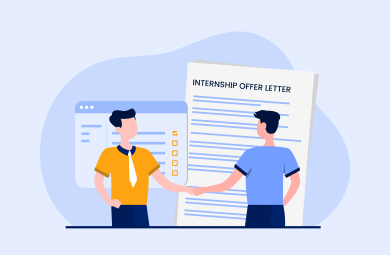
Internship Offer Letter: Sample Letter & Tips to Write
Internships are a great way for students and young professionals to gain practical experience, develop skills, and implement the theoretical knowledge they have learned. However, before commencing an internship, the

How to Write an Offer Letter?: A Comprehensive Guide
An offer letter is a document that outlines the details, and terms and conditions of employment. It creates an official record of the job offer made to the prospective employee.

Auditor Appointment Letter: A Comprehensive Guide with Must-Have Elements
An auditor appointment letter is a crucial document that formally outlines the terms and conditions of employing an auditor in your organization. It serves as a legal agreement between the

Civil Engineer Appointment Letter: A Comprehensive Guide
An appointment letter is a crucial document that confirms an individual’s employment with an organization. It serves as a formal agreement between the employer and the new employee by outlining

Purdue Online Writing Lab Purdue OWL® College of Liberal Arts
Welcome to the Purdue Online Writing Lab

Welcome to the Purdue OWL
This page is brought to you by the OWL at Purdue University. When printing this page, you must include the entire legal notice.
Copyright ©1995-2018 by The Writing Lab & The OWL at Purdue and Purdue University. All rights reserved. This material may not be published, reproduced, broadcast, rewritten, or redistributed without permission. Use of this site constitutes acceptance of our terms and conditions of fair use.
The Online Writing Lab at Purdue University houses writing resources and instructional material, and we provide these as a free service of the Writing Lab at Purdue. Students, members of the community, and users worldwide will find information to assist with many writing projects. Teachers and trainers may use this material for in-class and out-of-class instruction.
The Purdue On-Campus Writing Lab and Purdue Online Writing Lab assist clients in their development as writers—no matter what their skill level—with on-campus consultations, online participation, and community engagement. The Purdue Writing Lab serves the Purdue, West Lafayette, campus and coordinates with local literacy initiatives. The Purdue OWL offers global support through online reference materials and services.
A Message From the Assistant Director of Content Development
The Purdue OWL® is committed to supporting students, instructors, and writers by offering a wide range of resources that are developed and revised with them in mind. To do this, the OWL team is always exploring possibilties for a better design, allowing accessibility and user experience to guide our process. As the OWL undergoes some changes, we welcome your feedback and suggestions by email at any time.
Please don't hesitate to contact us via our contact page if you have any questions or comments.
All the best,
Social Media
Facebook twitter.

Wells College has announced a closure plan.

It is with profound sadness that we announce the forthcoming closure of our beloved Wells College at the end of this academic semester.
As trustees, we have a fiduciary responsibility to the institution; we have determined after a thorough review that the College does not have adequate financial resources to continue. As you may be aware, many small colleges like Wells have faced enormous financial challenges. These challenges have been exacerbated by a global pandemic, a shrinking pool of undergraduate students nationwide, inflationary pressures, and an overall negative sentiment towards higher education.
Members of the board, many of whom are Wells graduates, have spent years trying to find creative solutions to raise revenues in hopes of avoiding closure, including most recently having conversations with other academic partners. We acknowledge the work from all board members and college leaders, especially members of the Cabinet, our faculty, staff, and graduates on creating strategic plans, sponsoring aggressive fundraising campaigns, launching innovative new programs and managing our resources with care. Your efforts are appreciated more than you know. But revenues, unfortunately, are not projected to be sufficient for Wells’ long-term financial stability.
The Board is committed to the legacy and educational mission of Wells College. As such, we have entered into an agreement with Manhattanville University where it will become our legacy and teach-out partner. This partnership further will help ensure that Wells’ current students matriculate, and our institutional mission and legacy continue. Manhattanville is developing dedicated housing for Wells students and will be partners in supporting our students with transfer plans. Manhattanville has also expressed interest in developing a legacy agreement that would integrate the Wells College name and history into the Manhattanville community.
In the coming hours and days, you will have questions, some of which can be answered immediately. We have created a website which lists additional information. We will continue to update this website and communicate with our stakeholders as we finalize plans for the closure of Wells.
The Board thanks all of our alumnae/alumni and friends who have supported the institution since its founding in 1868. Your support and generosity have allowed Wells to continue its mission of helping students think critically, reason wisely and act humanely.
Marie Chapman Carroll, ‘75, Board Chair Jonathan Gibralter, President
News and Updates
Teach-out videos posted, upcoming events, manhattanville university named teach-out and legacy partner for wells college.
- Next »
Resources for the Community
Questions and answers.
Wells College faces significant financial challenges. We conducted a comprehensive review of the institution’s financial health and future sustainability, including an independent analysis, which has led to the necessary conclusion of closure. Many small colleges, like Wells, grapple with enormous financial challenges and the pandemic has exacerbated these issues. This includes a nationwide shrinking pool of undergraduate students, inflationary pressures and negative sentiments towards higher education.
The Board and college leadership have taken decisive actions to address the institution’s financial challenges. This includes creating and executing aggressive strategic plans with faculty, staff, and graduates; streamlining the academic programs; seeking donor support; selling non-essential properties; introducing new revenue-bearing options such as workforce and educational partnerships and online learning for graduates; and implementing new marketing and recruitment initiatives and strategies. While some of these initiatives had positive impacts, the sum of these efforts was insufficient to improve financial projections.
The College saw no likelihood of such significant fundraising goals being achieved year after year, nor the likelihood that new revenues could be identified in sufficient amounts and quickly enough to save the College. Fundraising helps to support the College, but the board recognizes that it cannot carry the College. Wells had already raised its fundraising goal for 2023-2024 above prior years’ achievements. These fundraising goals would have required more than double the goal to make possible, not certain, another year of operation. That doubled goal of approximately $12 million would have had to be sustained for several years unless other revenues could be identified.
The Board’s plan includes a continuing commitment from the Wells College Alumni Association (WCA). Key individuals from the board and the WCA will work together in the coming months to secure the legacy of Wells College and share those opportunities in the future. Wells has selected a legacy partner institution, which will honor and preserve the legacy of the College for years to come.
Determining the future of the college’s campus and other real estate is currently under consideration. The Board will collaborate with village, county, and state attorney general and relevant local associations to make informed decisions.
Wells has selected a legacy institution partner in Manhattanville University. This institution will plan to house various materials including transcripts, business records and other important artifacts.
The board and its advisors have been working diligently to understand all options. Once the board voted to close the College, it is our obligation to communicate with our community in a timely manner. Making the announcement when students are present gives us the best opportunity to provide counseling and support and to make services available in person. Each student will have personal advising to plan for their degree path and the College will communicate directly with students for those advising appointments.
The College will assist students in graduating or continuing their studies elsewhere and outline a clear pathway to earn their degrees. A formal institutional teach-out plan, required by accrediting bodies, will guide the closure to minimize its impact on students. Specific information will be shared with impacted members of our community this week.
Over the next several weeks and months, we will be working with employees to provide them with resources and support as they depart the institution.
We appreciate you reaching out to learn how to share your job openings with our staff. It’s wonderful to hear from the community and the willingness to assist. Wells College is partnering with the Department of Labor to host an on-site Job Fair on Wednesday, May 22. Employers and job placement agencies interested in attending to recruit faculty and staff should complete a registration form . Please email [email protected] for further questions. We appreciate your understanding as we work out these details. We also encourage you to reach out to our employees to share job opportunities. You’ll find the names, job titles, and emails of our employees within our campus directory.
The Wells in Florence program is going to be continued by our preferred legacy partner, Manhattanville University. Students who are currently enrolled or were planning to enroll in the program will receive specific follow up information.
College officials are working with the New York Attorney General to determine next steps for the property.
See all FAQs
Contact Wells College
Think critically, reason wisely, and act humanely..
Our mission since 1868.
Health Science Center
What Can we help you find?
Popular Searches
- Academic Calendar
- Study Abroad
- Majors & Minors
- Request Info

UT Tyler Health Science Center
Build a healthier tomorrow.
Home to the region’s only academic medical center, The University of Texas at Tyler Health Science Center is one of the five campuses of UT Tyler. Two of UT Tyler’s four health-related schools have a presence on this campus: the School of Health Professions and the School of Medicine.
Campus History

Our Beginnings

Joining the University of Texas System

A Name Change

New Programs

Campus Programs and Facilities
The UT Tyler Health Science Center facility offers an array of crucial medical and healthcare education resources, fostering an environment dedicated to excellence in education. From cutting-edge simulation labs to dedicated research spaces, every aspect of the UT Tyler Health Science Center is designed to enhance the educational experience. This dynamic campus is not just a hub for learning; it’s a catalyst for progress in healthcare education and a testament to UT Tyler's commitment to shaping the future of healthcare in the East Texas region.

Office of Health Affairs

School of Health Professions

School of Medicine
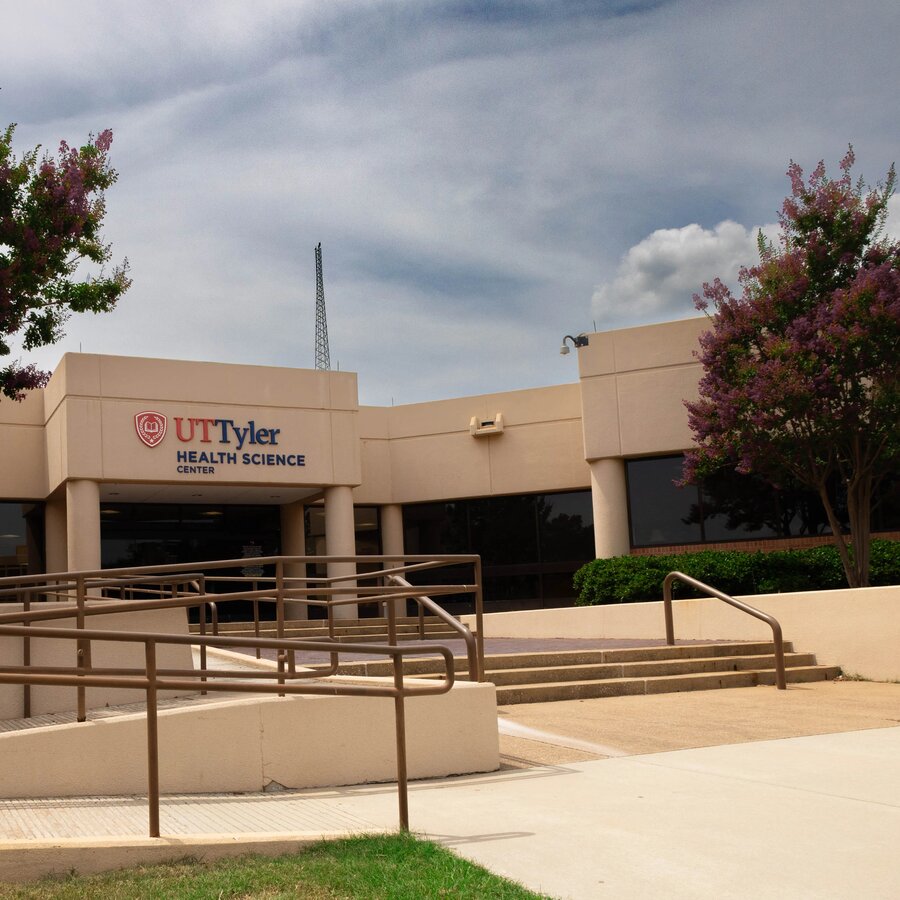
Center for Biomedical Research

Simulation in Medicine and Immersive Learning Experience Center

Watson W. Wise Medical Research Library

Public Health Laboratory of East Texas

UT Health North Campus Tyler (UTHET)

HOPE Cancer Center

A Regional Leader in Health Research
UT Tyler pioneers solutions to improve health. Several research centers, including the Center for Mycobacterial Treatment and Discovery and the Center for Biomedical Research, are housed on this campus. The centers build on our history of innovative treatments for lung disease and focus on the health concerns of rural populations through projects funded by agencies like the National Institutes of Health and the Centers for Disease Control and Prevention. Students benefit from hands-on research opportunities and instruction informed by the latest developments in the field.

Dr. Maolin Lu
Assistant Professor of Cellular and Molecular Biology
Meet Professor Lu
Community Outreach and Engagement
Ut health east texas.
In its regional network of hospitals, clinics and other facilities, UT Health East Texas delivers world-class care to thousands of patients each year while conducting clinical trials and training the next generation of professionals through UT Tyler’s unique programs. The UT Tyler Health Science Center is home to UT Health North Campus Tyler .
Public Health Programs
Faculty, staff and students at the UT Tyler Health Science Center campus connect their expertise with local community needs to assist traditionally underserved populations through an array of health and outreach programs, including behavioral health telemedicine services for rural populations, cancer screenings, parental education, lifestyle changes and more.
Pollen and Mold Count
UT Tyler's Health Science Center provides a daily pollen and mold count as a resource to the community. See today's counts as well as prior counts.
Connect With Us
The university of texas at tyler health science center.
Phone: 903.877.7777
We’re pioneering the future of healthcare in East Texas. Find out how you can join us.
11937 U.S. Hwy. 271 Tyler, TX 75708-3154
TechRepublic

8 Best Data Science Tools and Software
Apache Spark and Hadoop, Microsoft Power BI, Jupyter Notebook and Alteryx are among the top data science tools for finding business insights. Compare their features, pros and cons.

EU’s AI Act: Europe’s New Rules for Artificial Intelligence
Europe's AI legislation, adopted March 13, attempts to strike a tricky balance between promoting innovation and protecting citizens' rights.

10 Best Predictive Analytics Tools and Software for 2024
Tableau, TIBCO Data Science, IBM and Sisense are among the best software for predictive analytics. Explore their features, pricing, pros and cons to find the best option for your organization.

Tableau Review: Features, Pricing, Pros and Cons
Tableau has three pricing tiers that cater to all kinds of data teams, with capabilities like accelerators and real-time analytics. And if Tableau doesn’t meet your needs, it has a few alternatives worth noting.

Top 6 Enterprise Data Storage Solutions for 2024
Amazon, IDrive, IBM, Google, NetApp and Wasabi offer some of the top enterprise data storage solutions. Explore their features and benefits, and find the right solution for your organization's needs.
Latest Articles

Combatting Deepfakes in Australia: Content Credentials is the Start
The production of deepfakes is accelerating at more than 1,500% in Australia, forcing organisations to create and adopt standards like Content Credentials.

The Top 5 Pipedrive Alternatives for 2024
Discover the top alternatives to Pipedrive. Explore a curated list of CRM platforms with similar features, pricing and pros and cons to find the best fit for your business.

The Australian Government’s Manufacturing Objectives Rely on IT Capabilities
The intent of the Future Made in Australia Act is to build manufacturing capabilities across all sectors, which will likely lead to more demand for IT skills and services.

Udemy Report: Which IT Skills Are Most in Demand in Q1 2024?
Informatica PowerCenter, Microsoft Playwright and Oracle Database SQL top Udemy’s list of most popular tech courses.

Gartner: 4 Bleeding-Edge Technologies in Australia
Gartner recently identified emerging tech that will impact enterprise leaders in APAC. Here’s what IT leaders in Australia need to know about these innovative technologies.

Llama 3 Cheat Sheet: A Complete Guide for 2024
Learn how to access Meta’s new AI model Llama 3, which sets itself apart by being open to use under a license agreement.
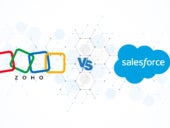
Zoho vs Salesforce (2024): Which CRM Is Better?
Look at Zoho CRM and Salesforce side-by-side to compare the cost per functionality and top pros and of each provider to determine which is better for your business needs.

9 Innovative Use Cases of AI in Australian Businesses in 2024
Australian businesses are beginning to effectively grapple with AI and build solutions specific to their needs. Here are notable use cases of businesses using AI.

How Are APAC Tech Salaries Faring in 2024?
The year 2024 is bringing a return to stable tech salary growth in APAC, with AI and data jobs leading the way. This follows downward salary pressure in 2023, after steep increases in previous years.

Anthropic Releases Claude Team Enterprise AI Plan and iOS App
The enterprise plan seeks to fill a need for generative AI tools for small and medium businesses. Plus, a Claude app is now on iOS.

Top Tech Conferences & Events to Add to Your Calendar in 2024
A great way to stay current with the latest technology trends and innovations is by attending conferences. Read and bookmark our 2024 tech events guide.

TechRepublic Premium Editorial Calendar: Policies, Checklists, Hiring Kits and Glossaries for Download
TechRepublic Premium content helps you solve your toughest IT issues and jump-start your career or next project.

IBM Acquires HashiCorp for $6.4 Billion, Expanding Hybrid Cloud Offerings
The deal is intended to strengthen IBM’s hybrid and multicloud offerings and generative AI deployment.
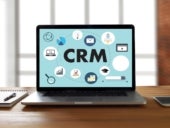
6 Best Enterprise CRM Software for 2024
Freshsales, Zoho CRM and Pipedrive are among the top enterprise CRM software that organize and automate data workflows to help achieve businesses’ client management goals in 2024.

8 Best Free Alternatives to Microsoft Excel
Discover the best free alternatives to Microsoft Excel: powerful, feature-packed solutions that help you work smarter and faster by allowing you to create comprehensive spreadsheets and analyze data.
Create a TechRepublic Account
Get the web's best business technology news, tutorials, reviews, trends, and analysis—in your inbox. Let's start with the basics.
* - indicates required fields
Sign in to TechRepublic
Lost your password? Request a new password
Reset Password
Please enter your email adress. You will receive an email message with instructions on how to reset your password.
Check your email for a password reset link. If you didn't receive an email don't forgot to check your spam folder, otherwise contact support .
Welcome. Tell us a little bit about you.
This will help us provide you with customized content.
Want to receive more TechRepublic news?
You're all set.
Thanks for signing up! Keep an eye out for a confirmation email from our team. To ensure any newsletters you subscribed to hit your inbox, make sure to add [email protected] to your contacts list.

IMAGES
VIDEO
COMMENTS
Without such a plan in place, your workers will feel unprepared and won't know how to work towards your company's overall goals. Steps for Developing a Human Resources Department Business Plan. There are several steps to creating an HR business plan. They include: Clarify the requirements. While you might be tempted to create a detailed plan ...
Management and Human Resources Business Plans. By. Daniel Richards. Updated on September 13, 2022. Fact checked by J.R. Duren. In This Article. Photo: Georgijevic / Getty Images. A business plan should include plans for your company's management and human resources departments. Learn what each section should include and how to write them.
Learn how to create a human resources (HR) plan that evaluates your workforce needs, forecasts labor requirements, and aligns with your budget and objectives. Find out how to use templates to customize your plan and communicate it to your team.
Learn how to plan human resources strategically and tactically to meet business objectives and respond to changes in the external environment. Find out what is human resource planning, why it's important, how to do it, and see examples from Starbucks, Deloitte, and other experts.
To drive HR strategic planning and any HR transformation initiatives, follow these five steps to create an effective human resources strategy that supports enterprise business goals:. Understand your organization's mission, strategy and business goals.; Identify the critical capabilities and skills.; Evaluate the current capabilities and skills of your talent and the HR function, and ...
By aligning HR programs and policies with the company's business strategy, SHRM can help businesses improve employee performance, develop the workforce and create a positive work environment ...
Evaluate and adapt compensation and benefits programs to be more competitive. 5. Create the document layout and design. There's no point in preparing an HR strategic plan if it's not accessible and engaging. The key to getting people to read and absorb the plan is to present the information clearly and concisely.
Following this, the first step in the HR action plan 2024, is to assign a person who will be in charge of creating and implementing the HR plan. For smaller companies, this person will probably be the CEO. In slightly larger businesses, the person responsible is normally the same one who handles all of the human resources-related tasks.
The importance of a human resources plan . A company human resources plan is essential if the staff and organisation are to operate effectively. This document is also key to achieving a company's business objectives. It also serves to: Promote flexibility within the organisation: we are living in a constantly changing world. Effective ...
HR strategic plan. An HR strategic plan is a tool to help businesses align their HR capabilities with their organizational goals. It establishes how human resources can make a direct impact on a company's growth. Our HR strategic plan will assess the needs of your organization.
Free HR Business Plan Template. Every success story starts with a plan. Using this template, you can help flesh out a business plan for your HR function with: Best practices for HR business partnerships. A helpful template to realise your people team's goals. Tangible ways to action and activate an HR strategy.
Human Resource Planning - HRP: Human resource planning, or HRP, is the ongoing, continuous process of systematic planning to achieve optimum use of an organization's most valuable asset — its ...
Traditionally, a marketing plan includes the four P's: Product, Price, Place, and Promotion. For an human resource consulting business, your marketing plan should include the following: Product: In the product section, you should reiterate the type of HR consulting company that you documented in your Company Analysis.
What Is a HR Business Plan? A HR business plan is a targeted and comprehensive plan that is geared towards achieving an organization's human resource objectives. The broader plan may cover the more specific areas of HR. According to an article published by the University of Minnesota, a Human Resource Management (HRM) strategic plan must consist of six main parts.
Human Capital Maximizers (HCM) is a human resource consulting company located in Portland, Oregon. HCM has expertise in a wide range of HR areas and is targeting the emerging company market. HCM will offer this market the ability to compensate client's employees with stock options from their company. This will be especially appealing to many ...
A human resource business plan will develop these points into a coherent strategy. Get Started Hiring Now. Post A Job. Steps To Develop A HR Business Plan. Assess current human resource situation. Before a plan is made, the human resources department and the company executives need to know what they have already. Your company should evaluate ...
Describe the steps in the development of an HRM plan. As addressed in Section 2.1 "Strategic Planning", the writing of an HRM strategic plan should be based on the strategic plans of the organization and of the department. Once the strategic plan is written, the HR professional can begin work on the HR plan. This is different from the ...
In today's rapidly evolving business landscape, having a plan in place for managing your human capital is key — and that's where human resource planning (HRP) comes in. Human resource planning plays a critical role in making sure that your organization is well-equipped with the right talent at the right time.
Before we delve into the minutiae of human resources, let's put the two relevant definitions side-by-side to see how they compare.. Human Resource Planning: HRP is the ongoing process of systematically planning ahead to optimize and maximize your business's most valuable asset — high-quality employees.. Strategic Human Resource Management: SHRM is a holistic approach to assembling the ...
The AHRP is a blueprint for the human resource planning process for the coming year. These are the steps that explain the process of HR planning: 1. Align the HR plan with the overall business strategy. The primary purpose of an HR yearly plan is to meet the company's critical goals. Naturally, it must consider your business objectives, which ...
Human resource planning steps. Here are some of the steps you can take for effective human resource planning: 1. Analyze the company's current employees and their offerings. Analyzing a company's current offerings, staff skills and business goals are essential to planning. This helps you understand what you might need to improve or what works well.
Develop A Human Resource Business Plan - The first step in starting a business is to create a detailed human resource business plan that outlines all aspects of the venture. This should include potential market size and target customers, the services or products you will offer, pricing strategies and a detailed financial forecast.
A human resources (HR) strategy is a comprehensive plan to effectively manage its people assets in alignment with its overall business objectives. The HR strategy framework outlines the principles, goals, and actions that the HR department will undertake to attract, retain, develop, and engage employees to contribute to the company's success.
This might involve training existing employees to take on new roles or hiring new talent to meet evolving business demands. The human resource planning process step by step. ... We've prepared a 7-step guide on how to plan human resources in your company: Environmental analysis. In this initial step, you take a broad look at the outside factors ...
The best HR software for small business owners. The right HR software will help you set up a human resources department. Have a look at our pick of the top three HR solutions for small business ...
HR Strategic Plan: Definition & Importance. A human resources strategic plan is a written document that contains details about the HR strategy for the stakeholders to understand and execute. This plan provides information, such as HR goals, initiatives, and priorities, and aligns them with the business objectives.
The Online Writing Lab at Purdue University houses writing resources and instructional material, and we provide these as a free service of the Writing Lab at Purdue. Students, members of the community, and users worldwide will find information to assist with many writing projects.
The Board and college leadership have taken decisive actions to address the institution's financial challenges. This includes creating and executing aggressive strategic plans with faculty, staff, and graduates; streamlining the academic programs; seeking donor support; selling non-essential properties; introducing new revenue-bearing options such as workforce and educational partnerships ...
The UT Tyler Health Science Center facility offers an array of crucial medical and healthcare education resources, fostering an environment dedicated to excellence in education. From cutting-edge simulation labs to dedicated research spaces, every aspect of the UT Tyler Health Science Center is designed to enhance the educational experience.
Big Data Big Data 8 Best Data Science Tools and Software . Apache Spark and Hadoop, Microsoft Power BI, Jupyter Notebook and Alteryx are among the top data science tools for finding business insights.